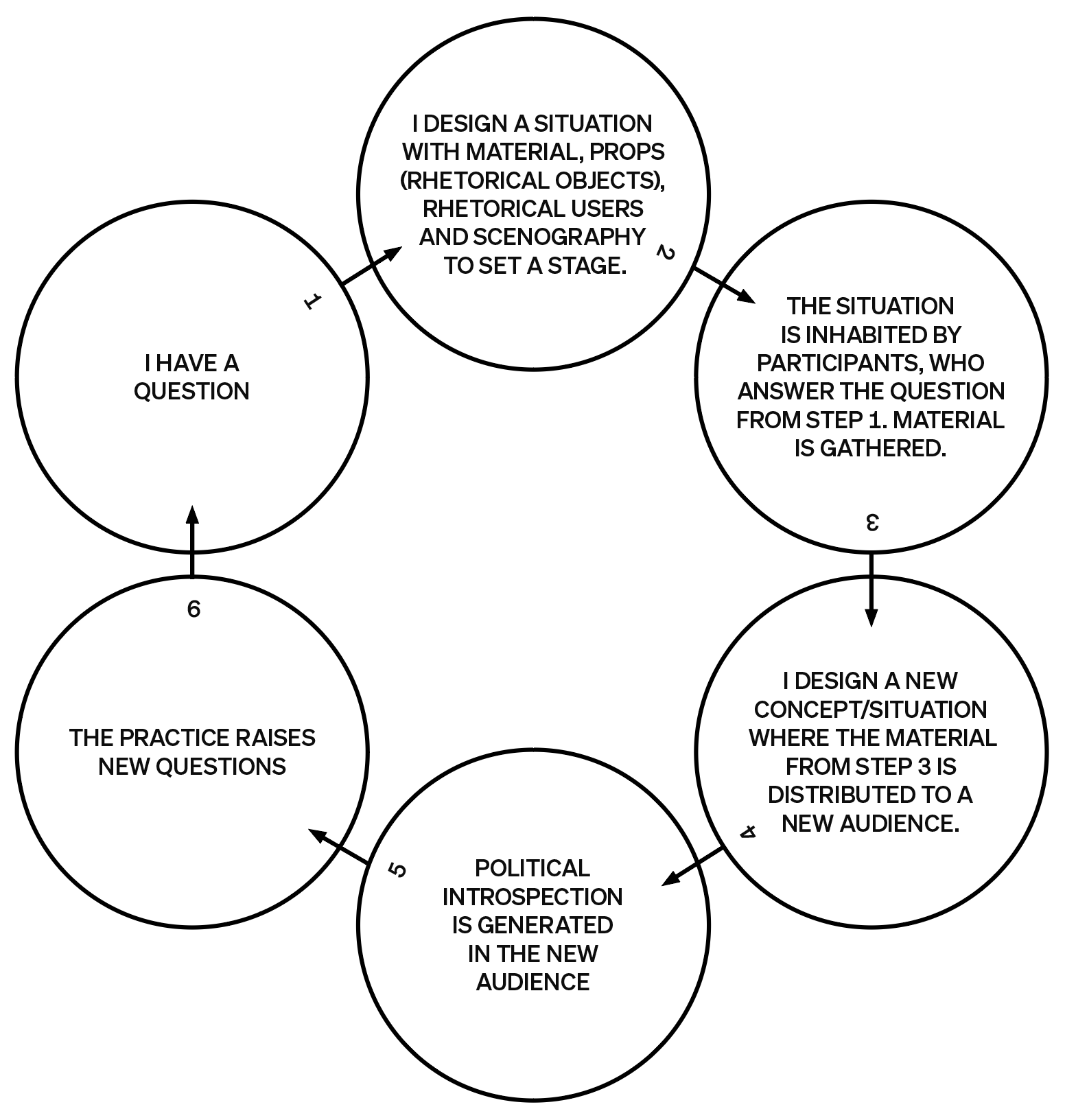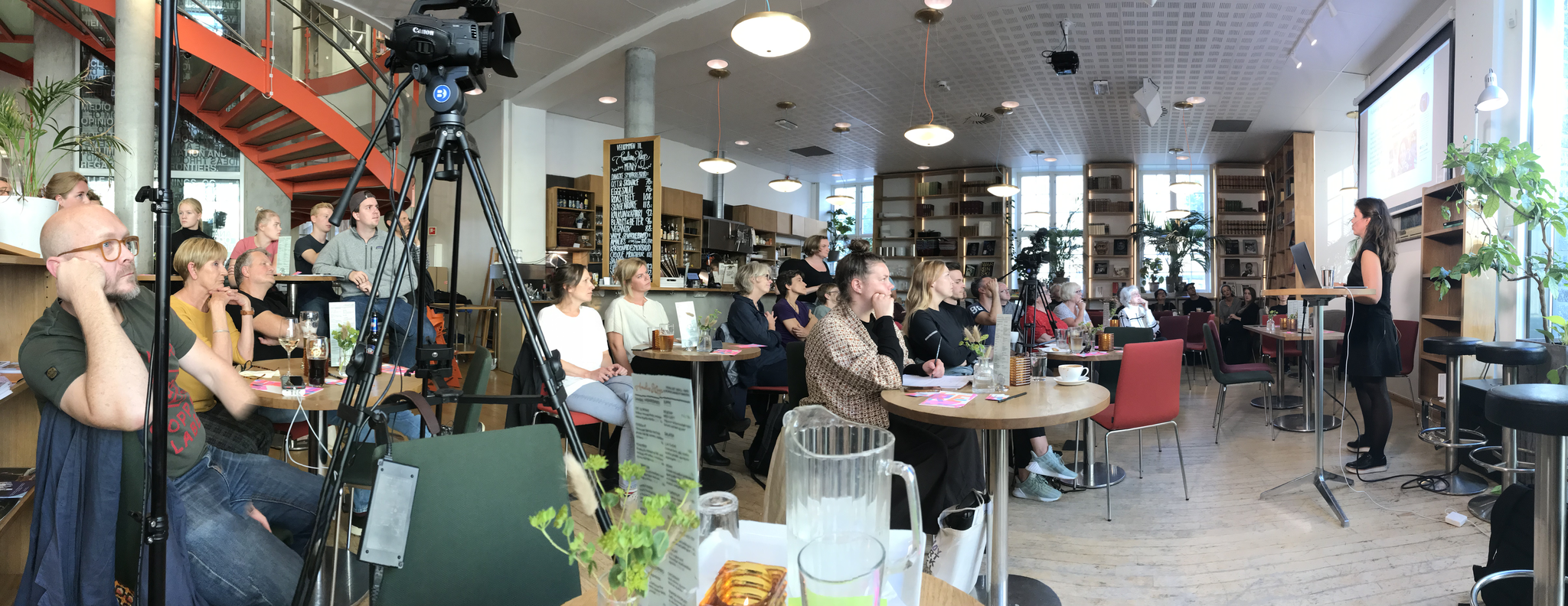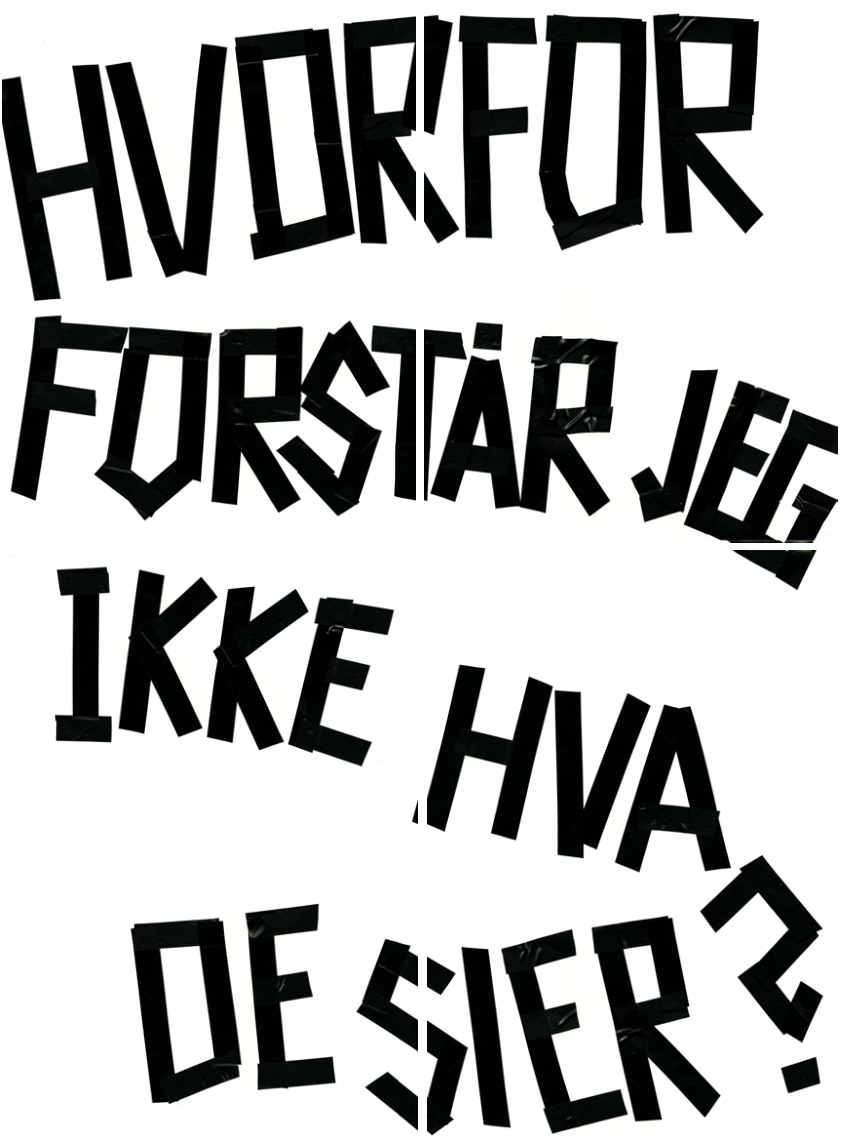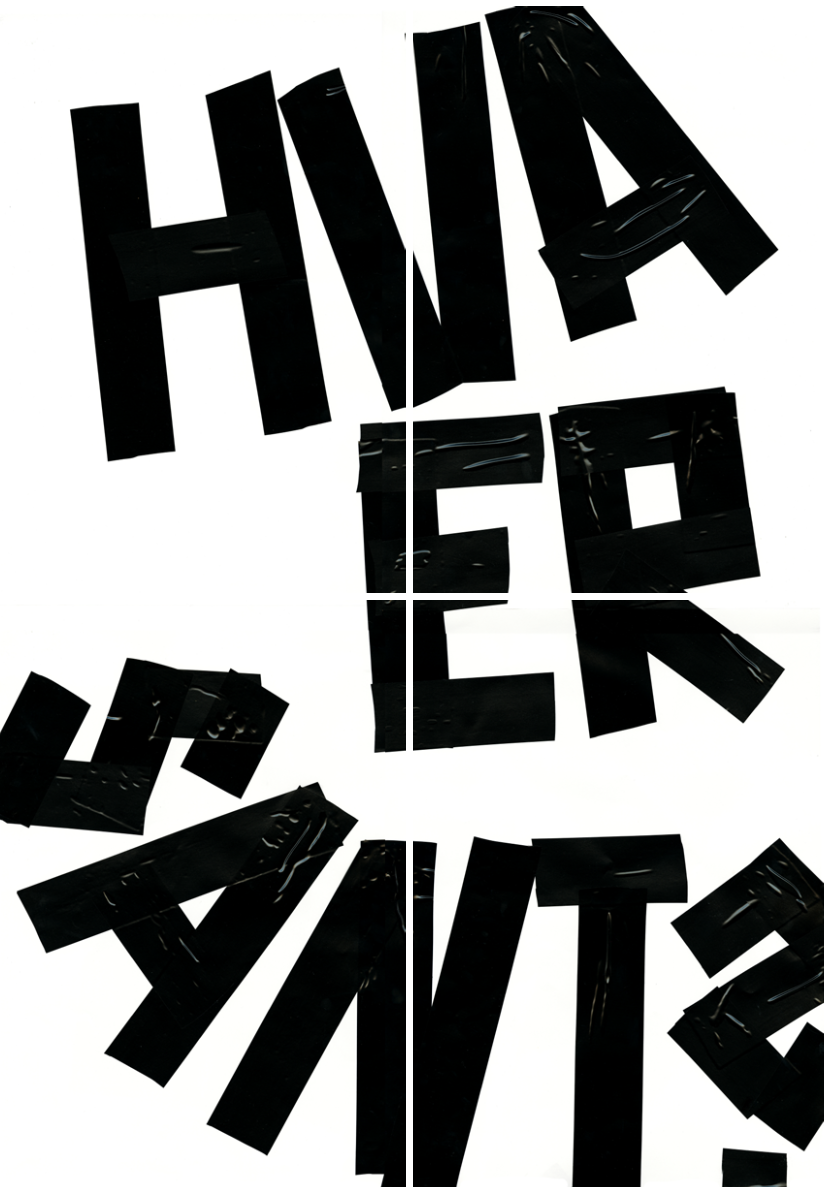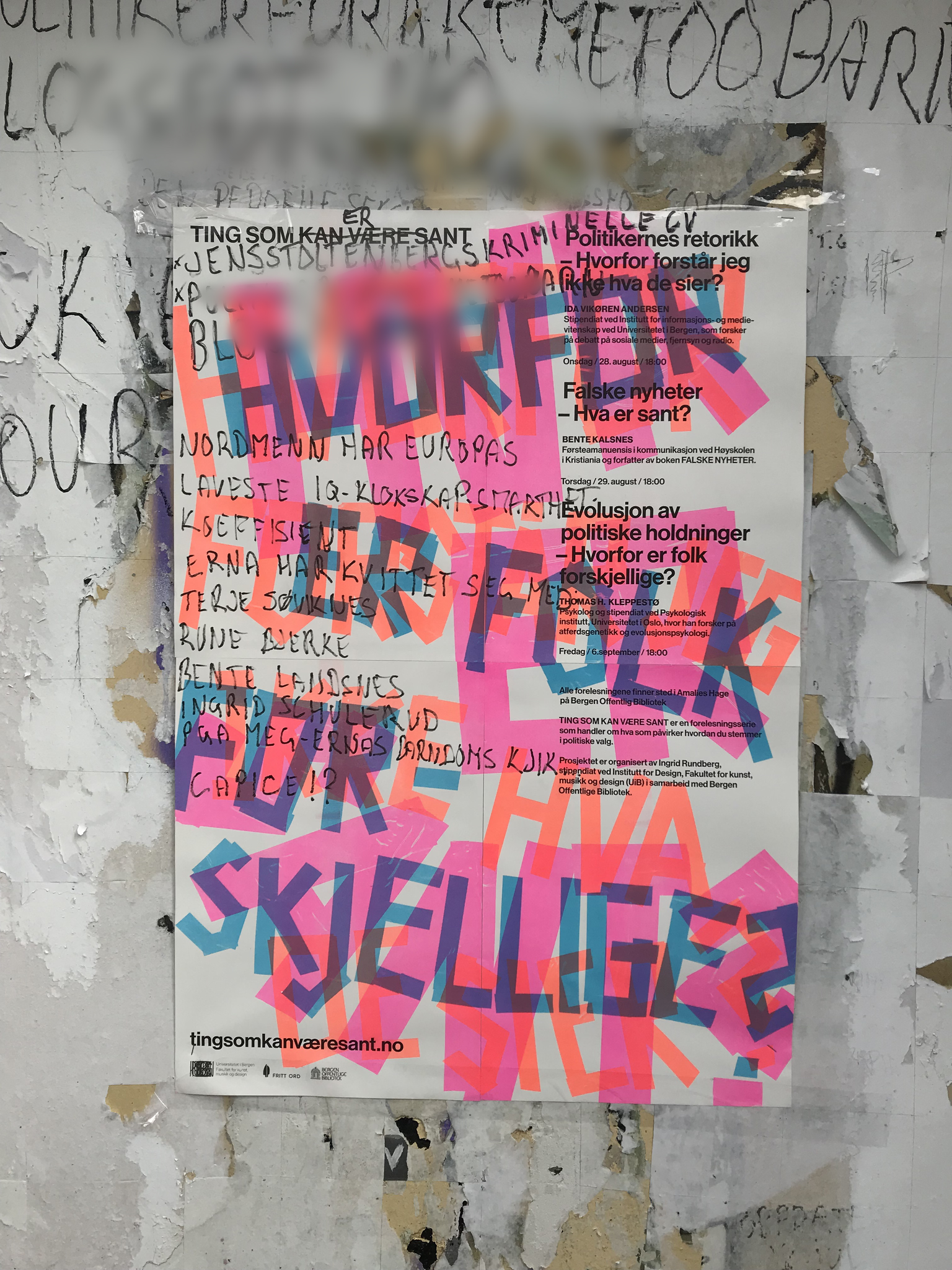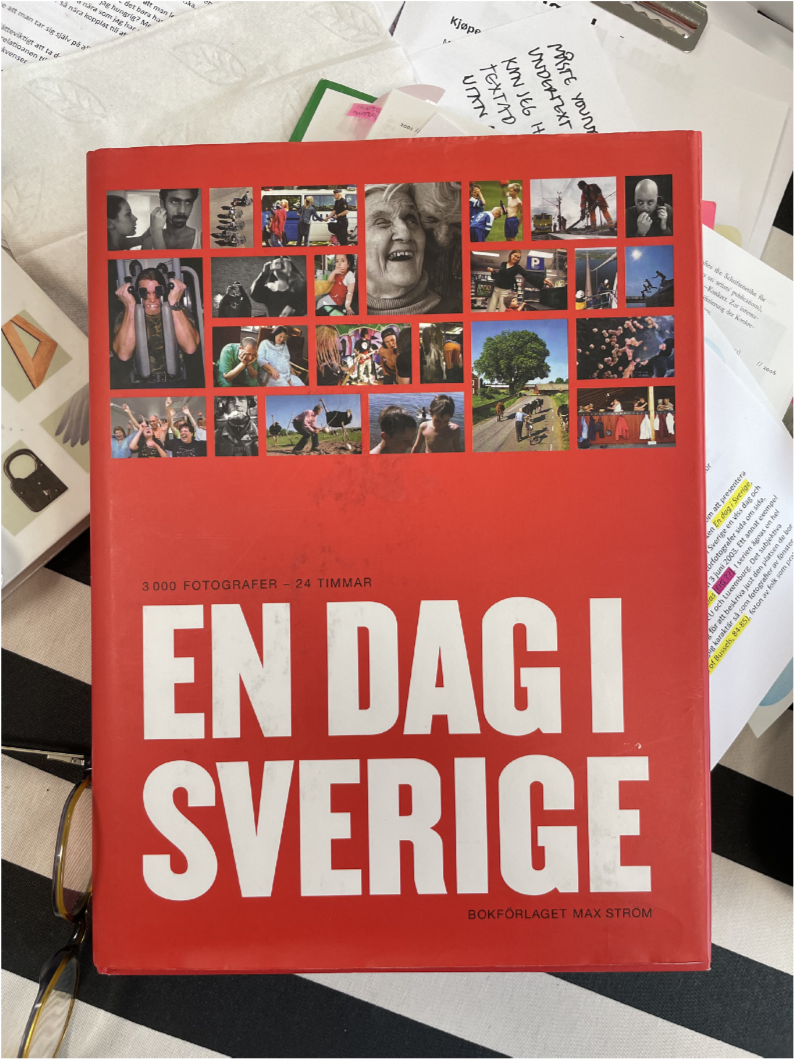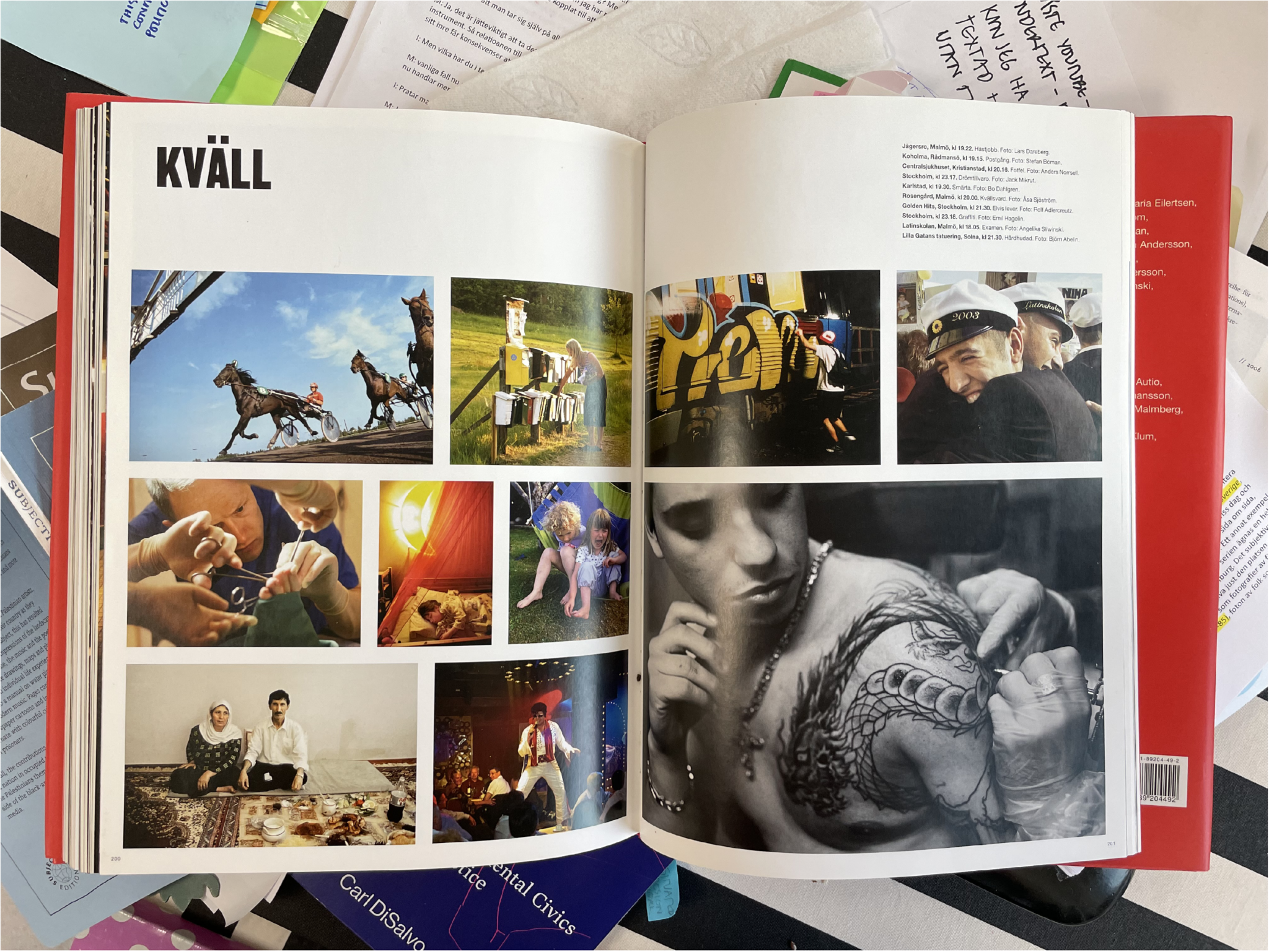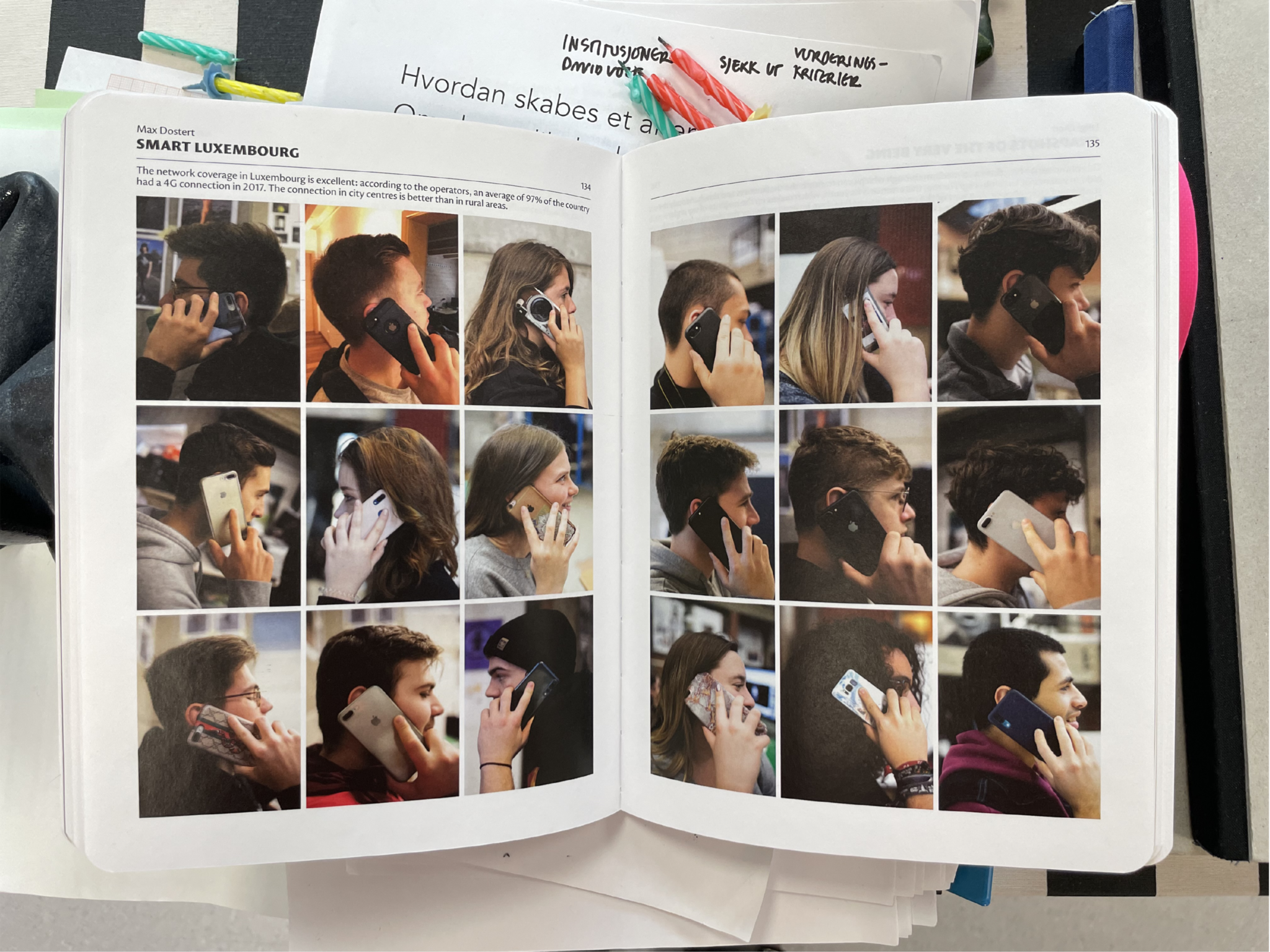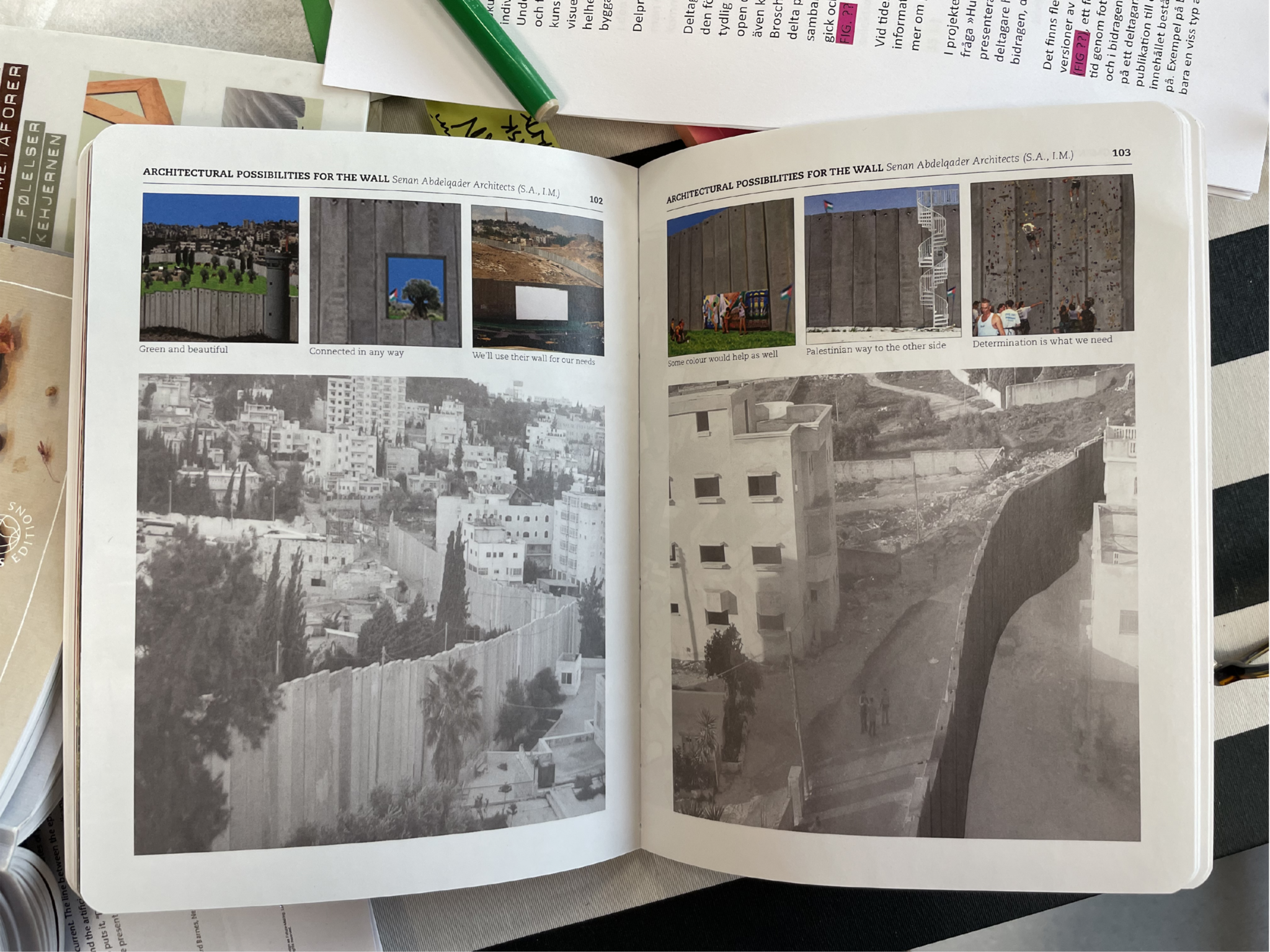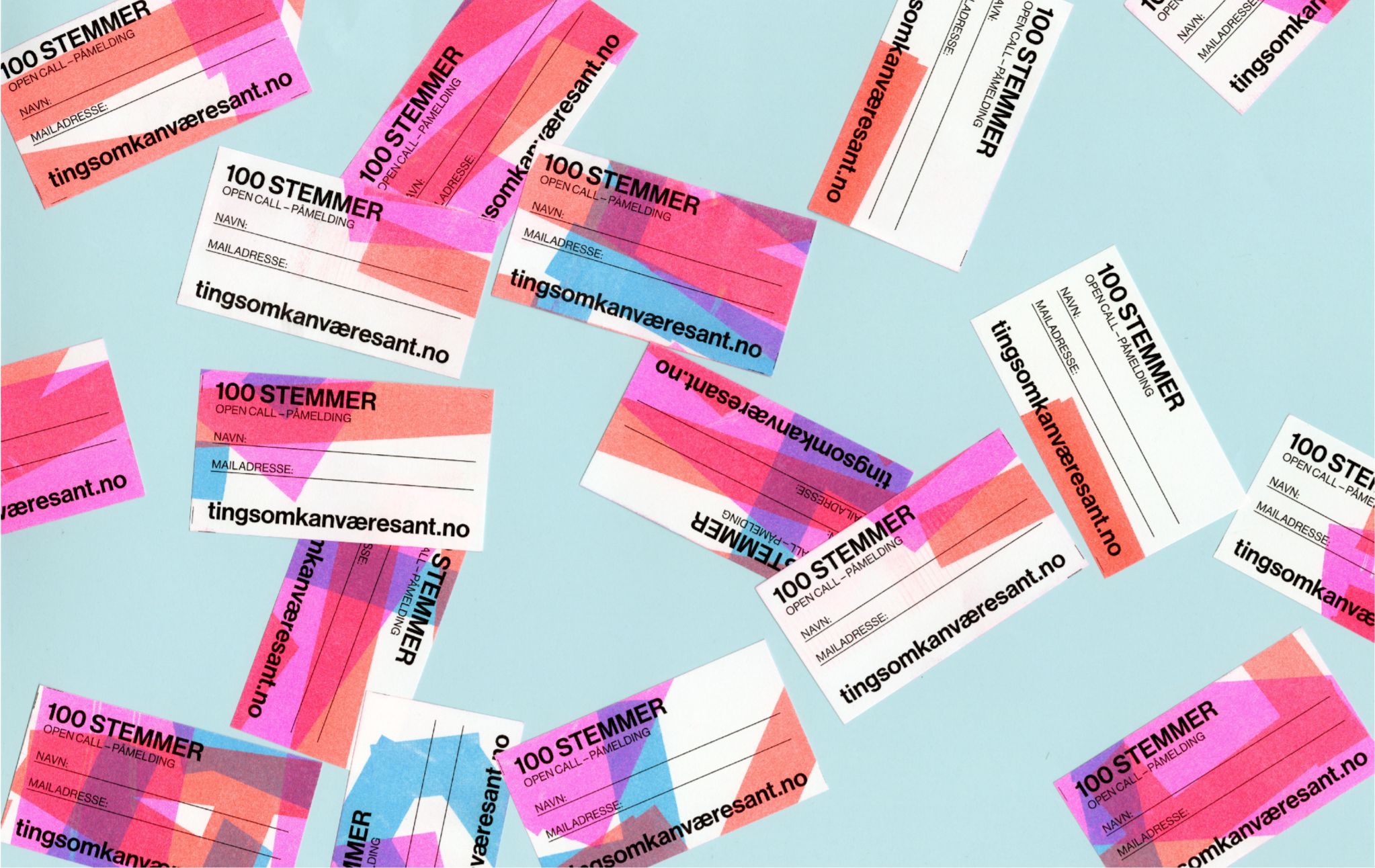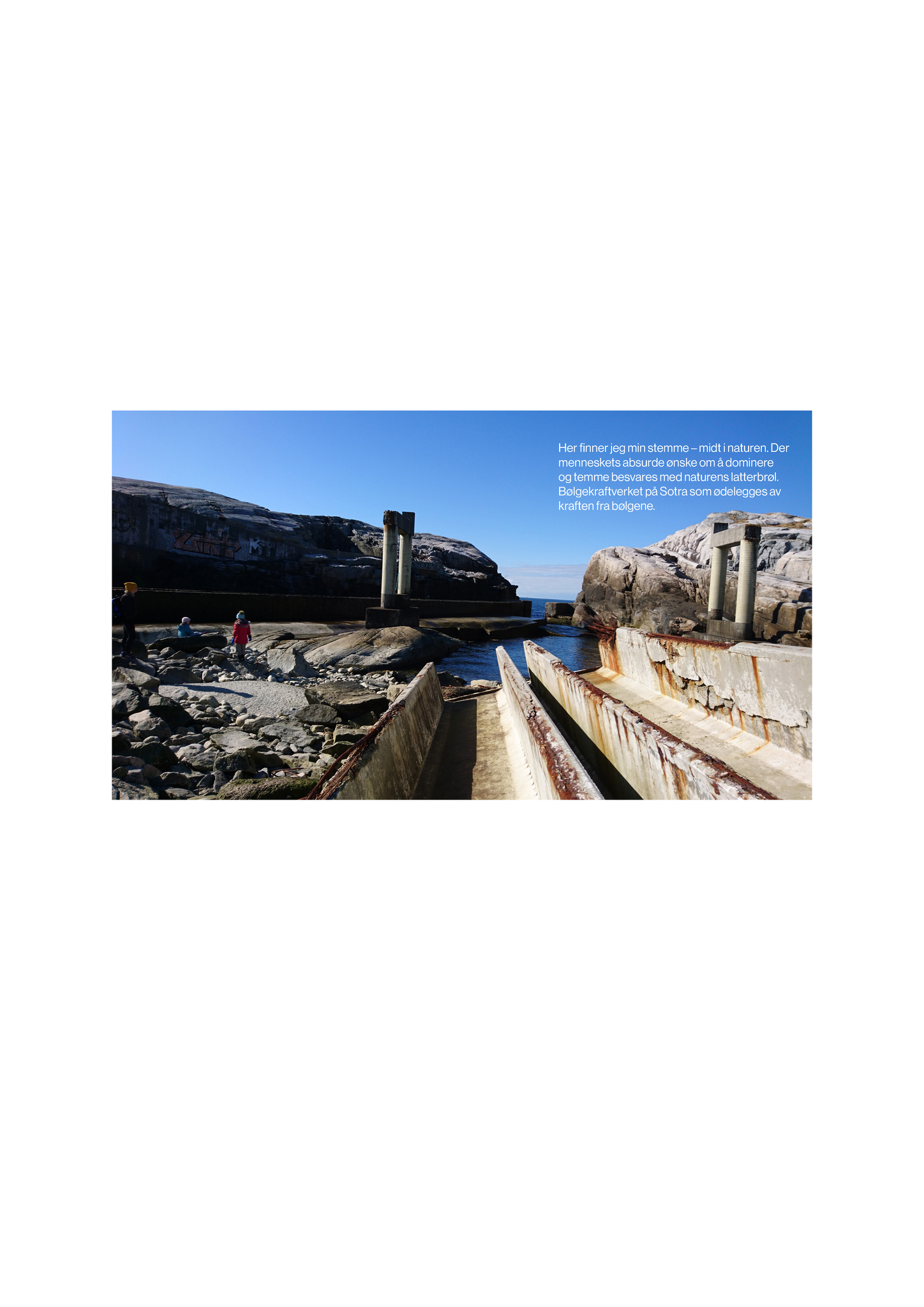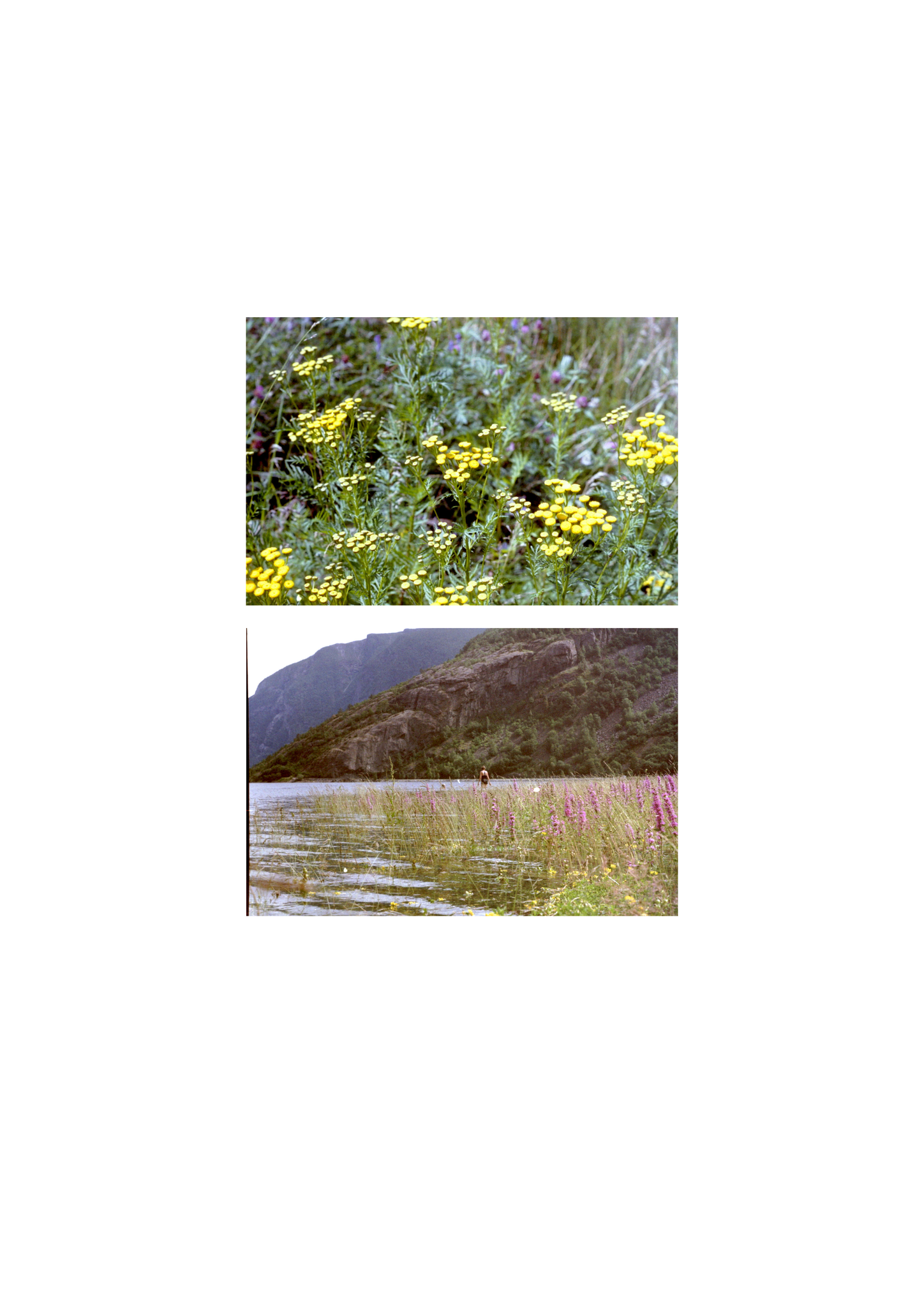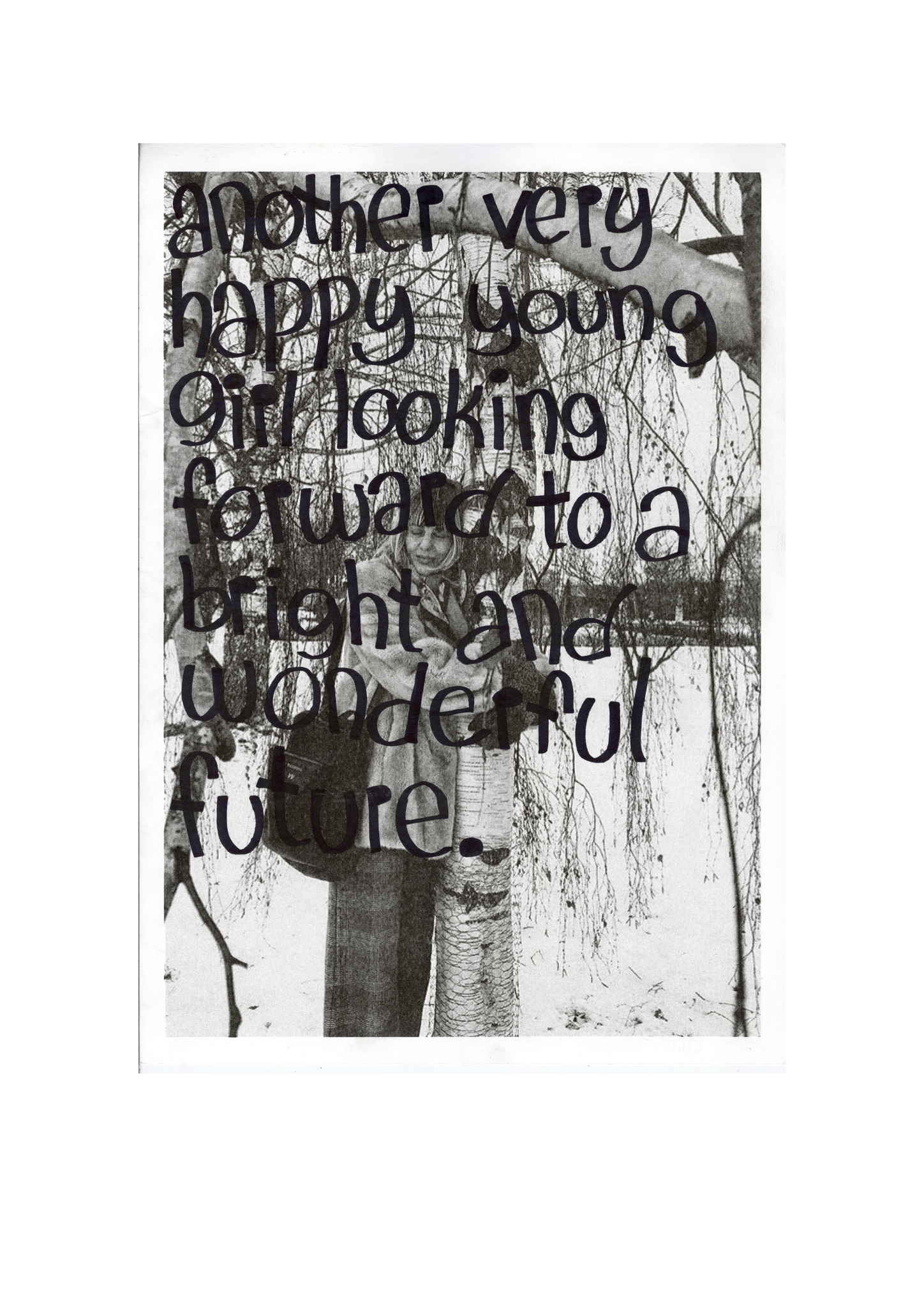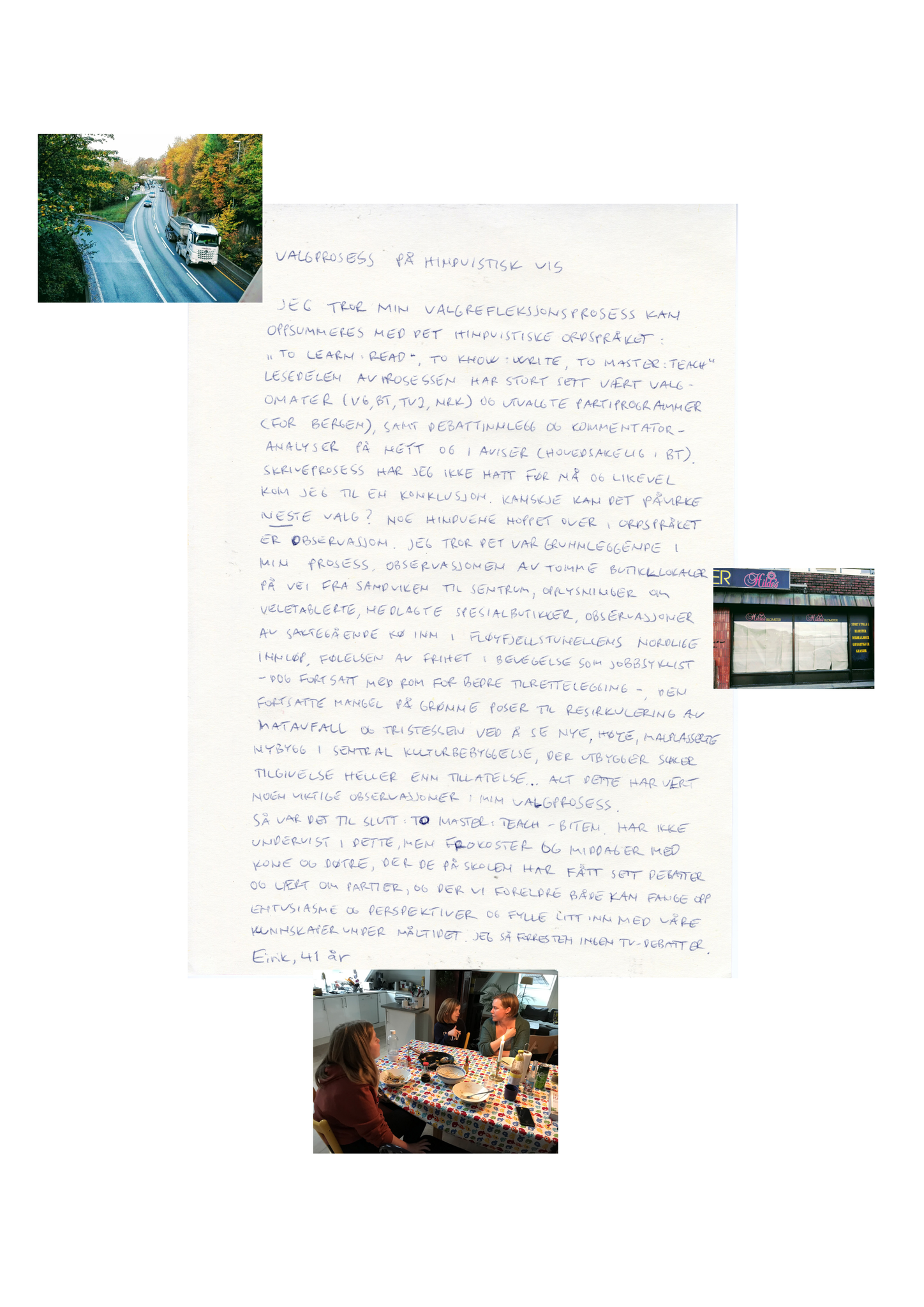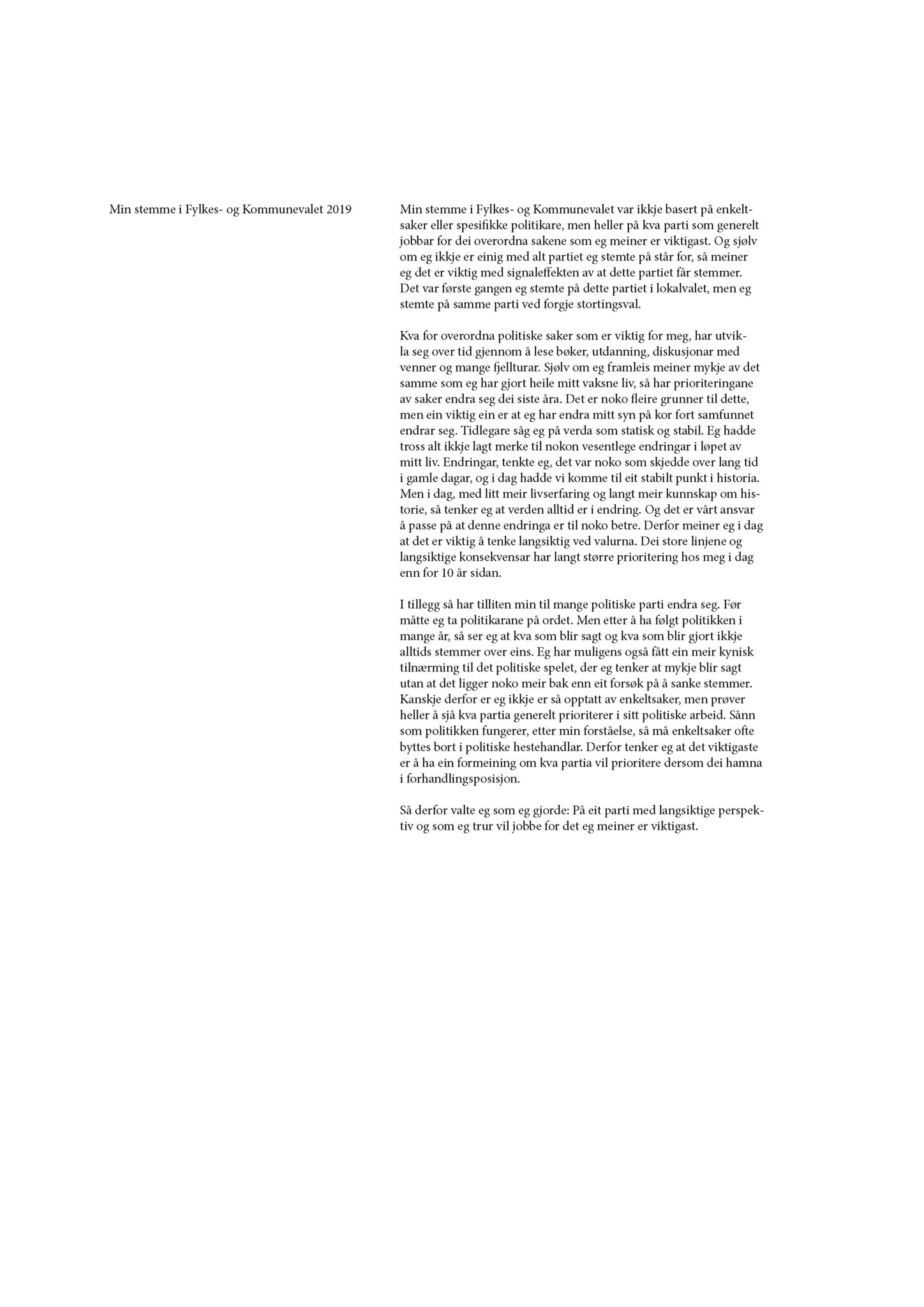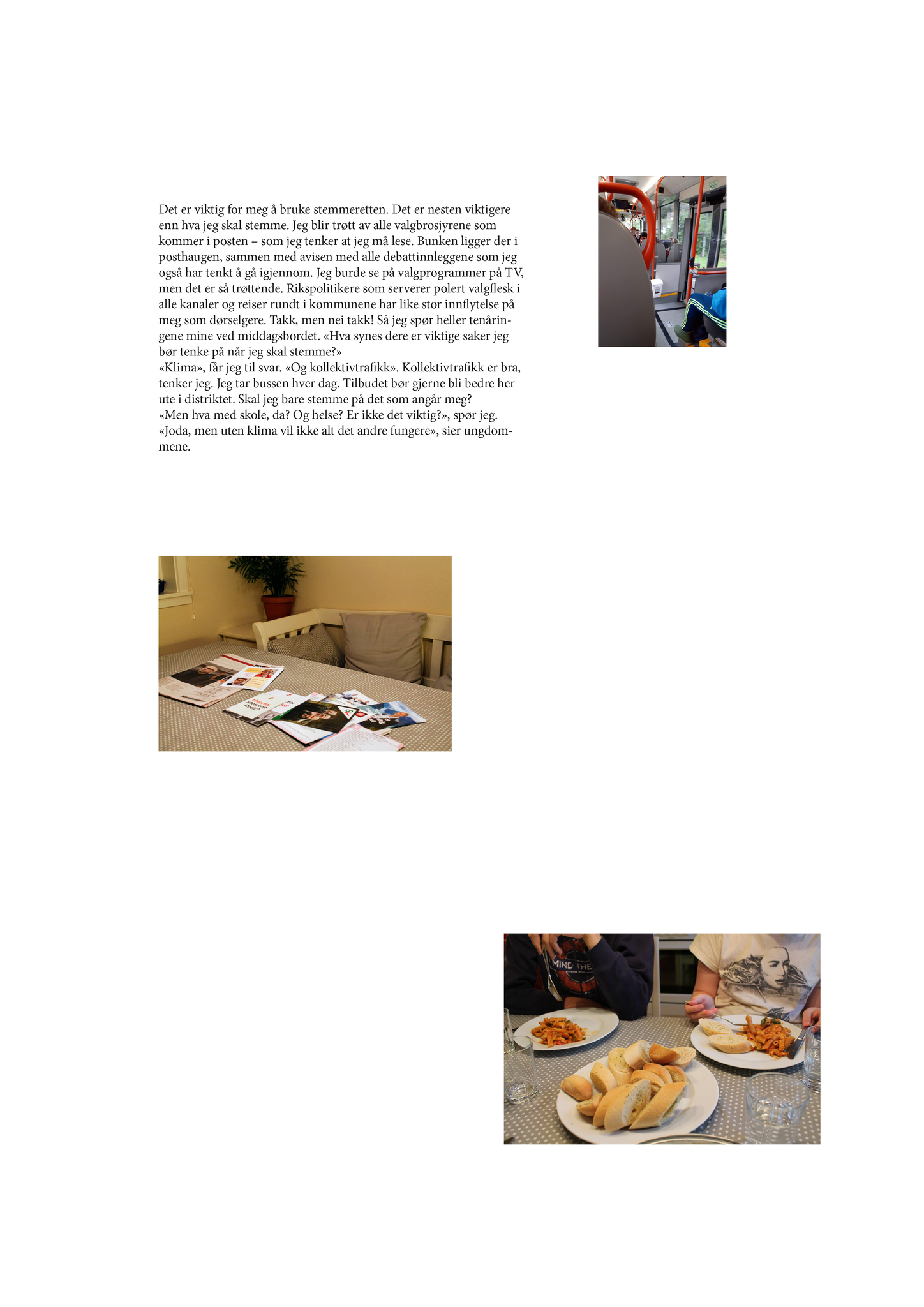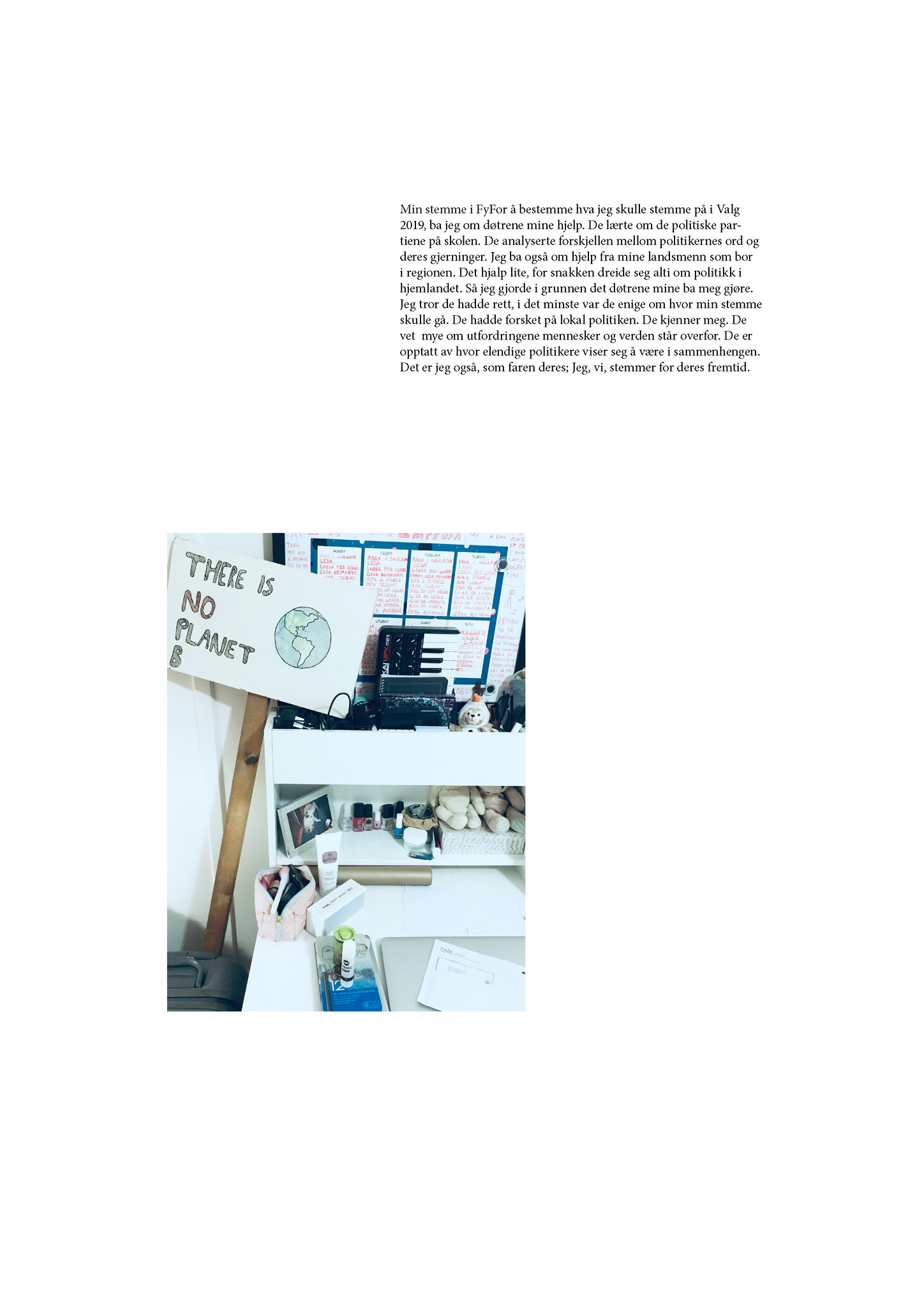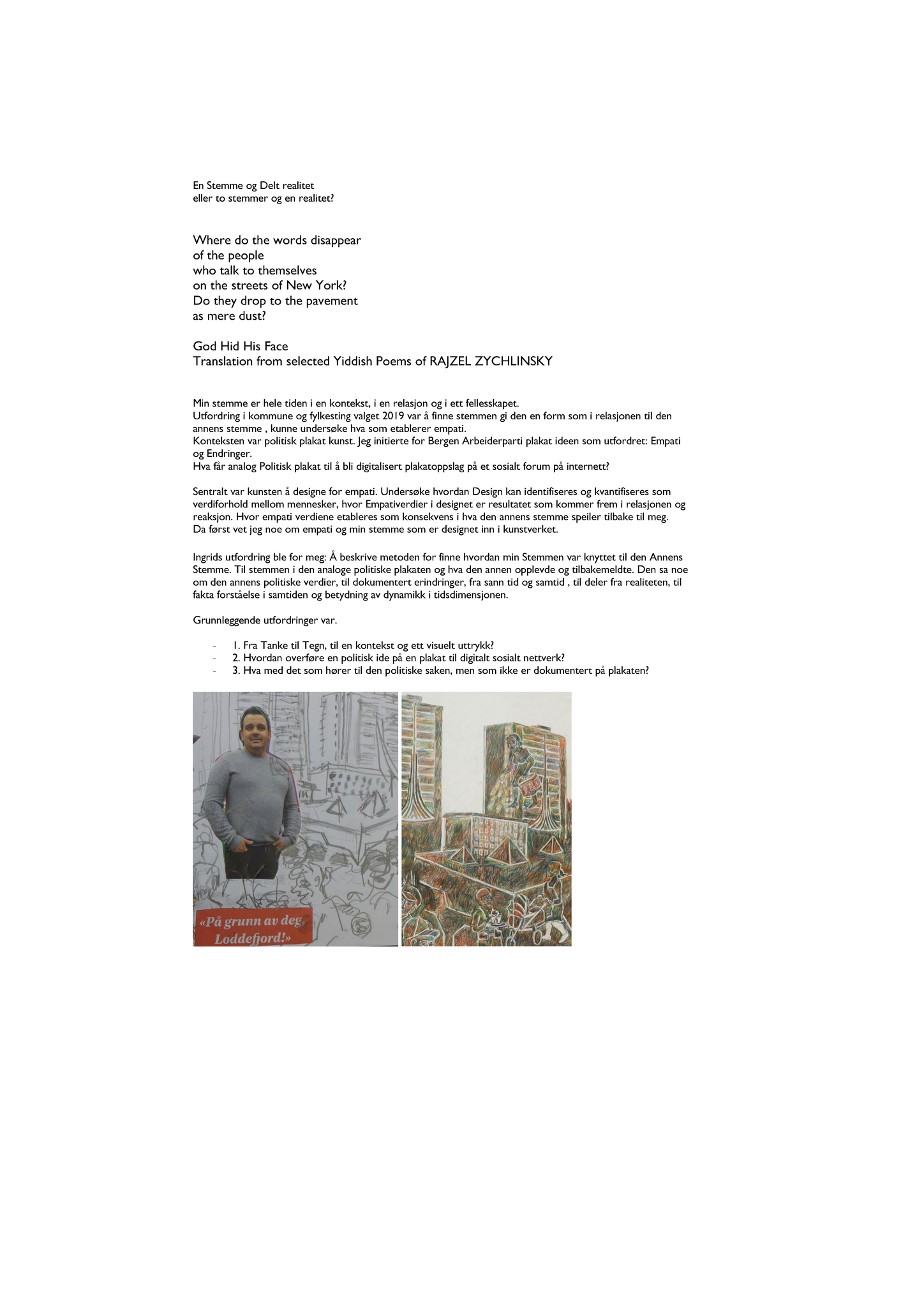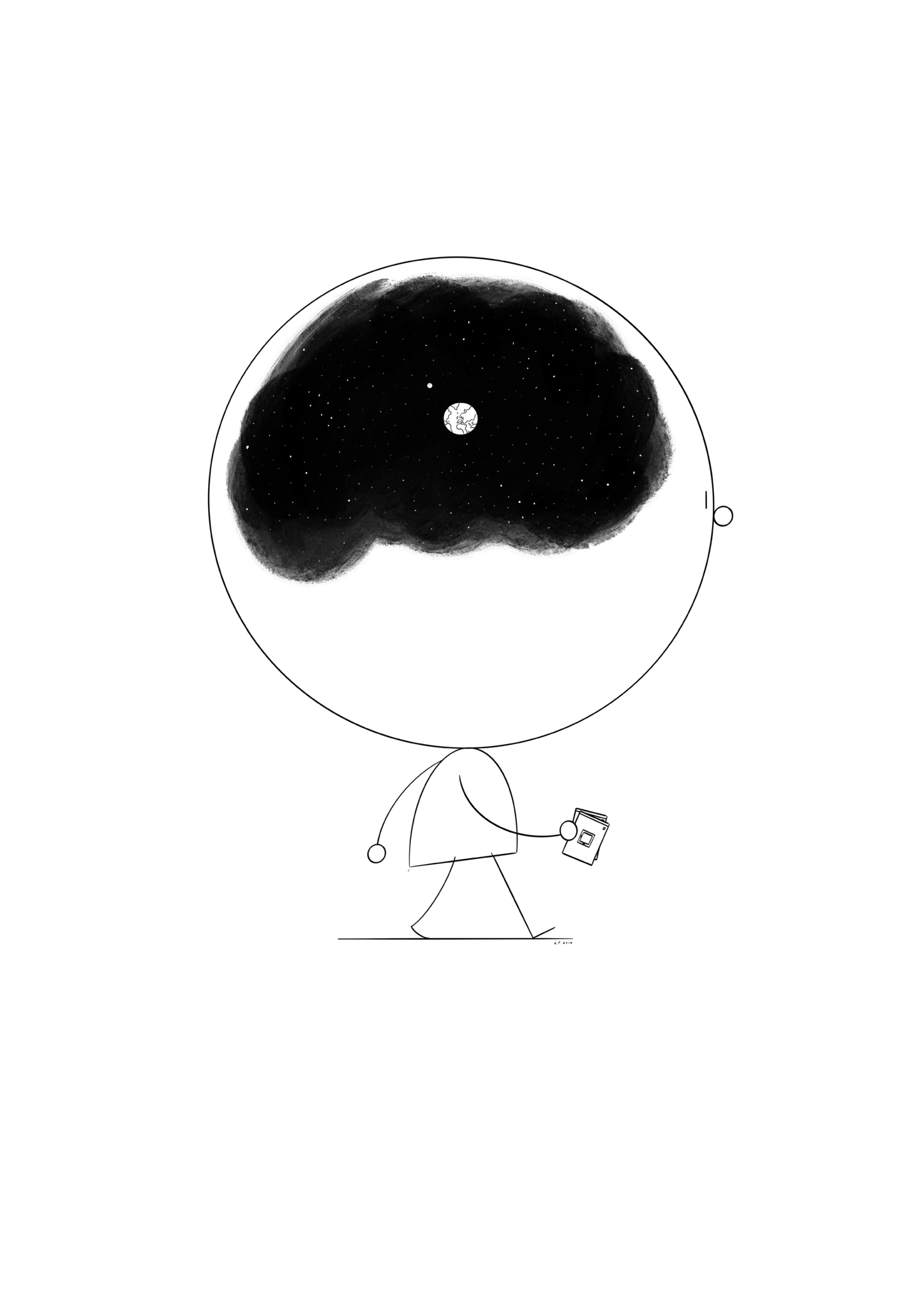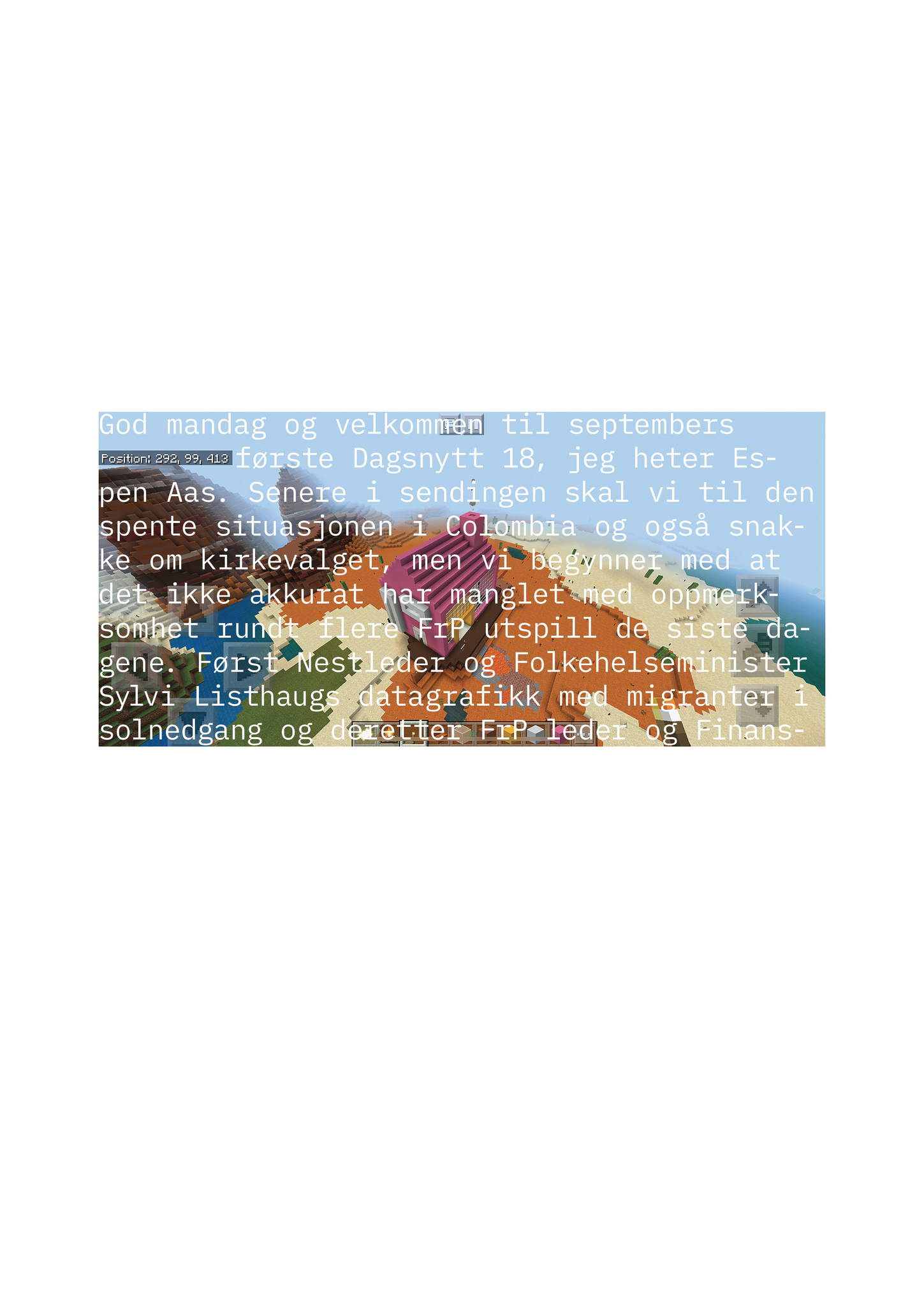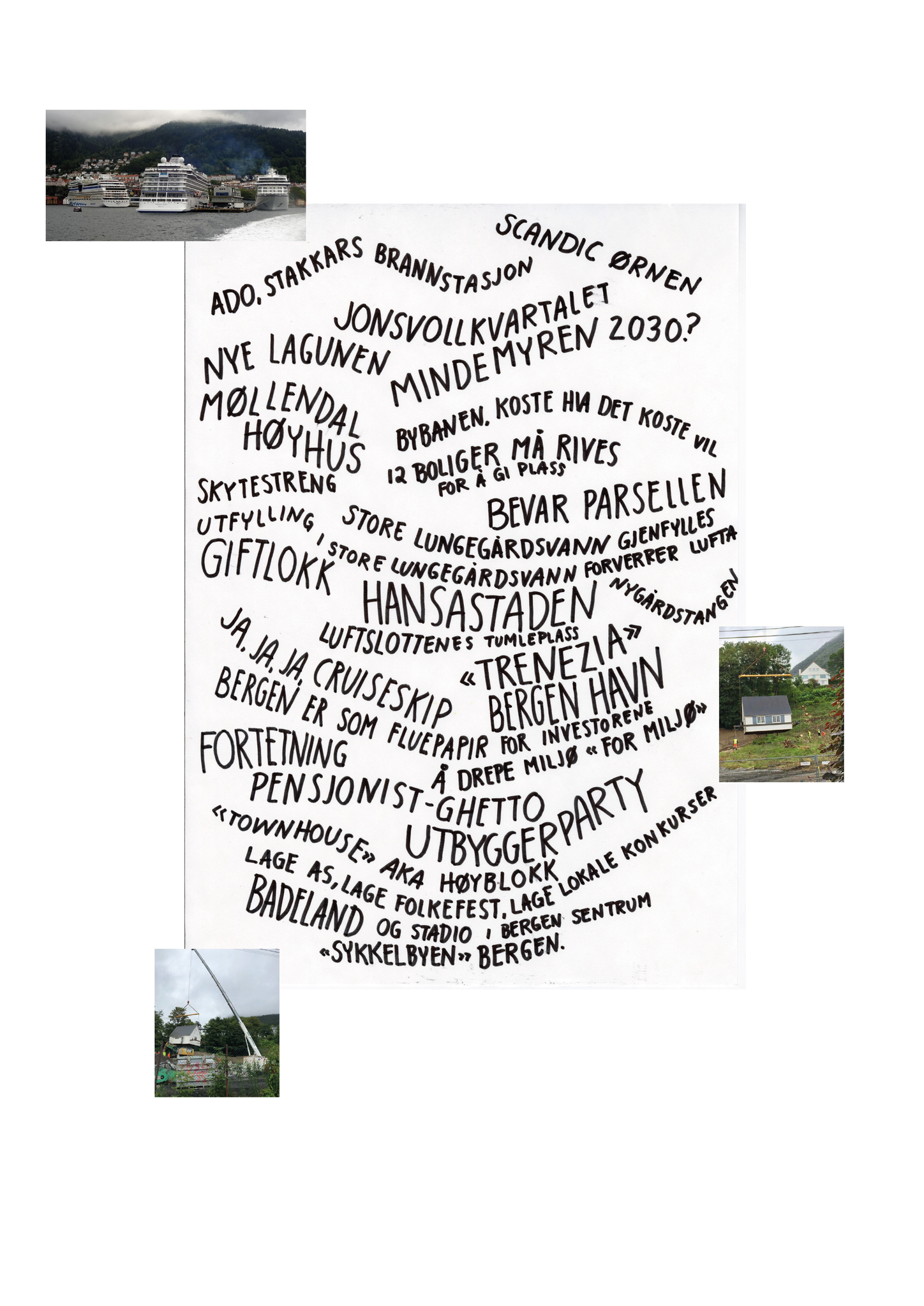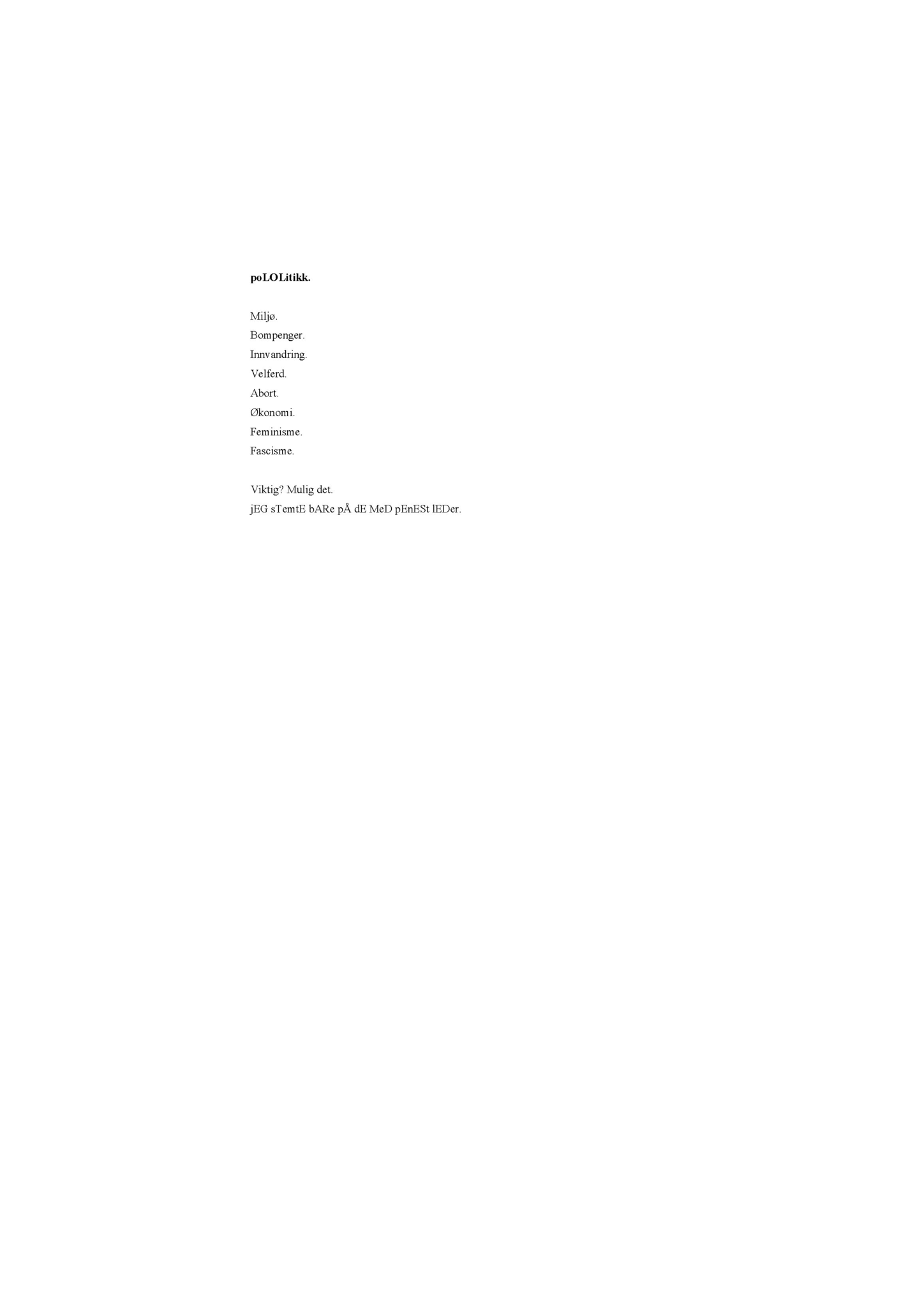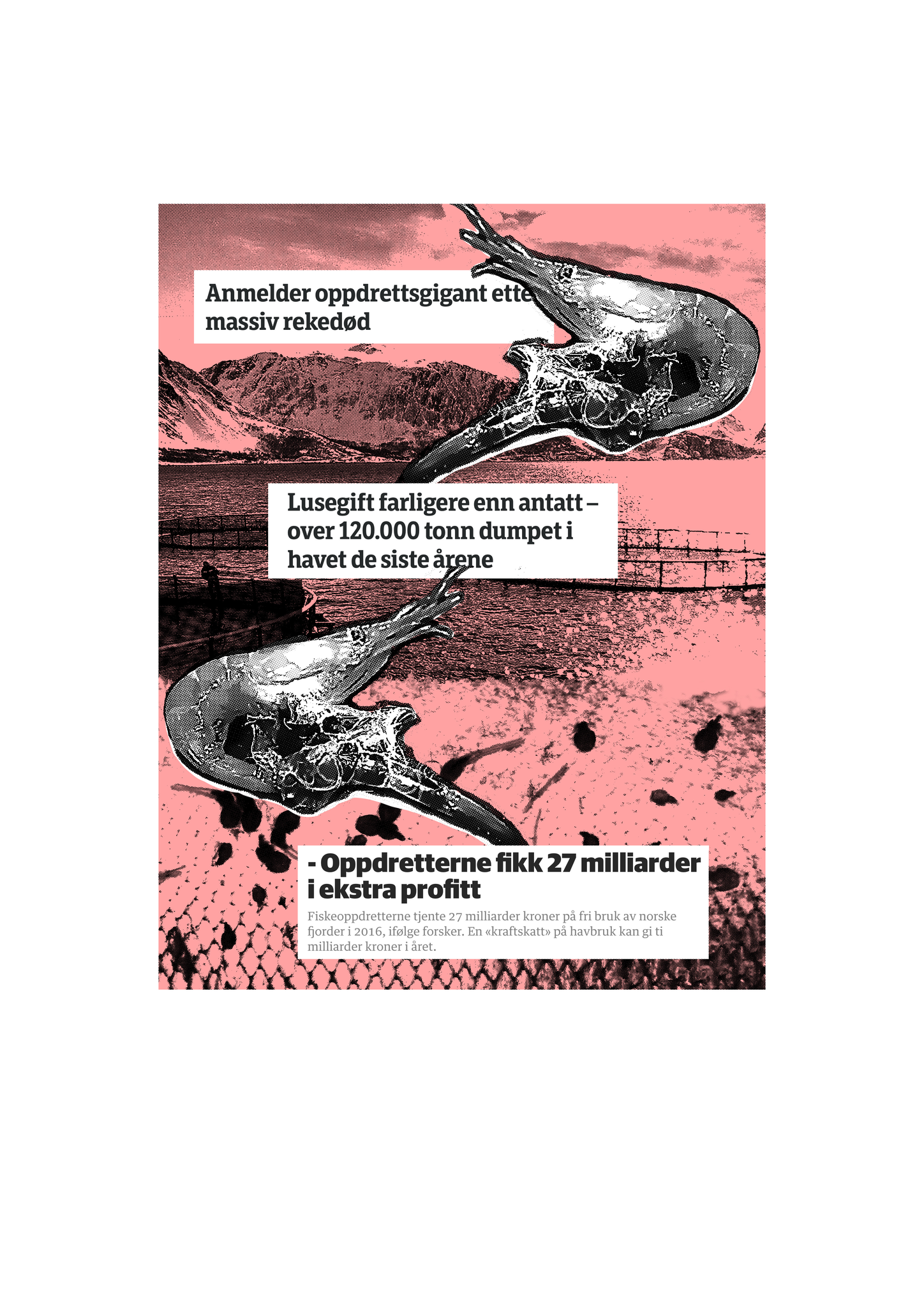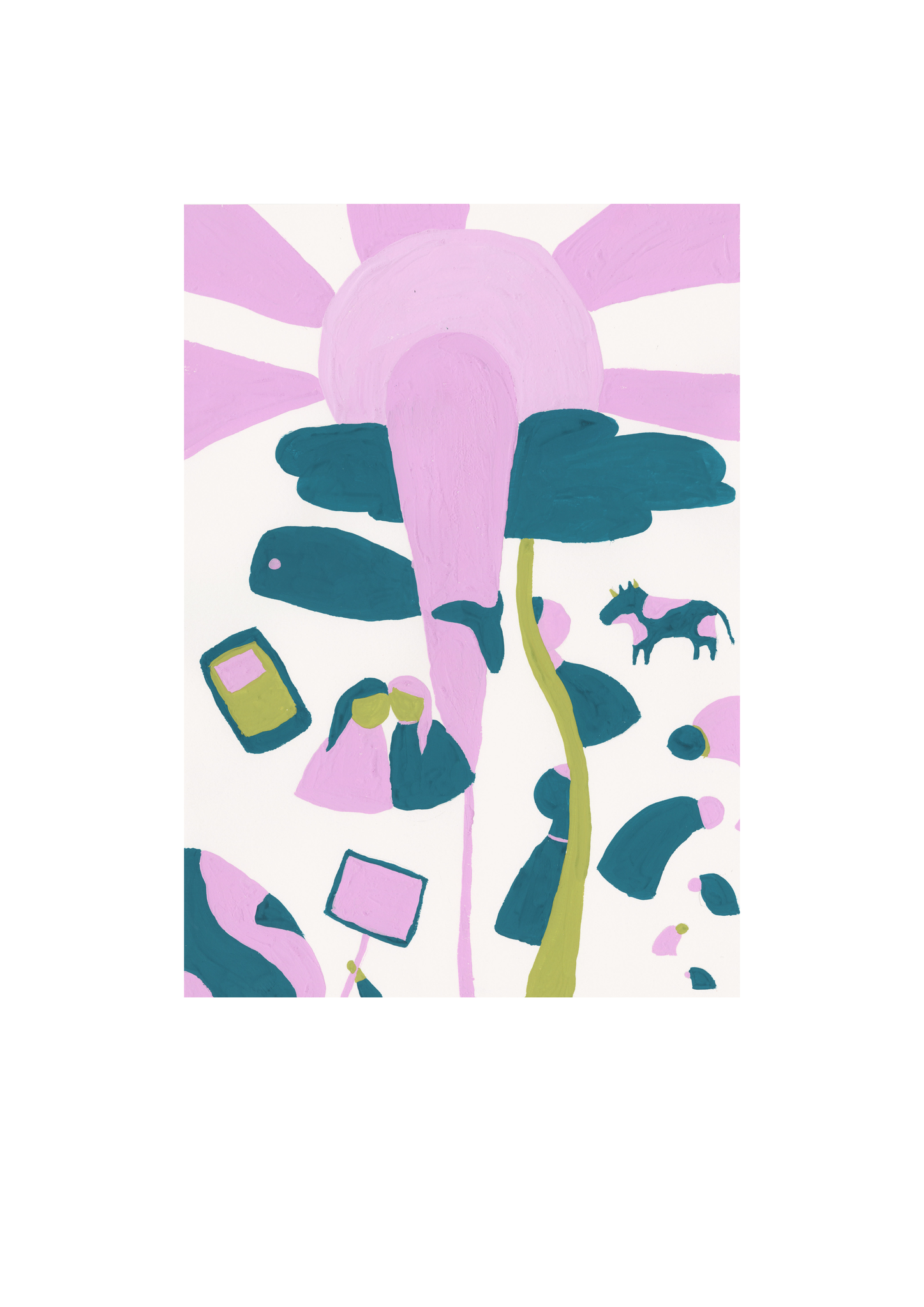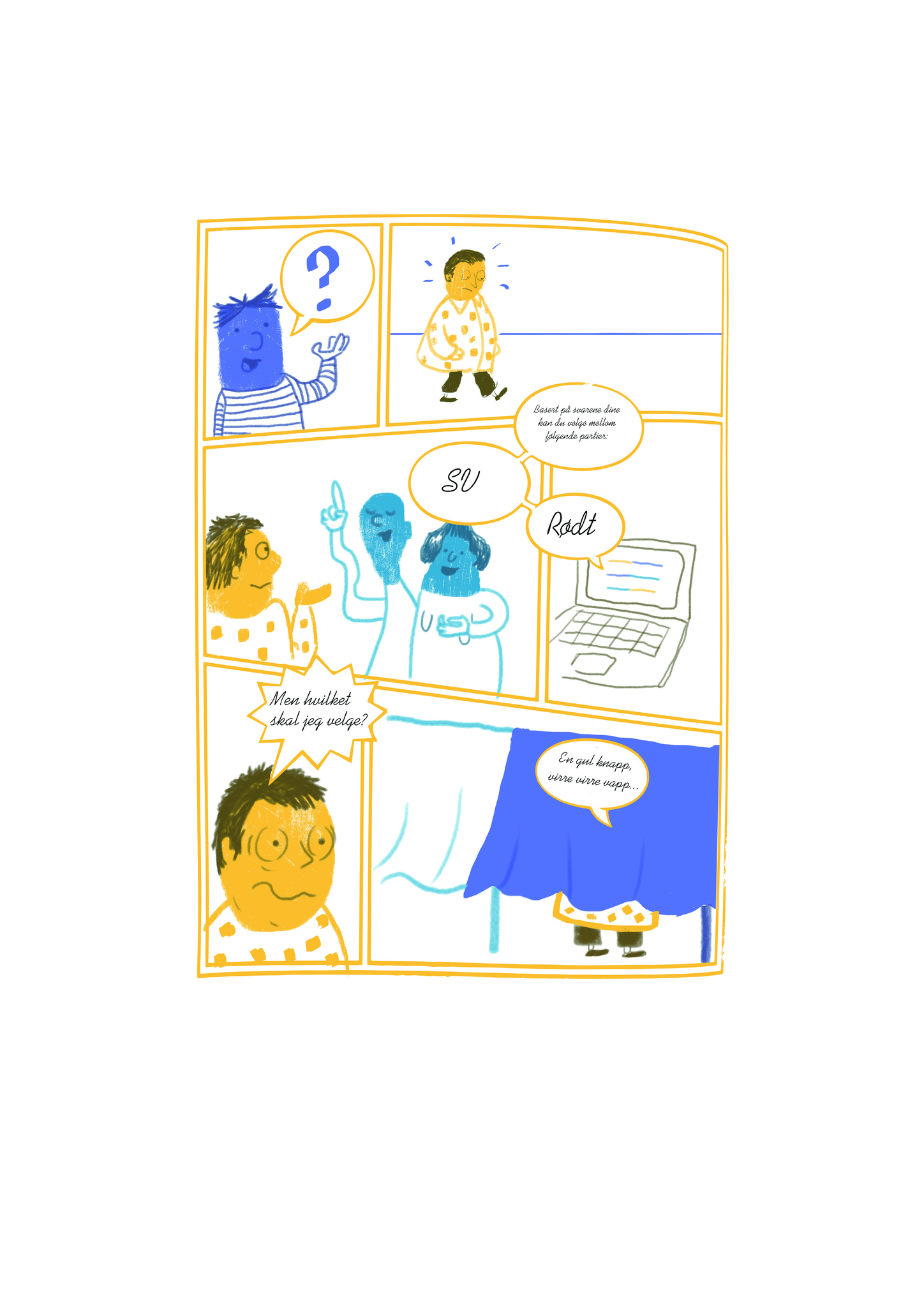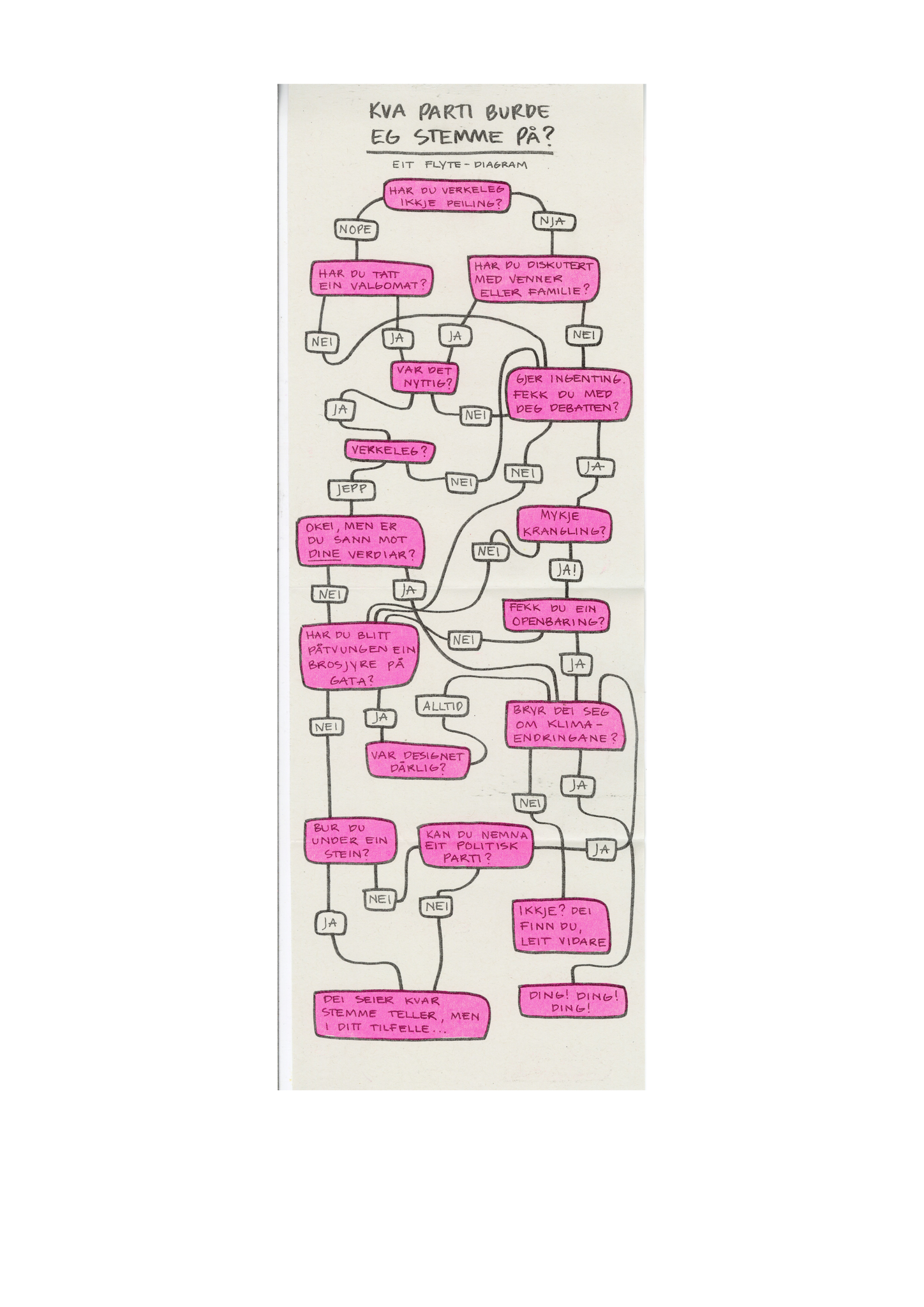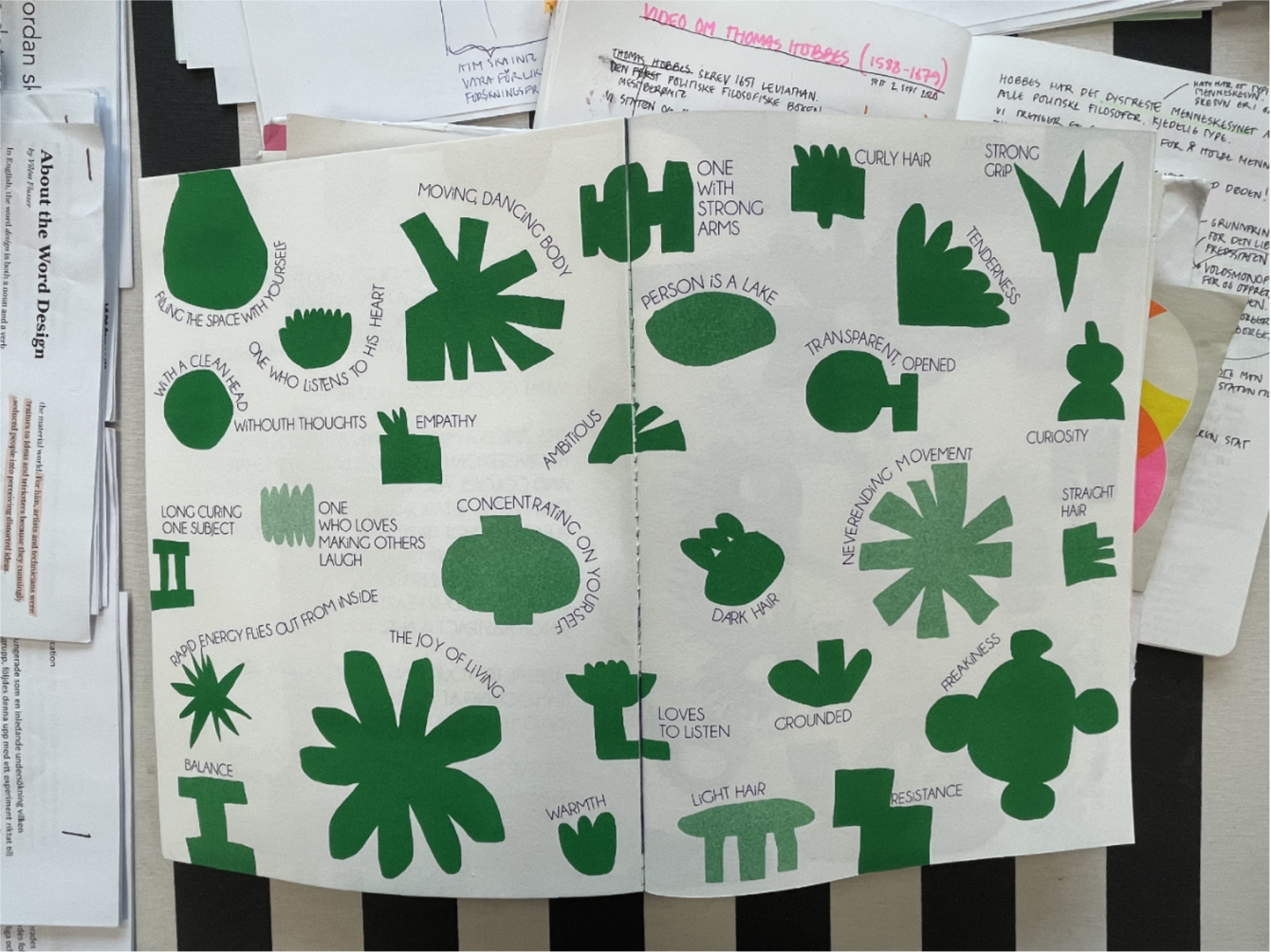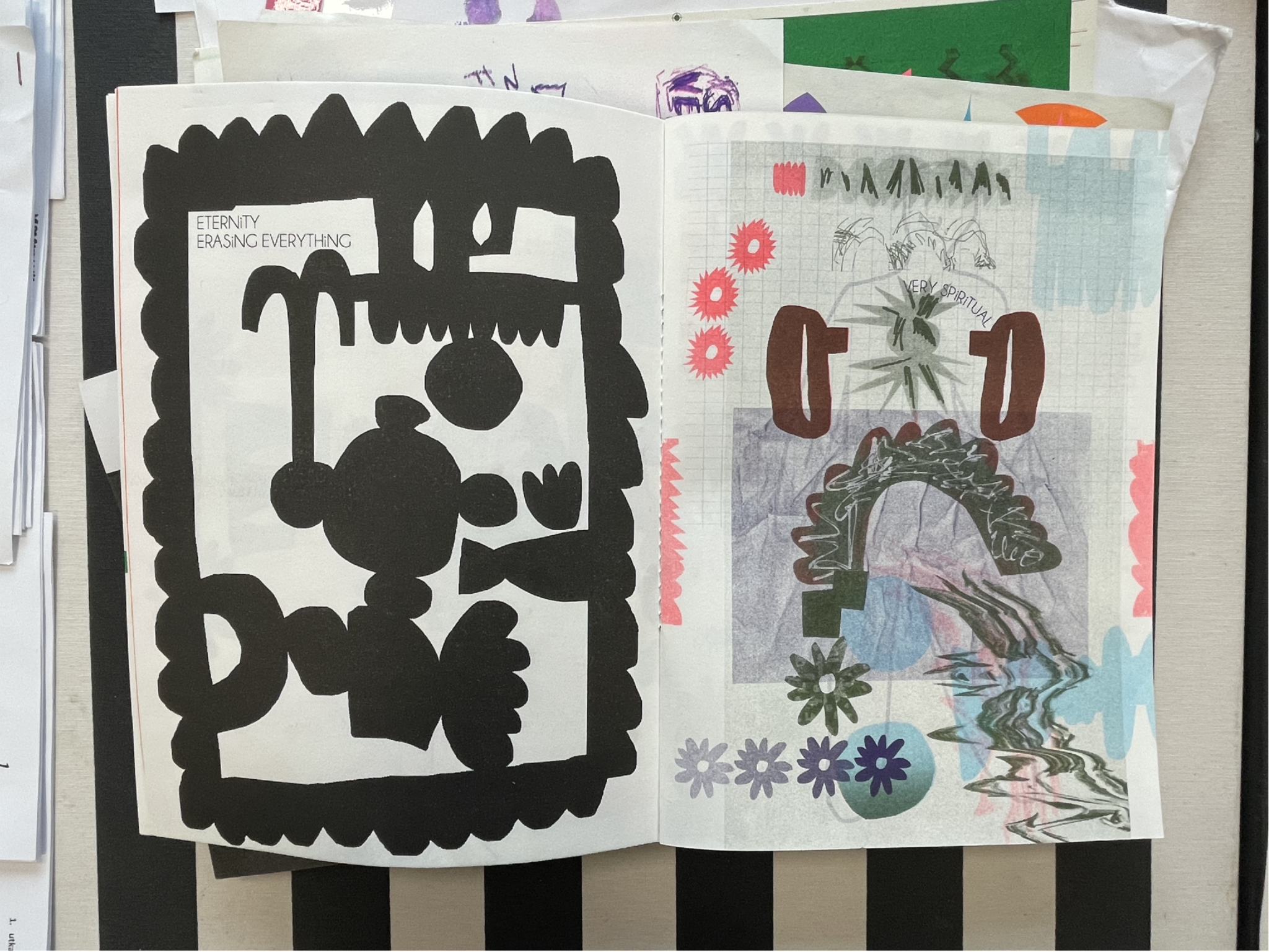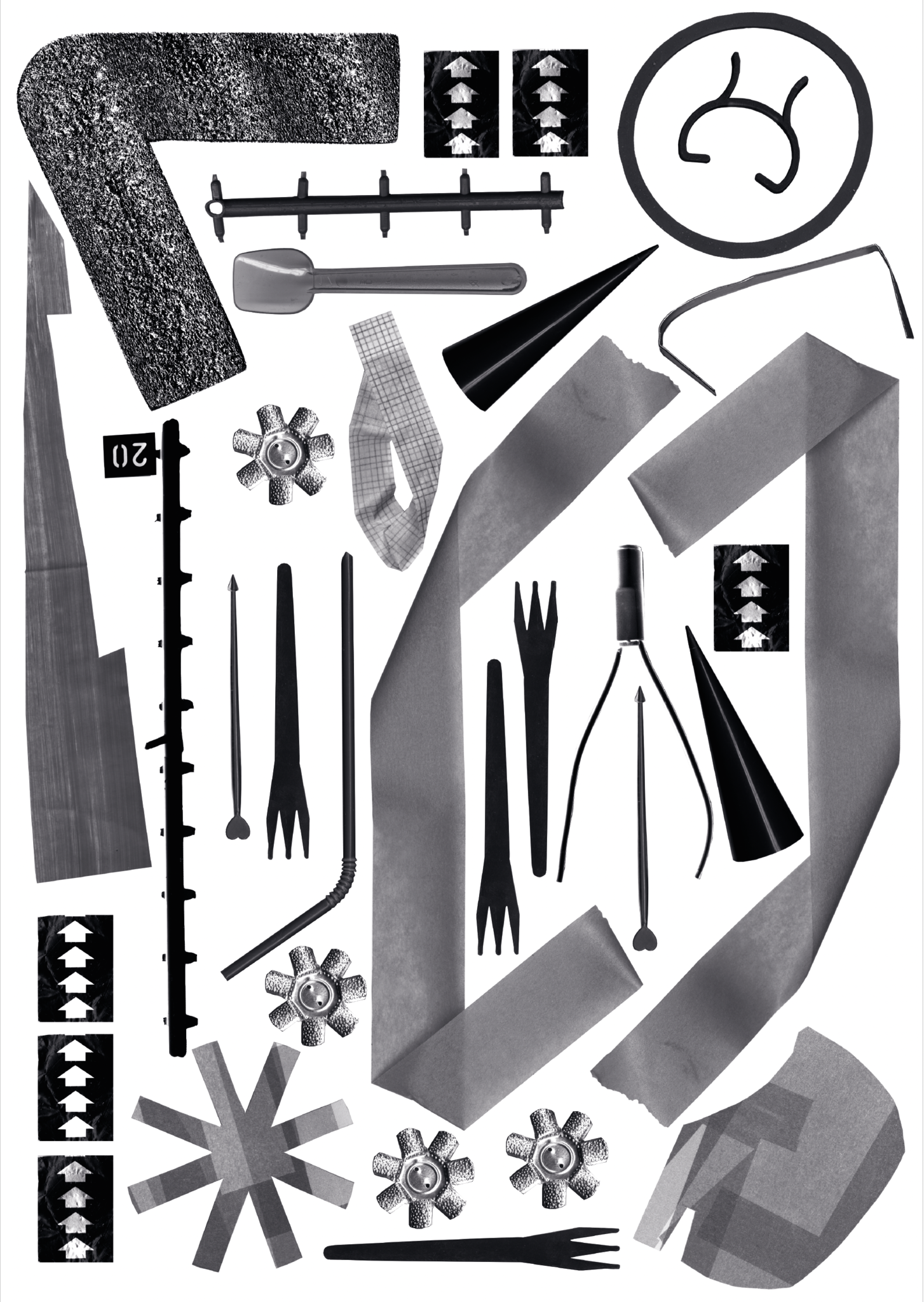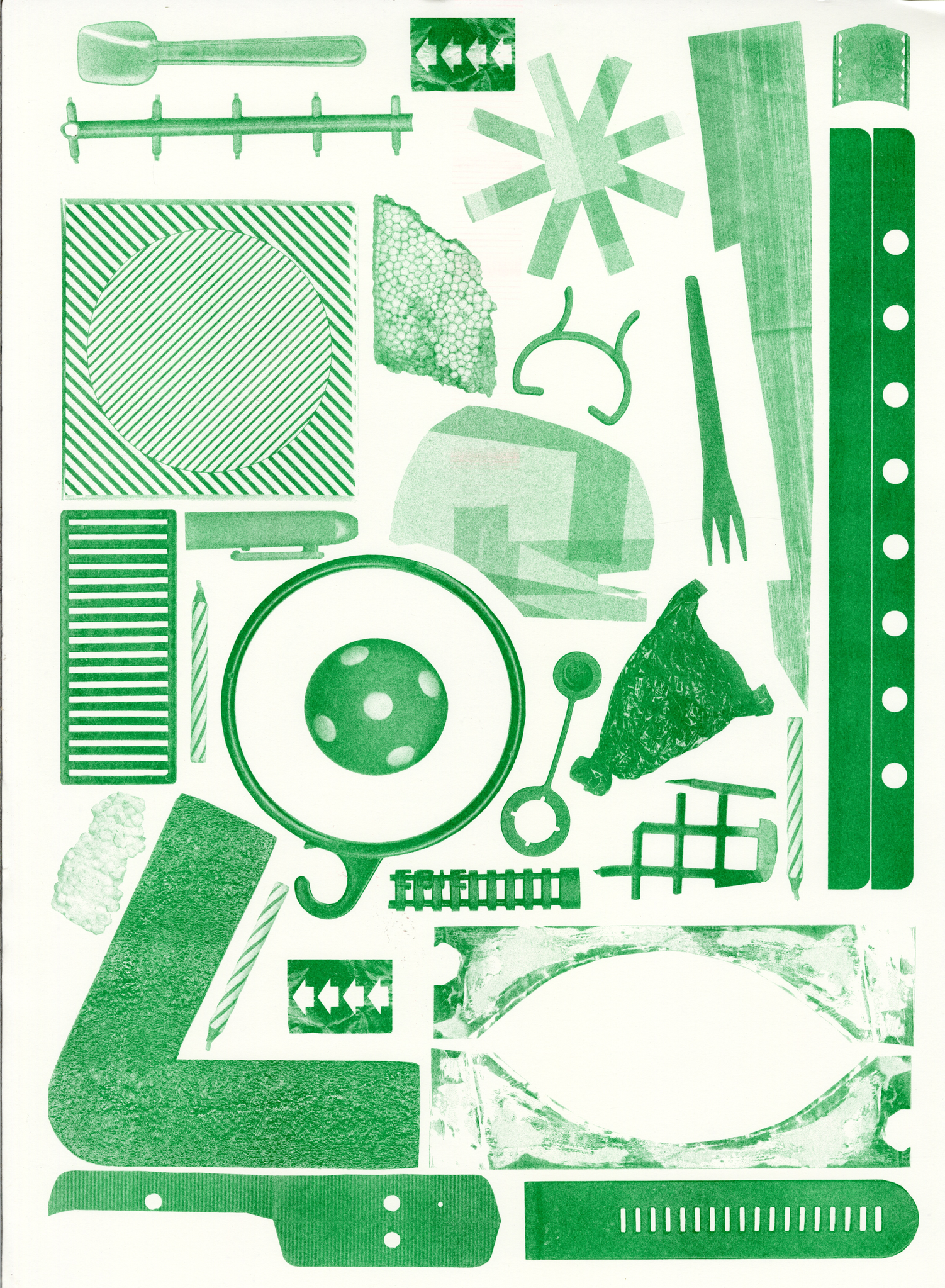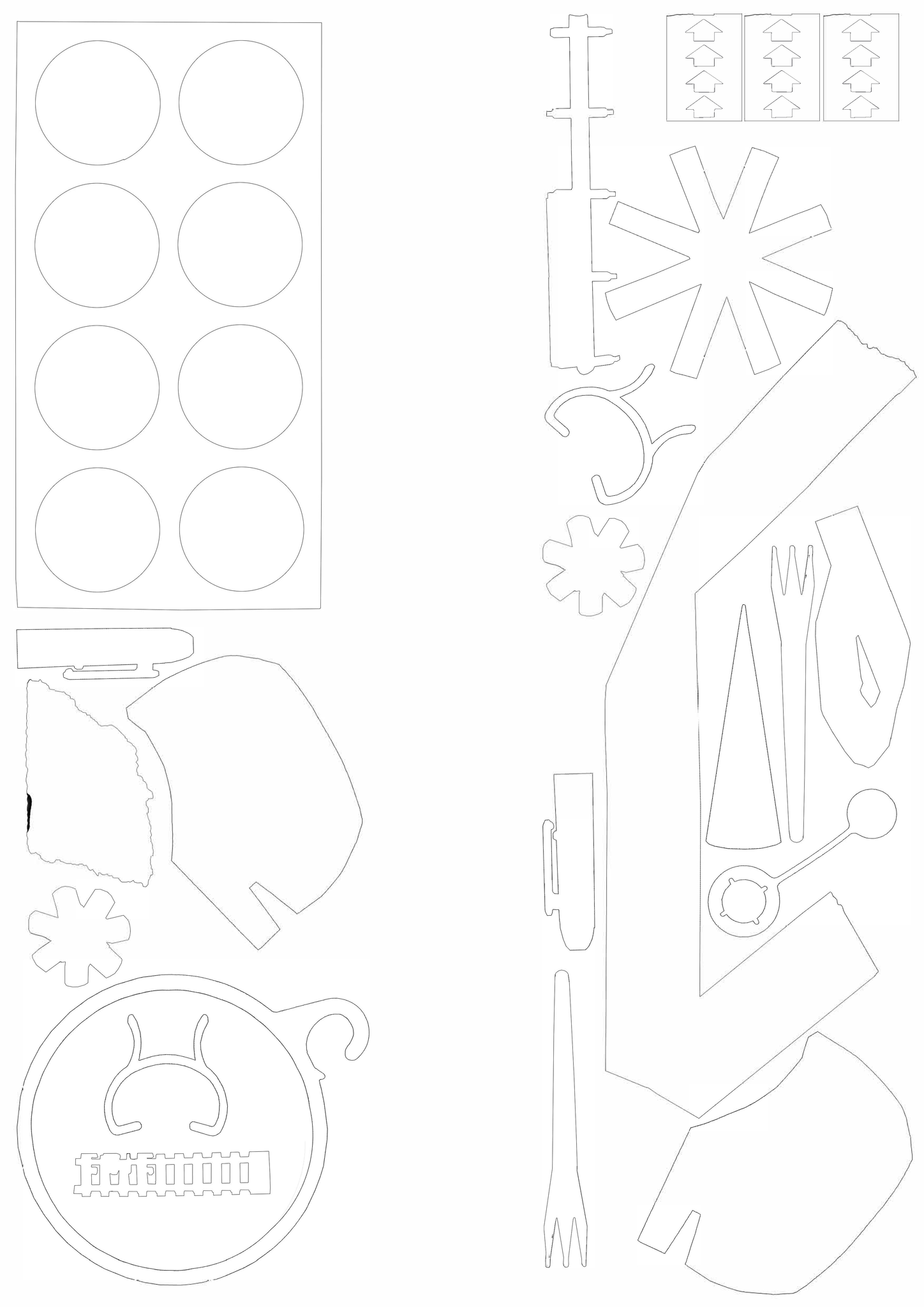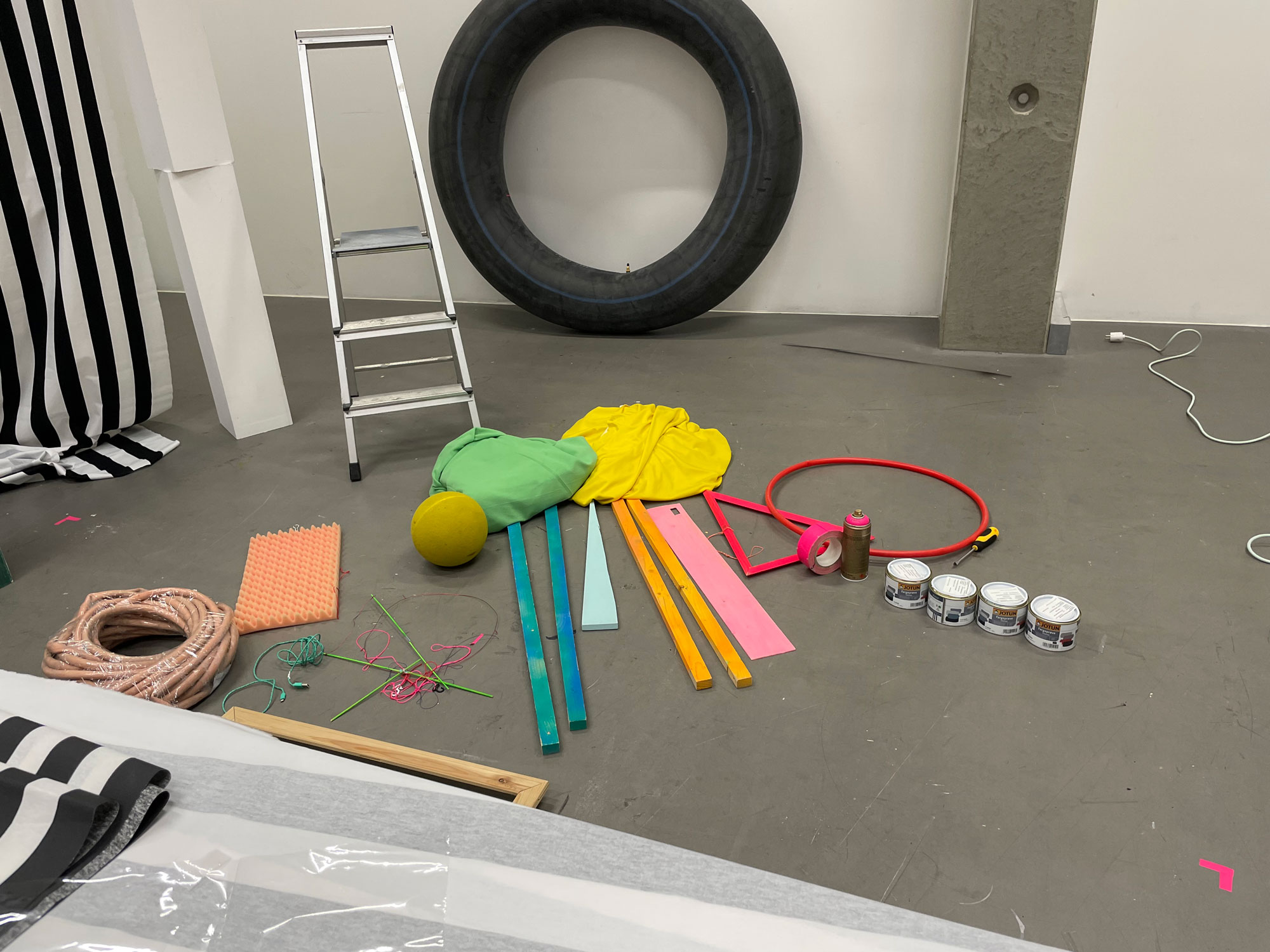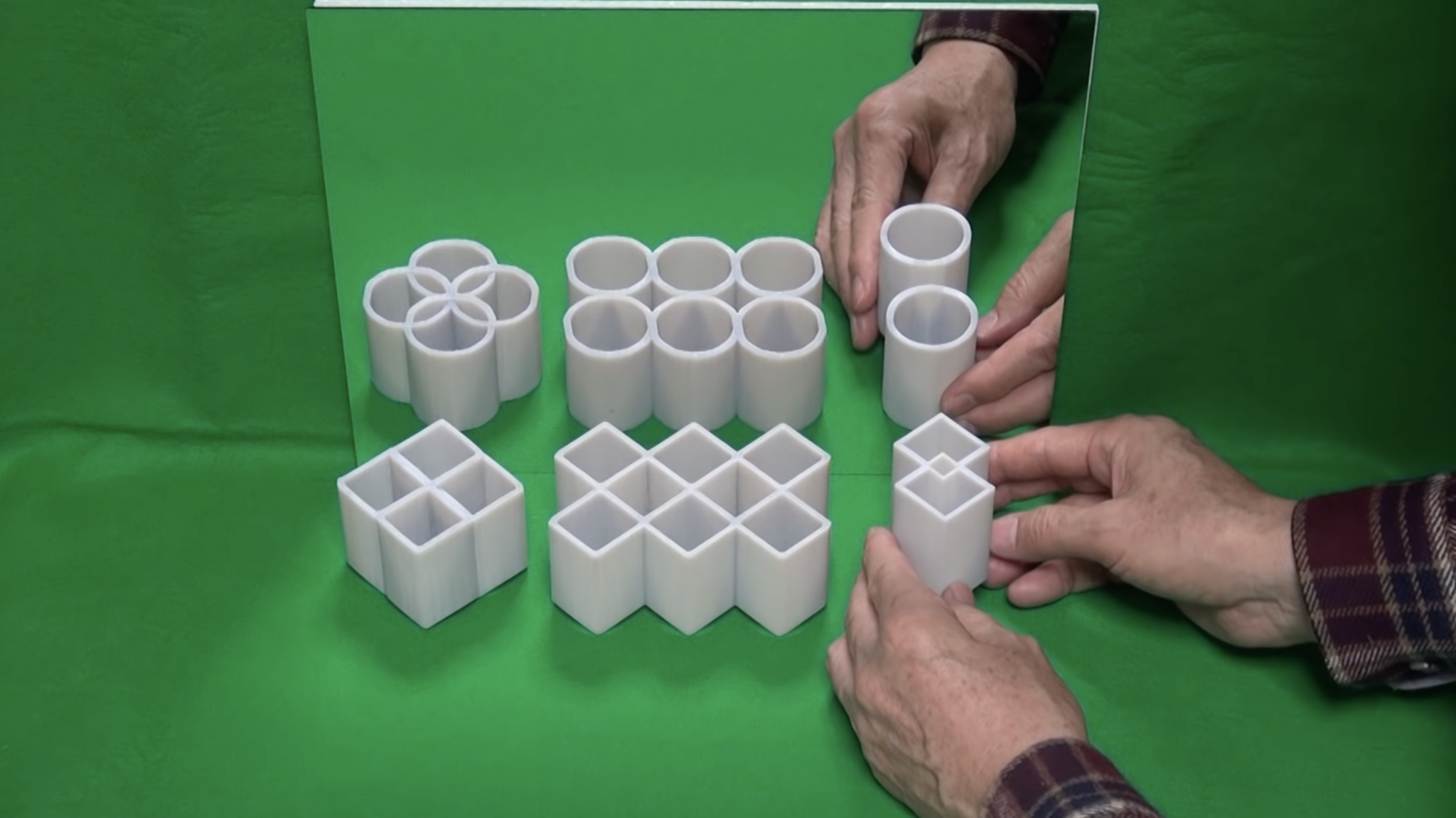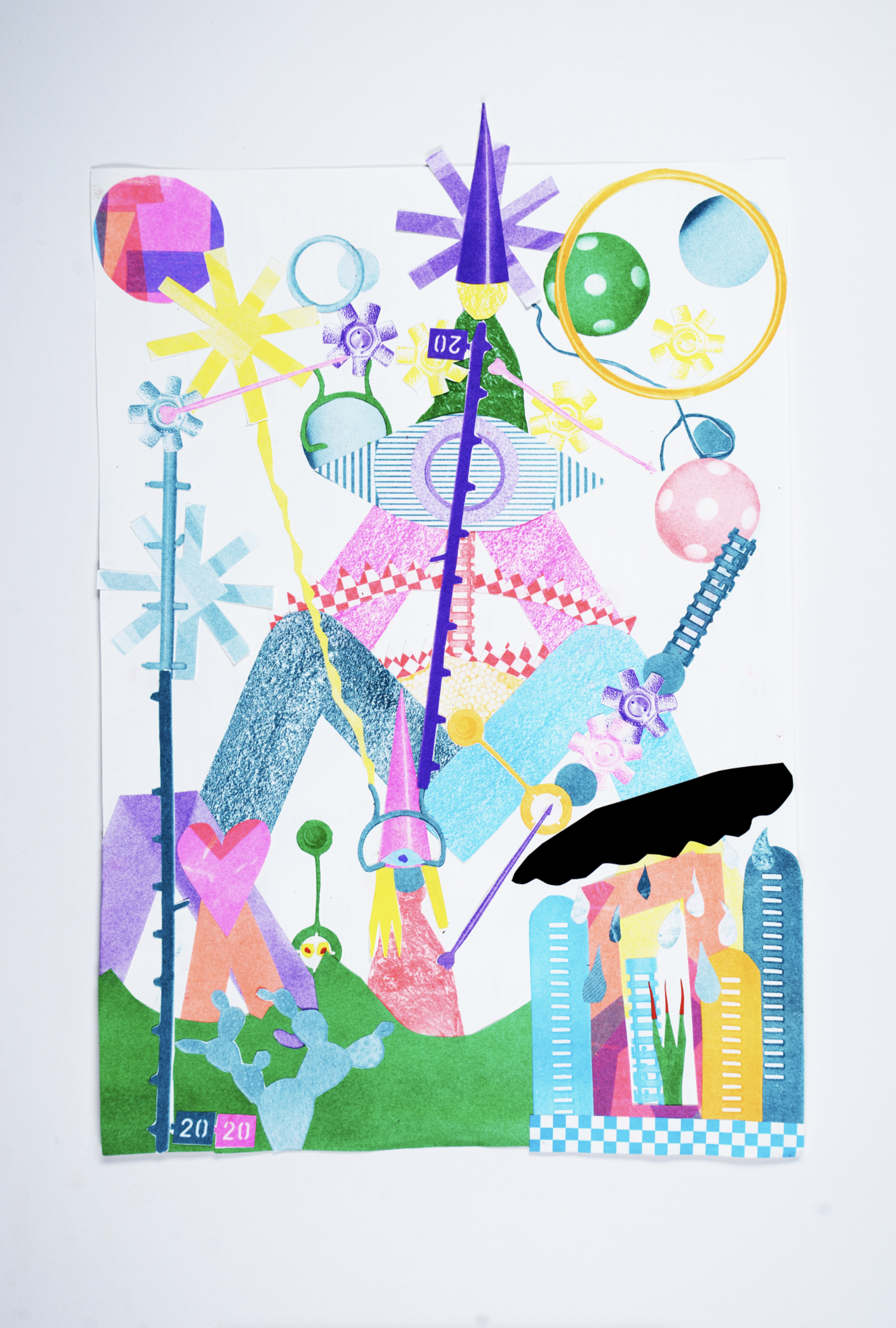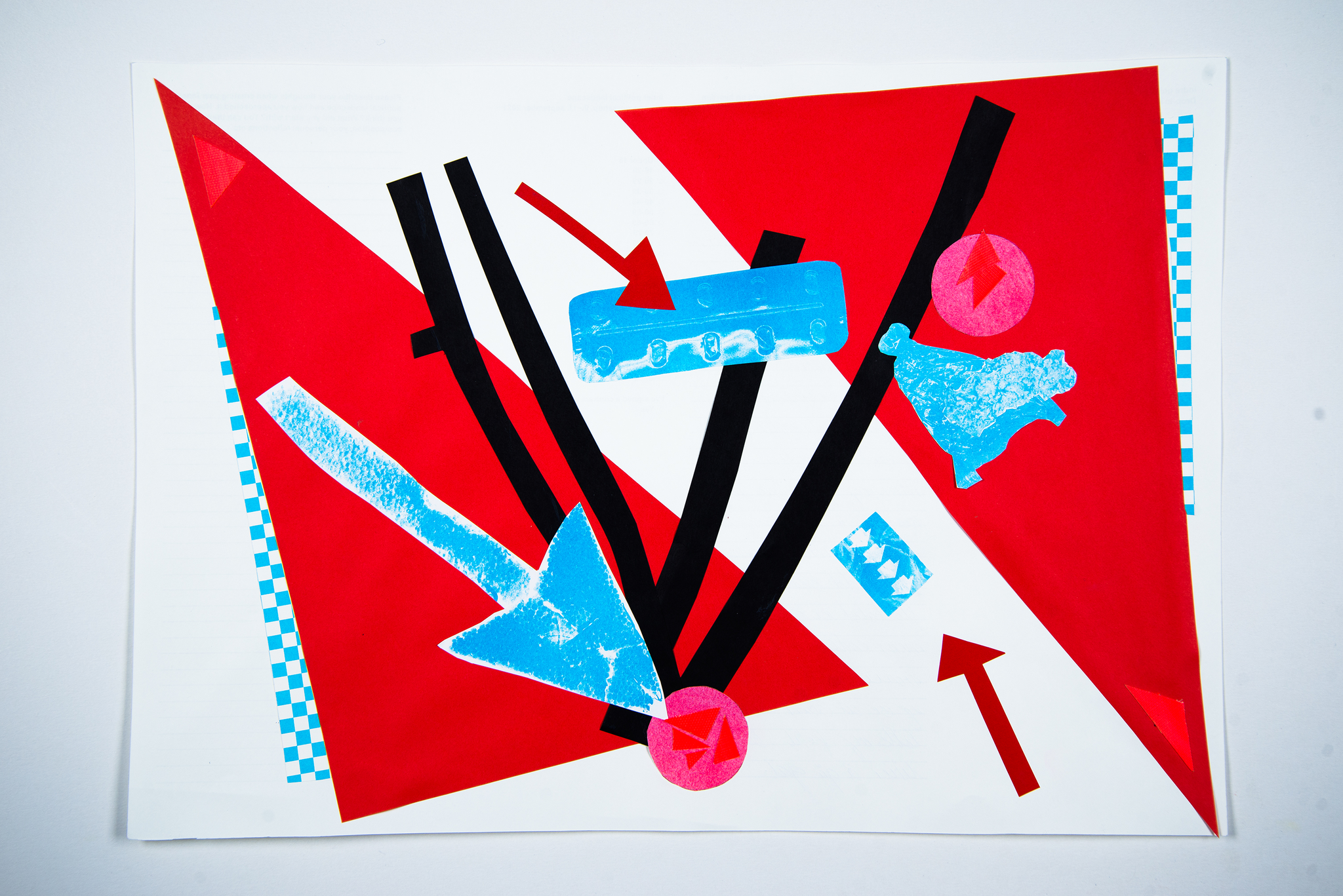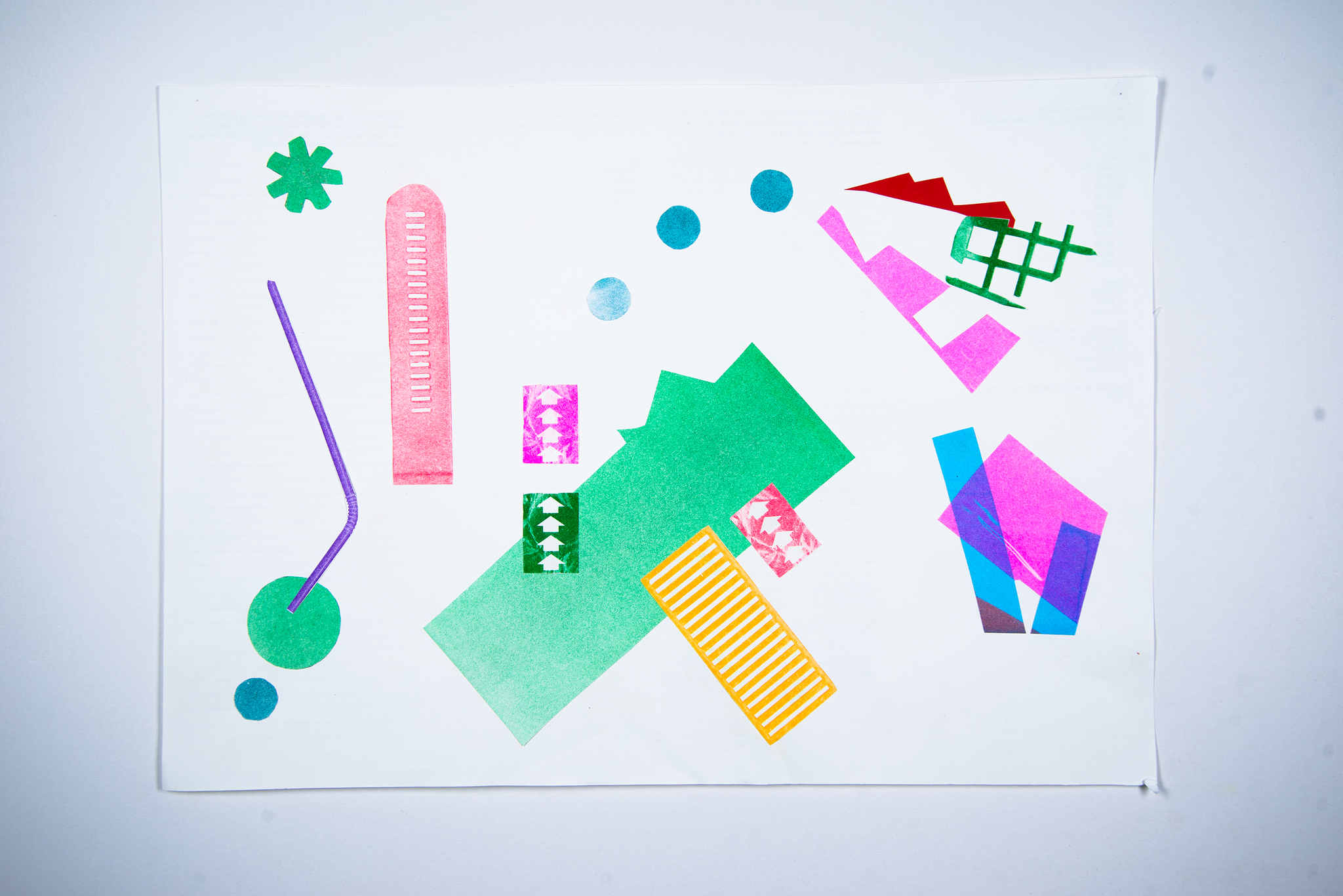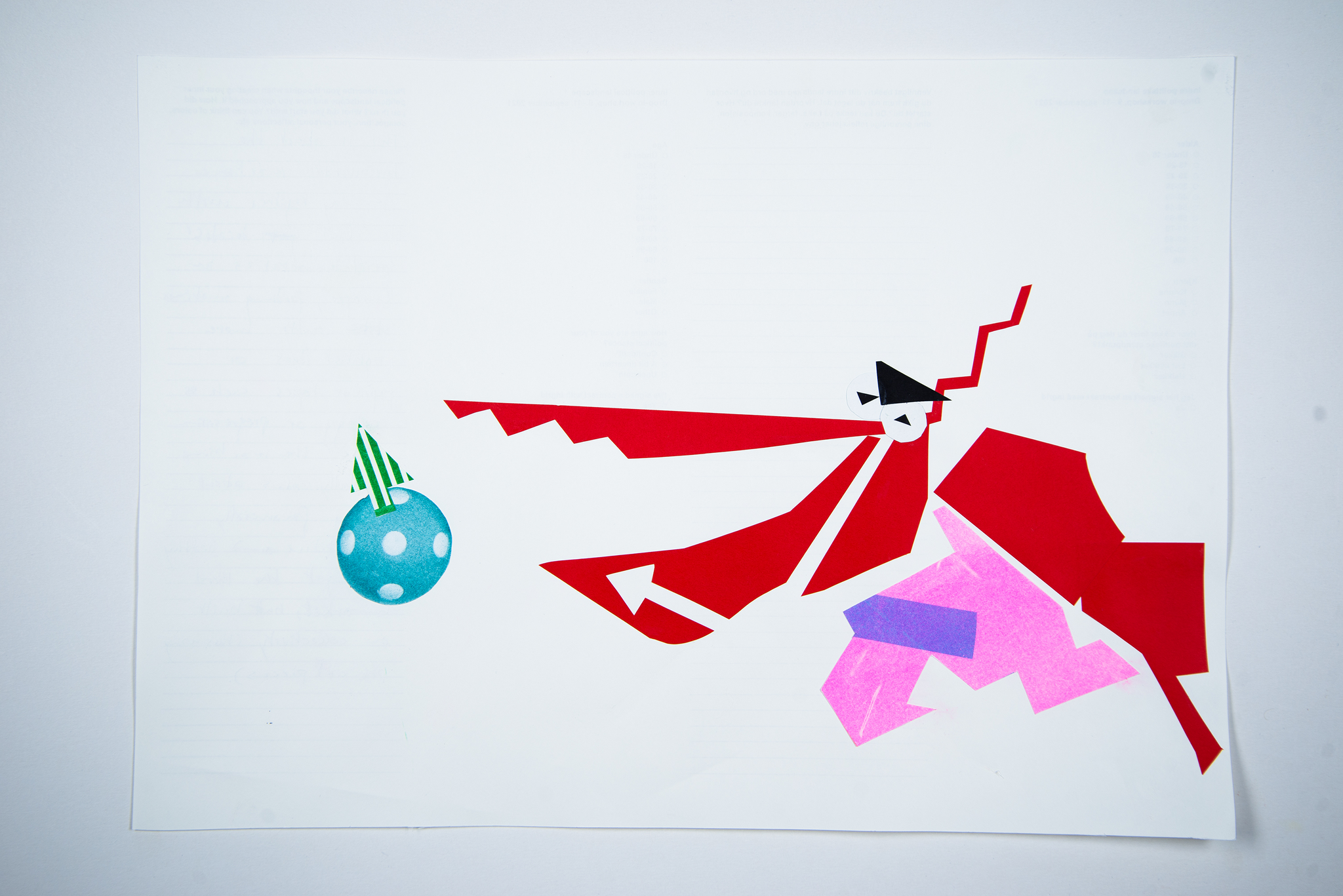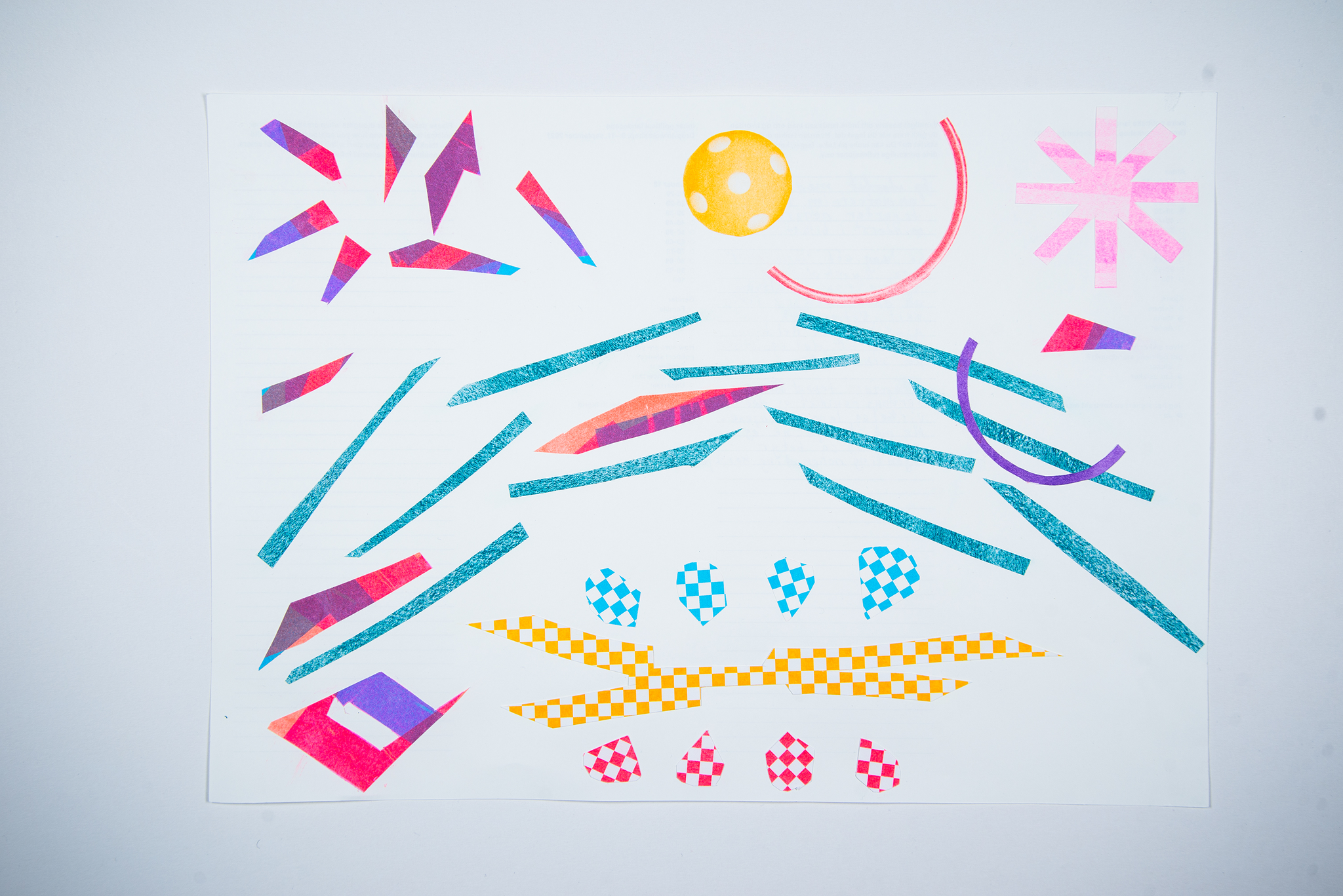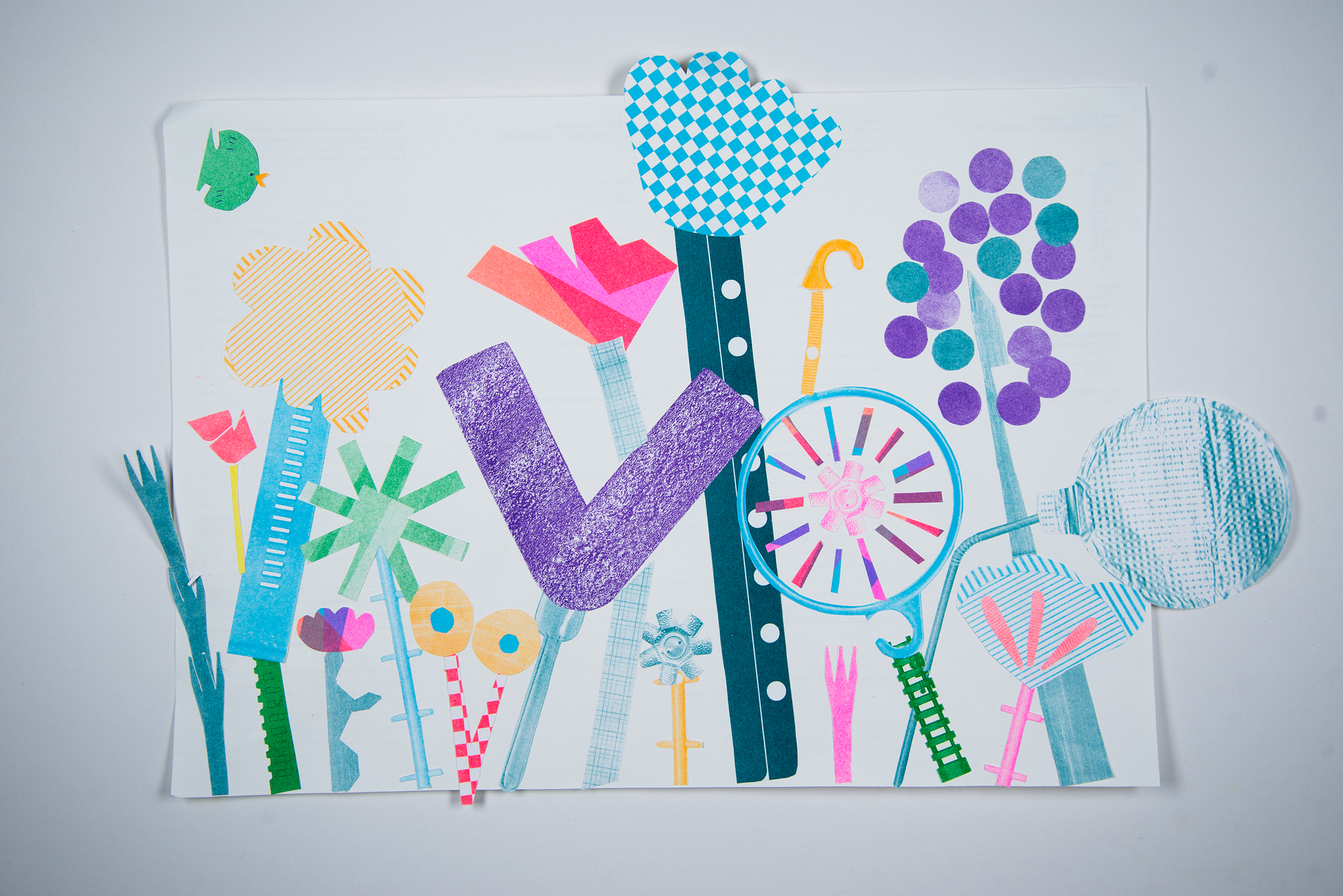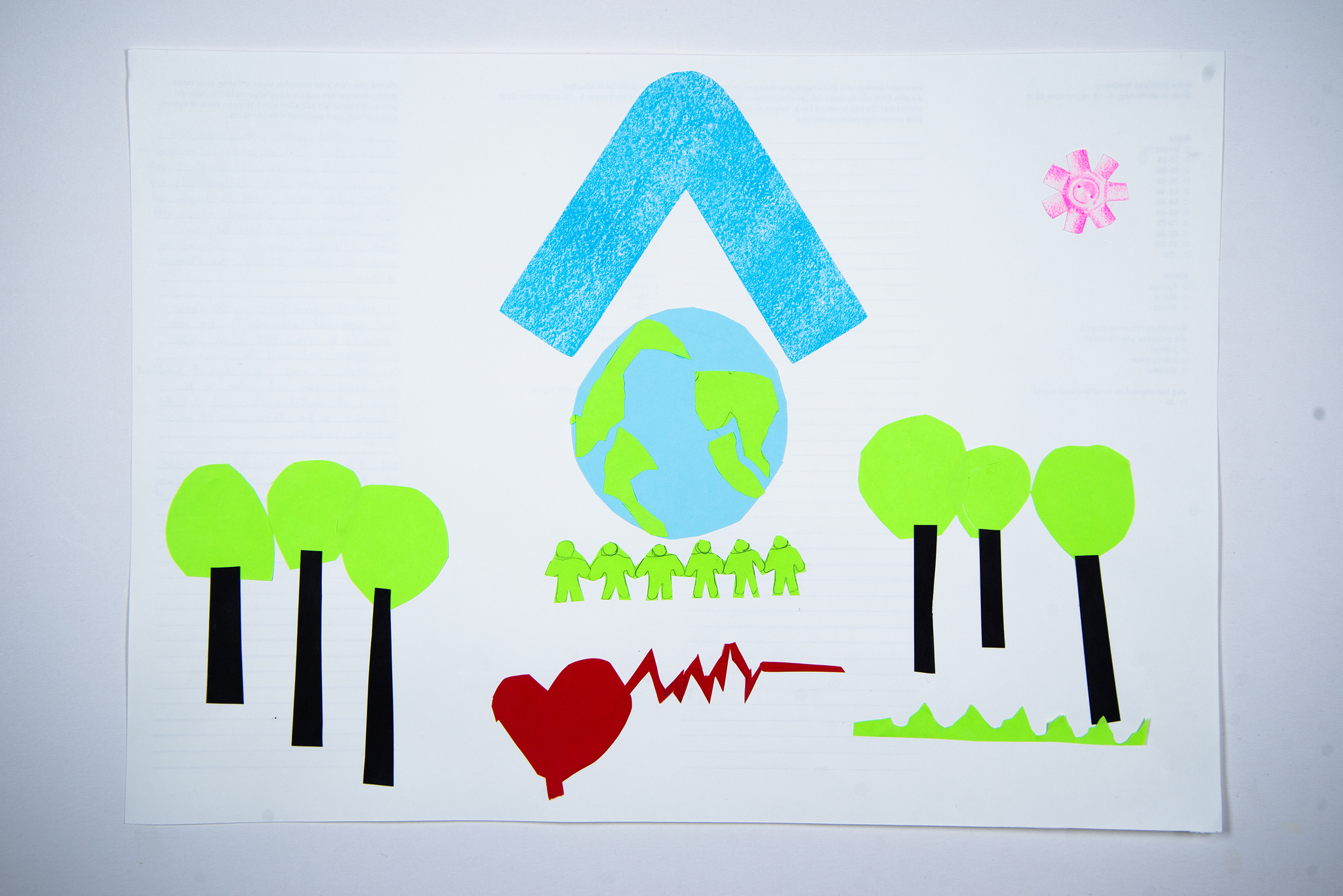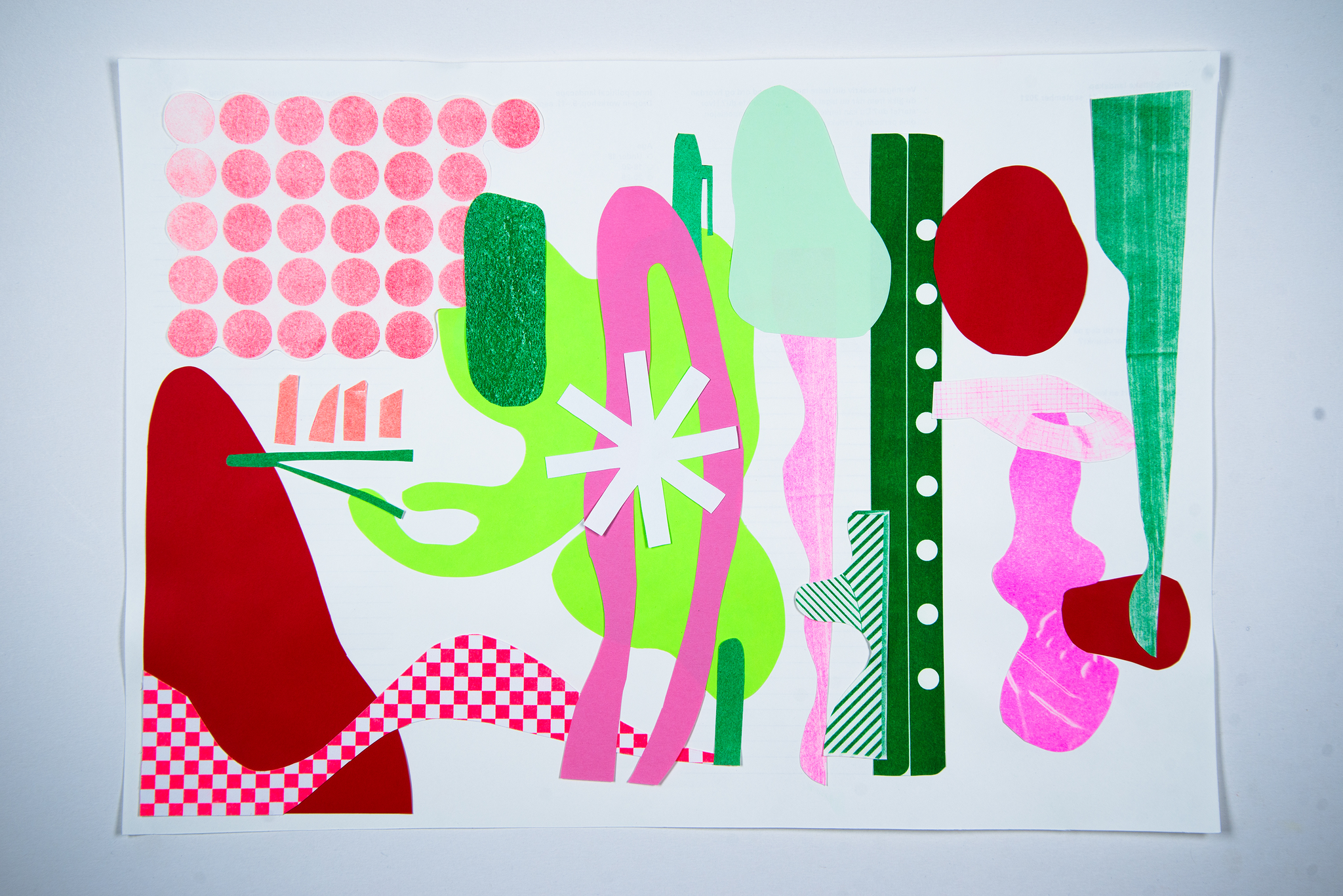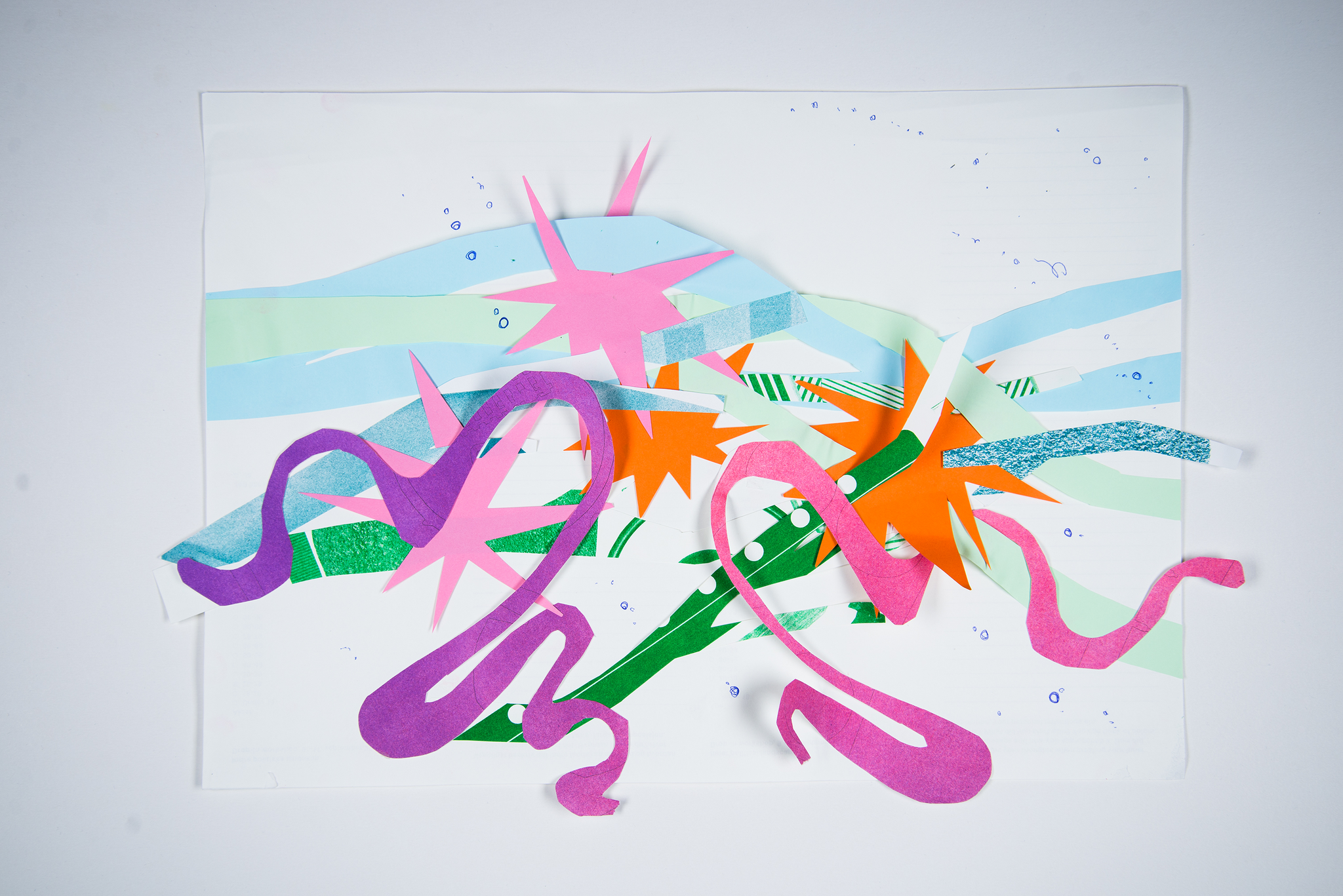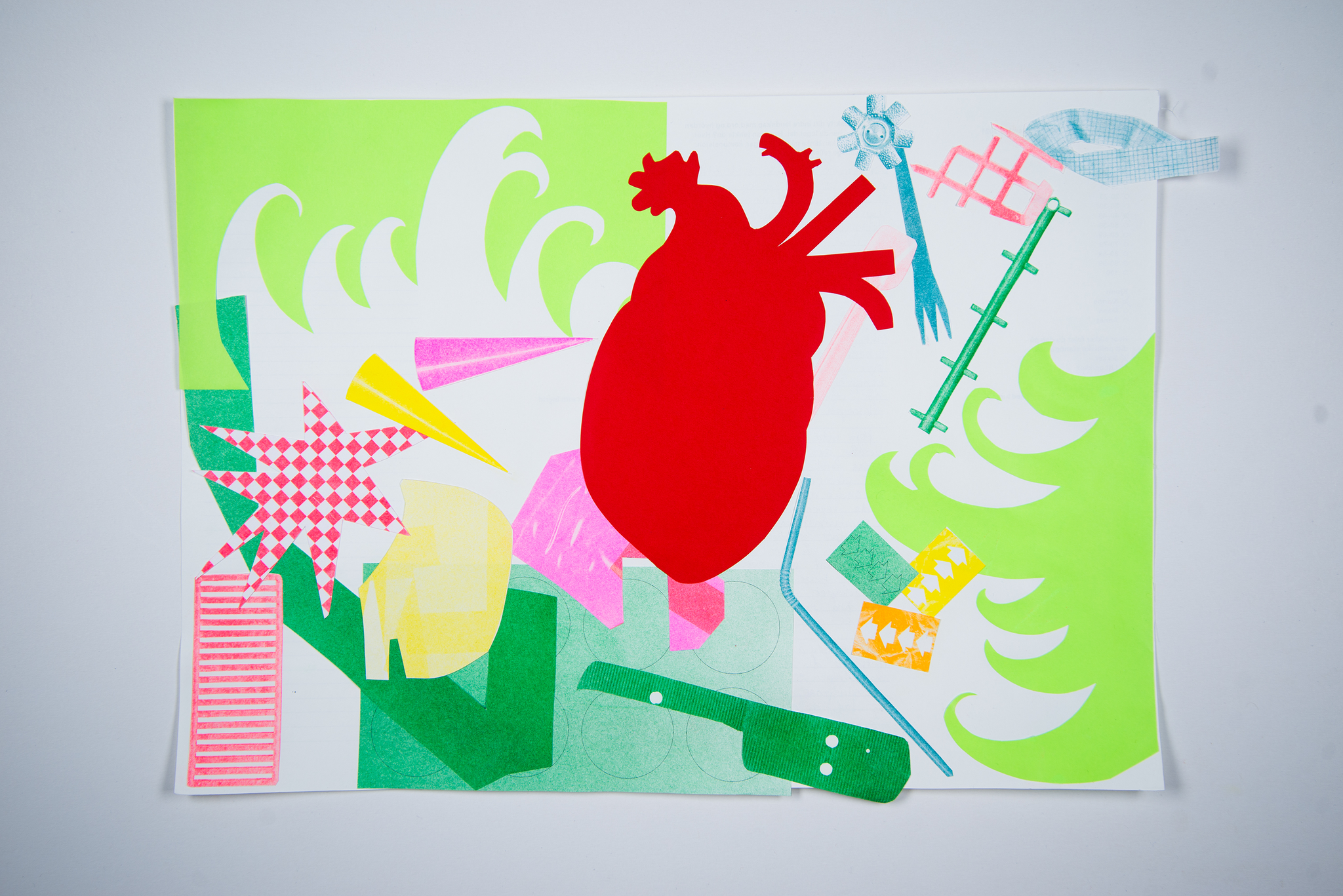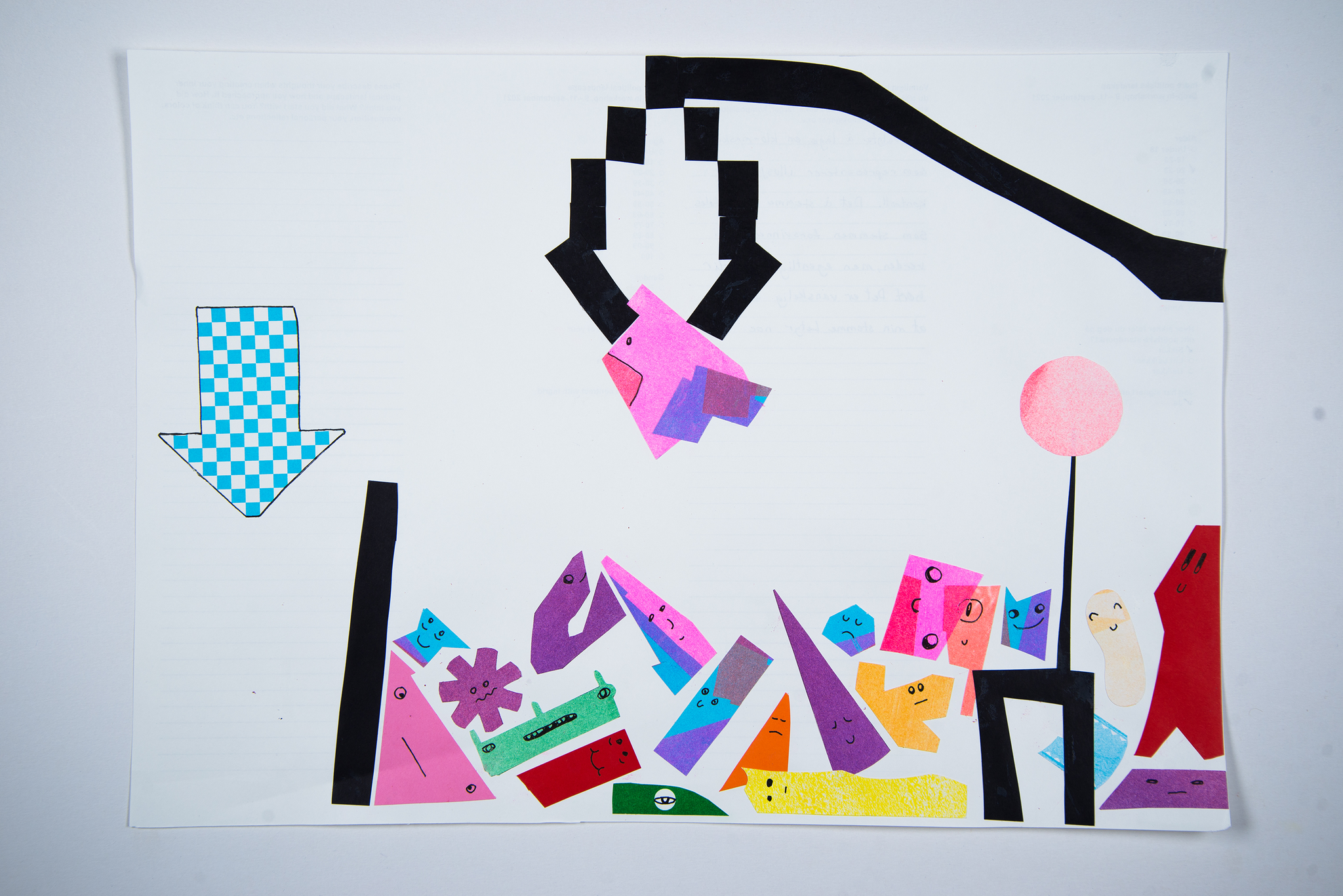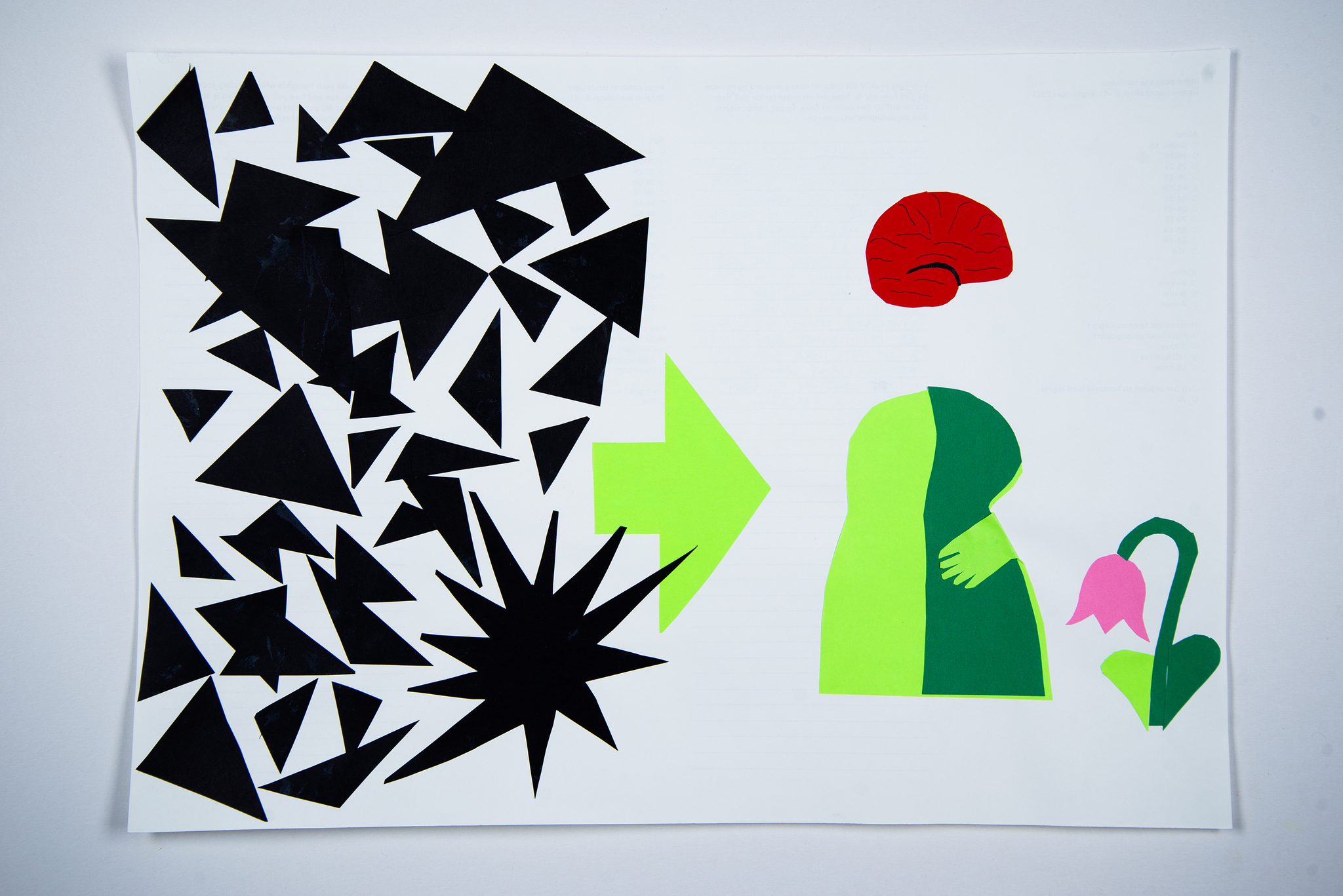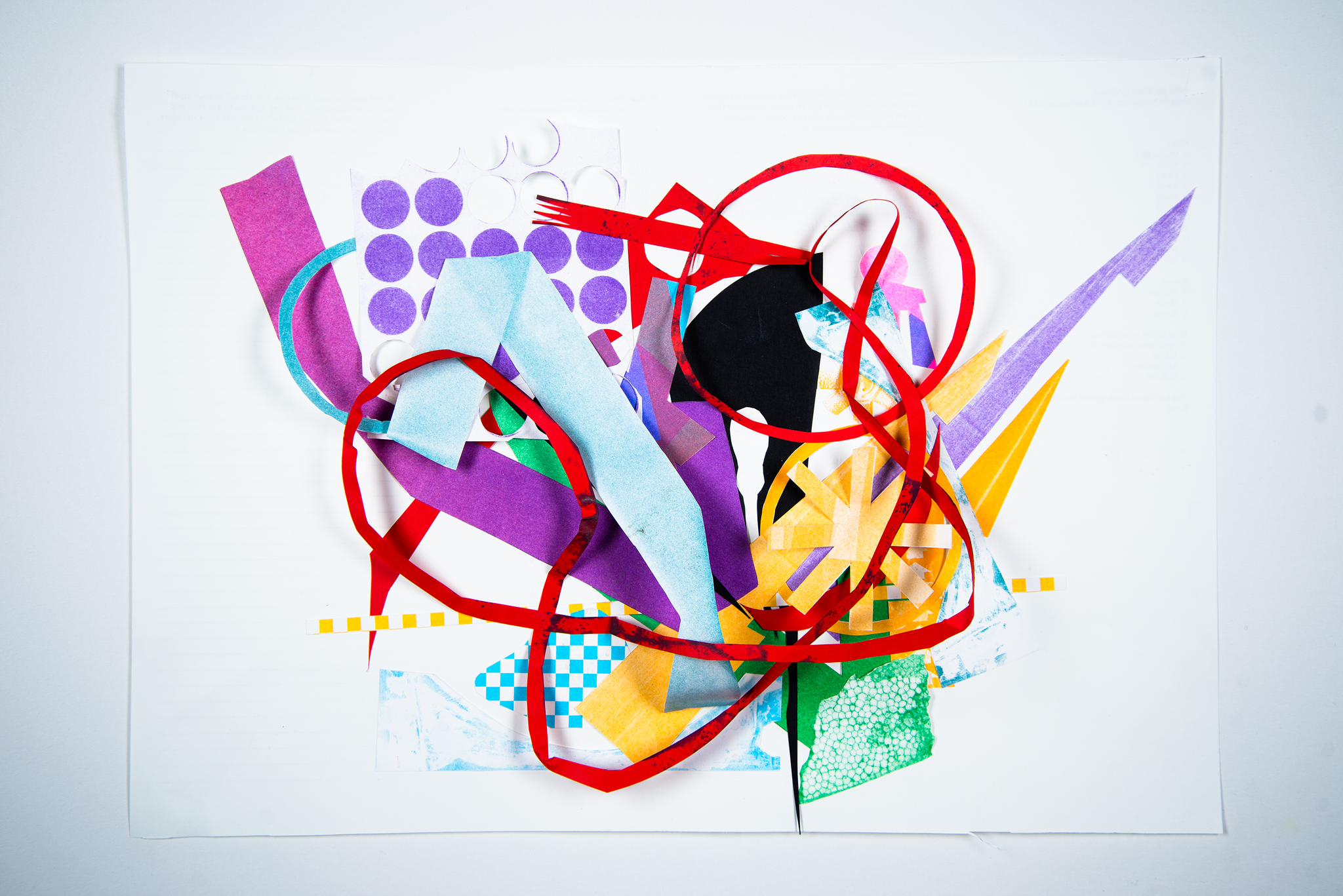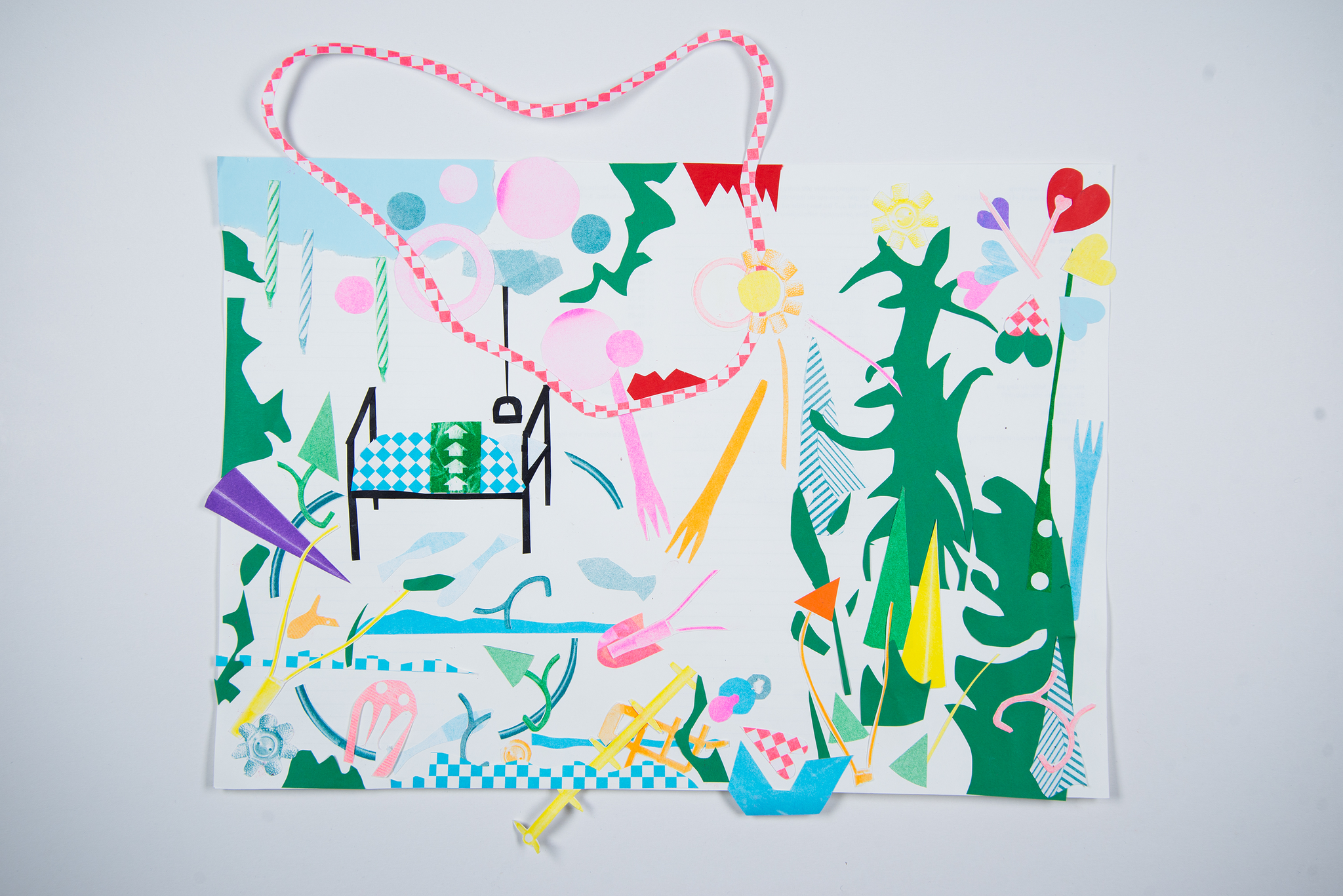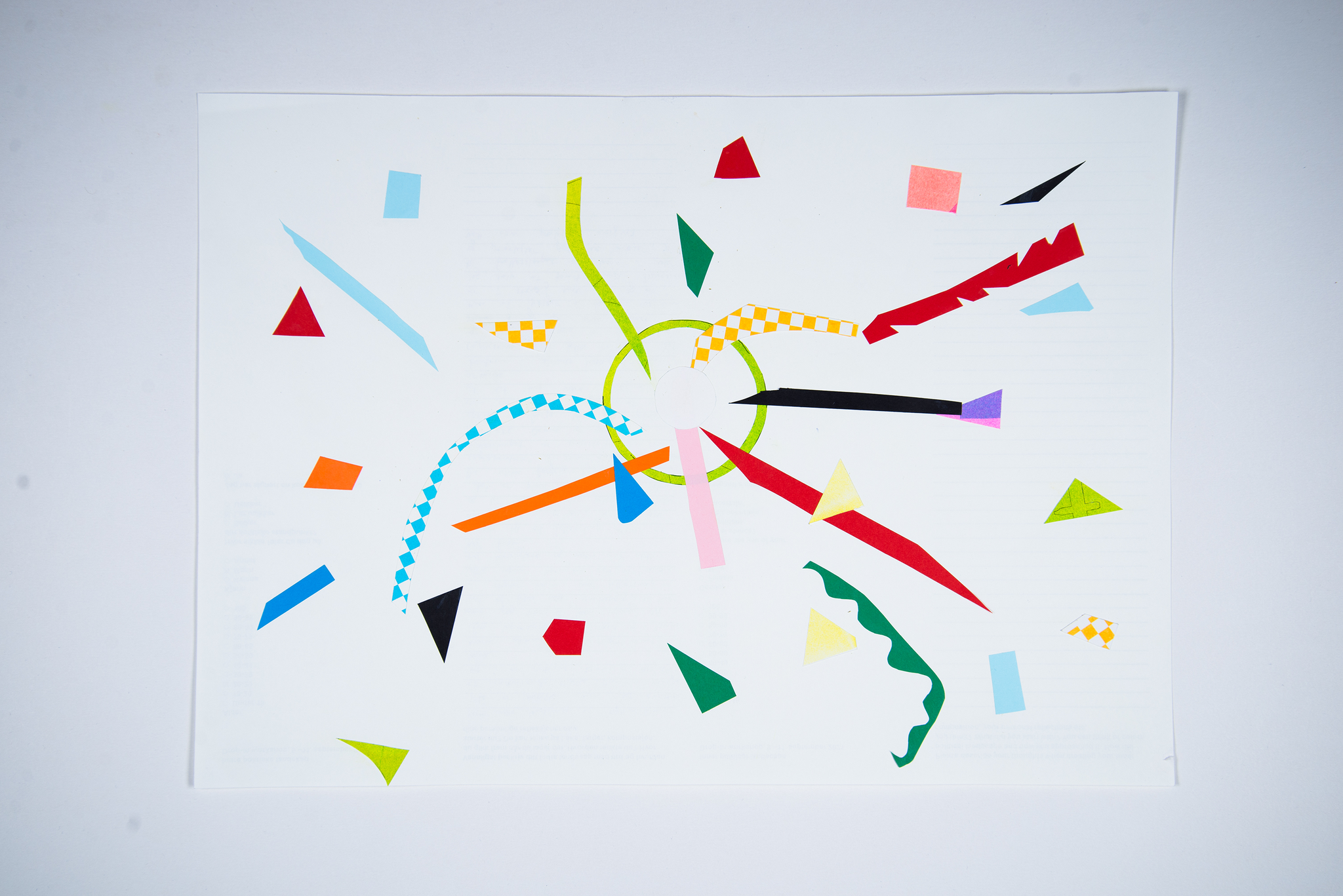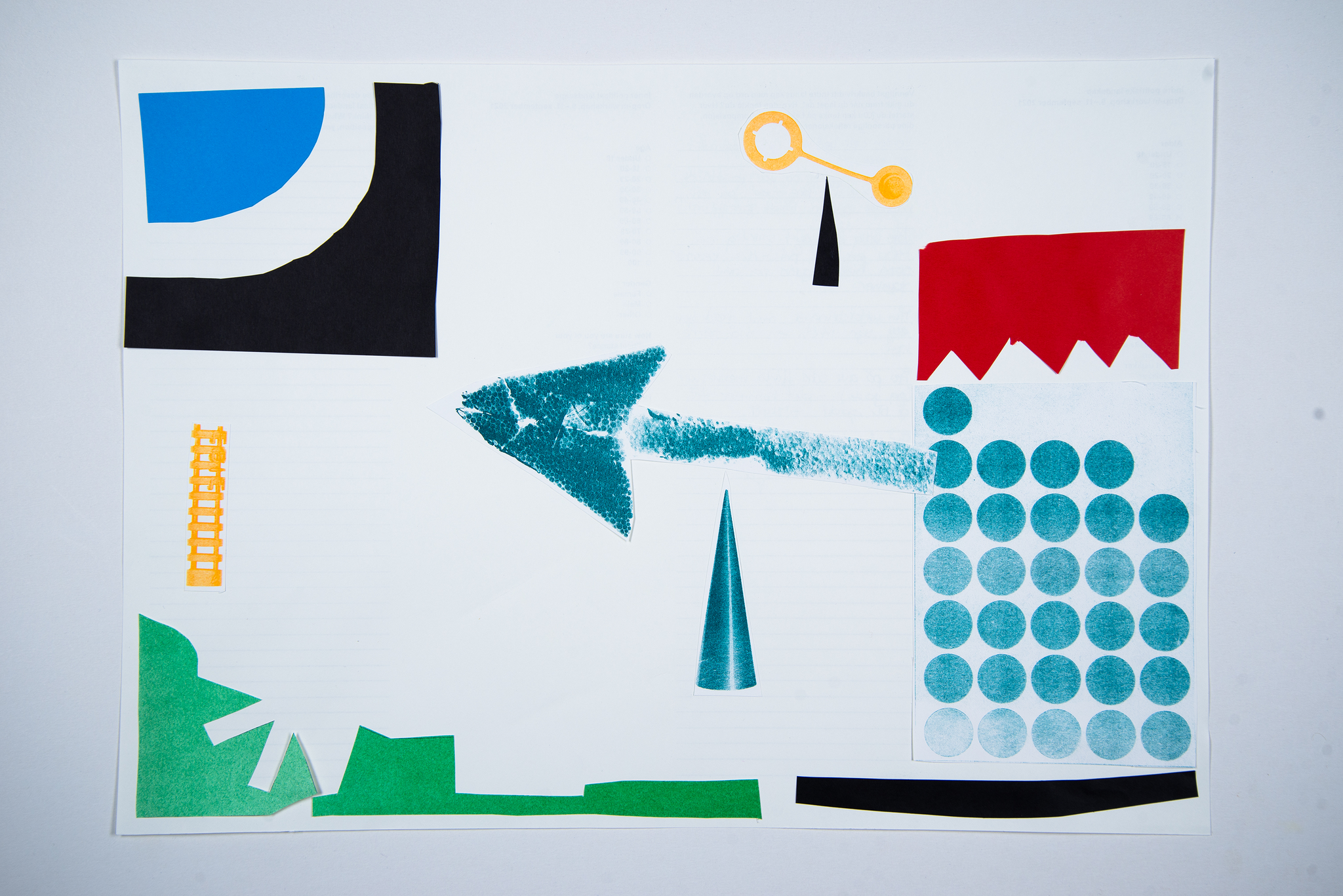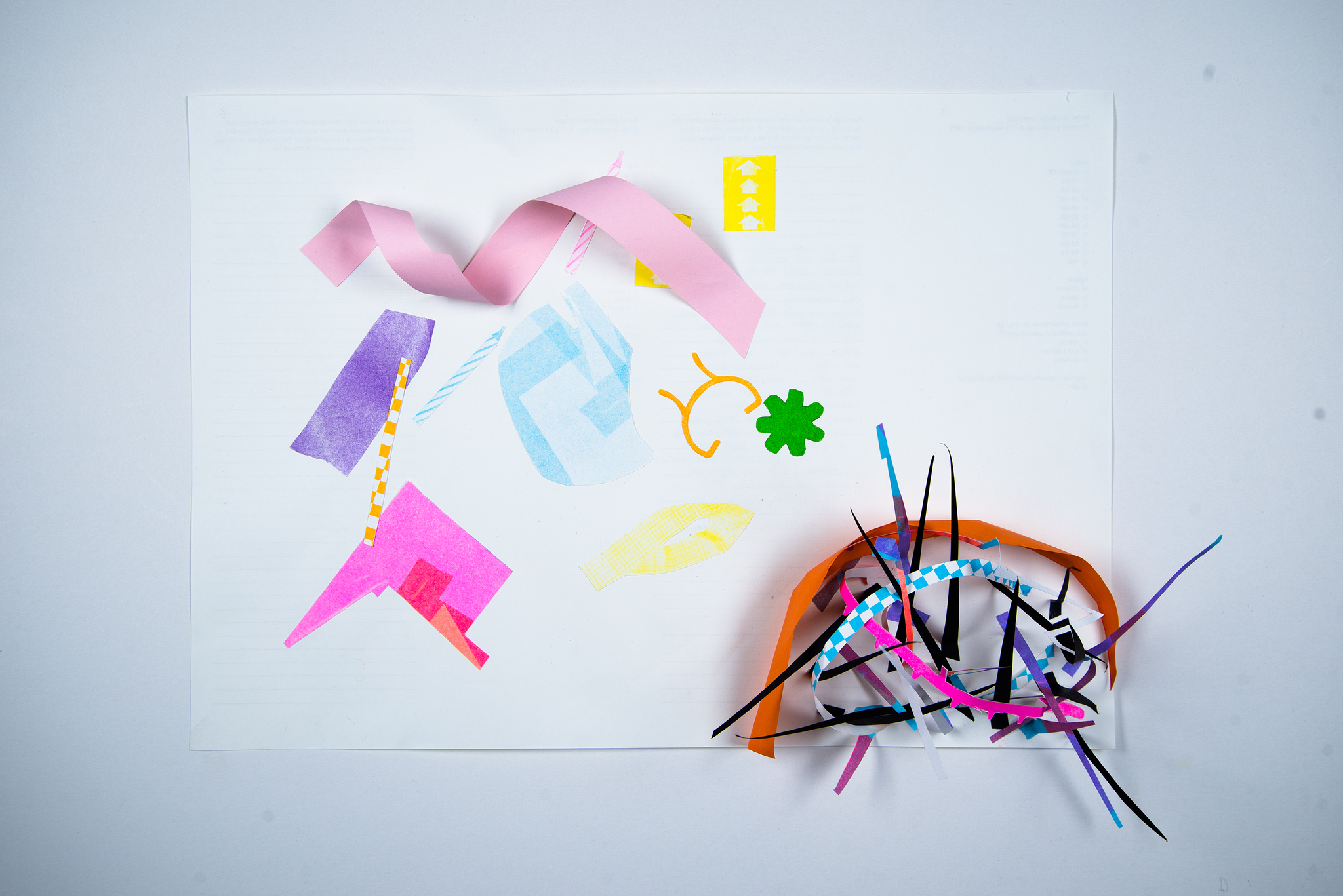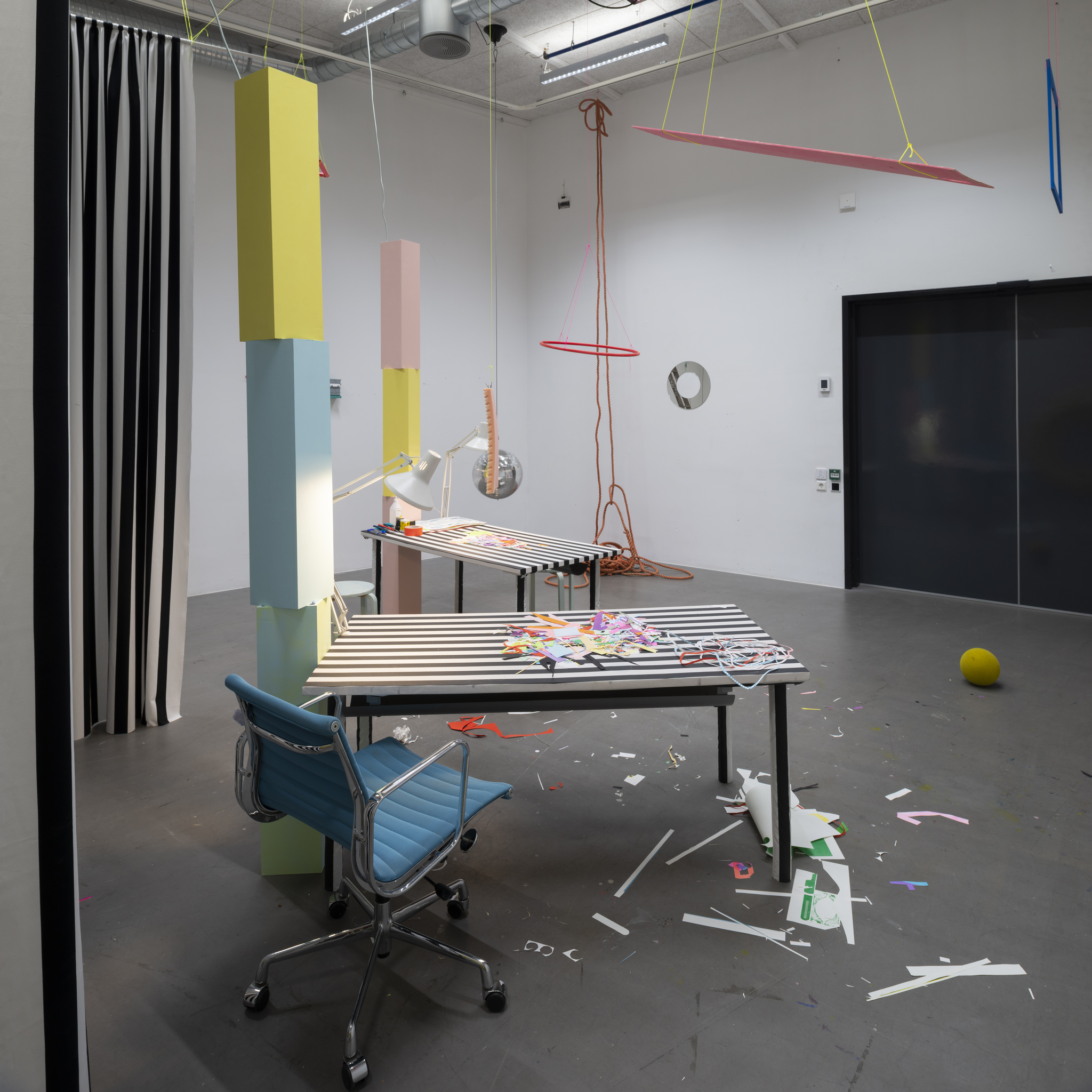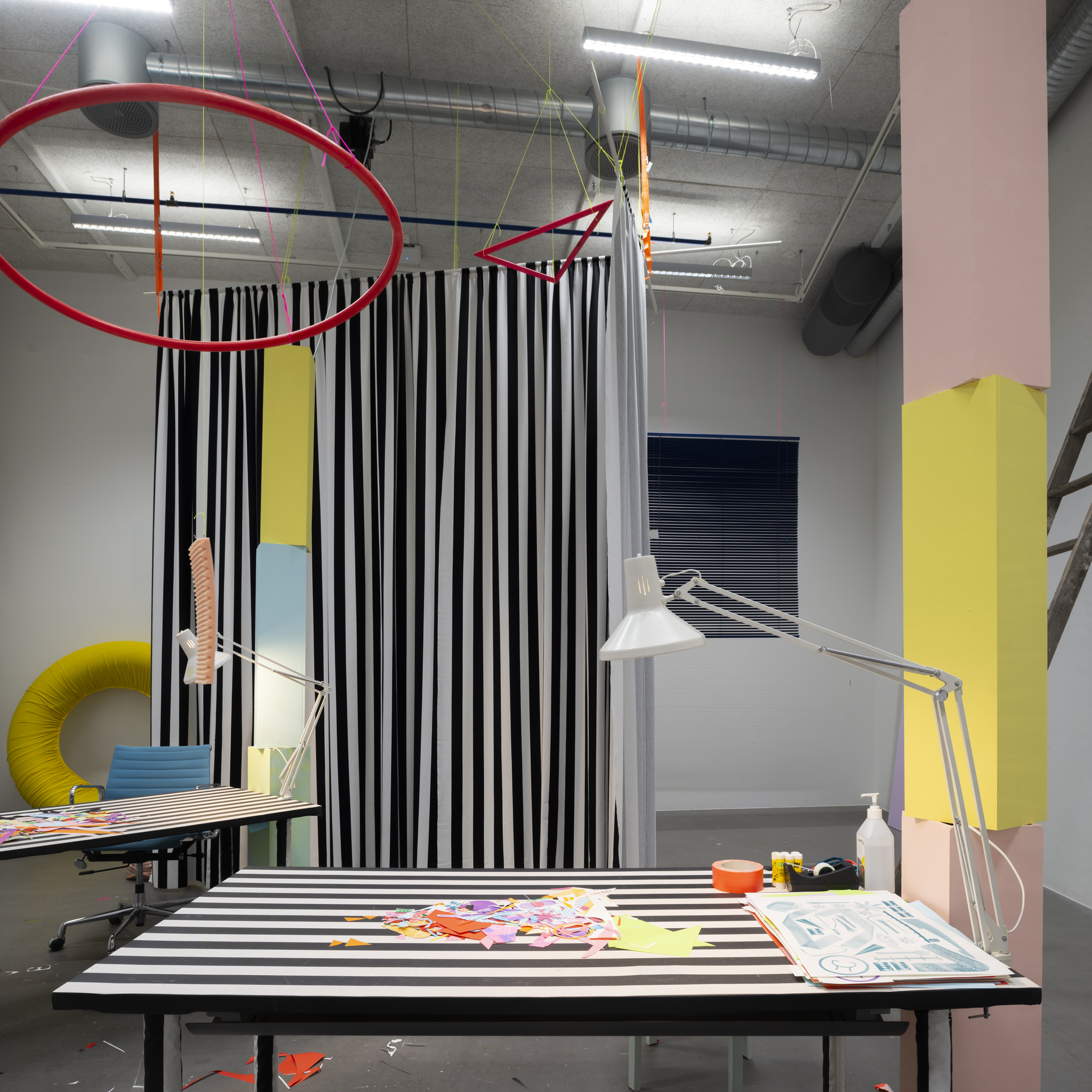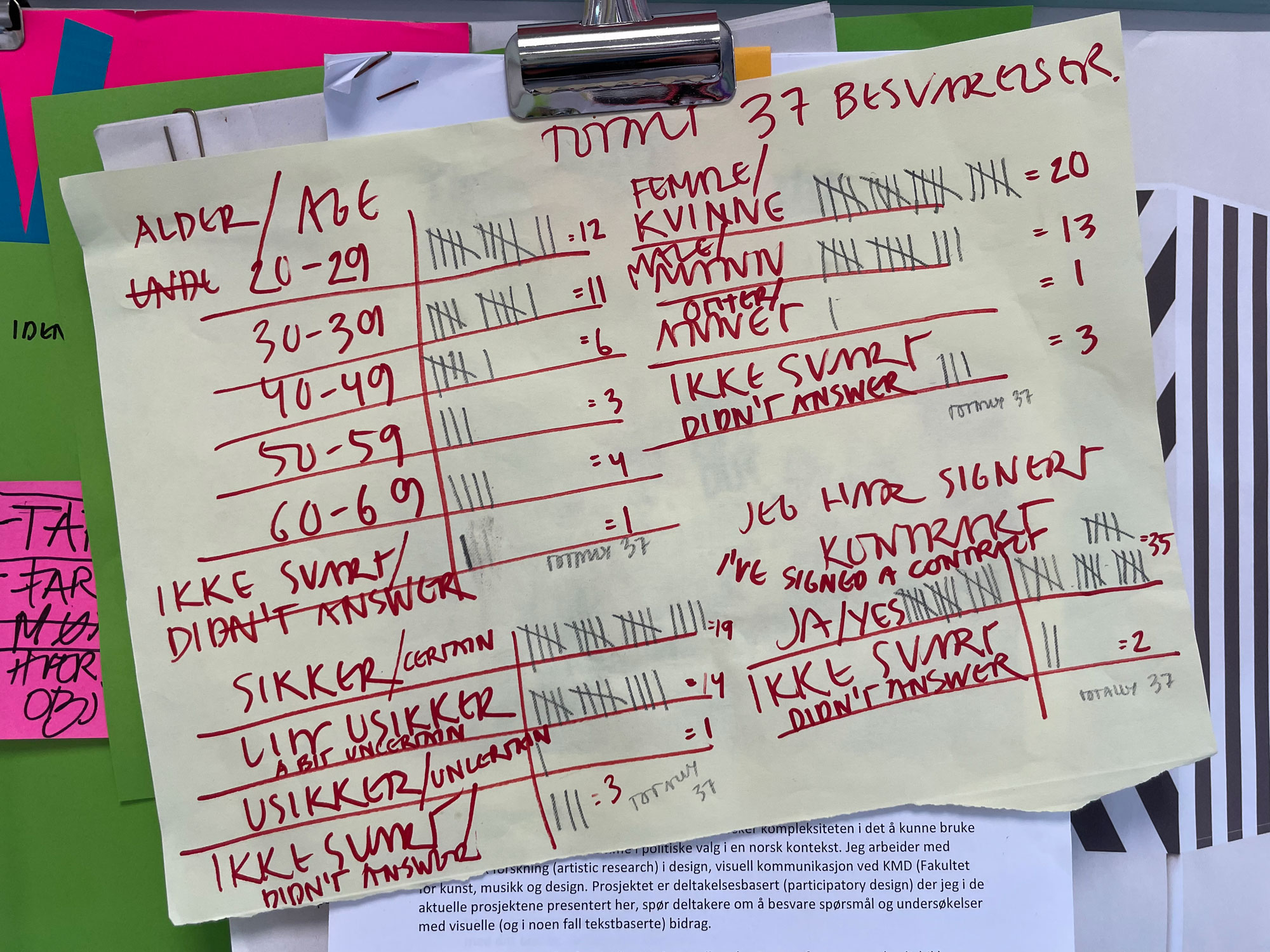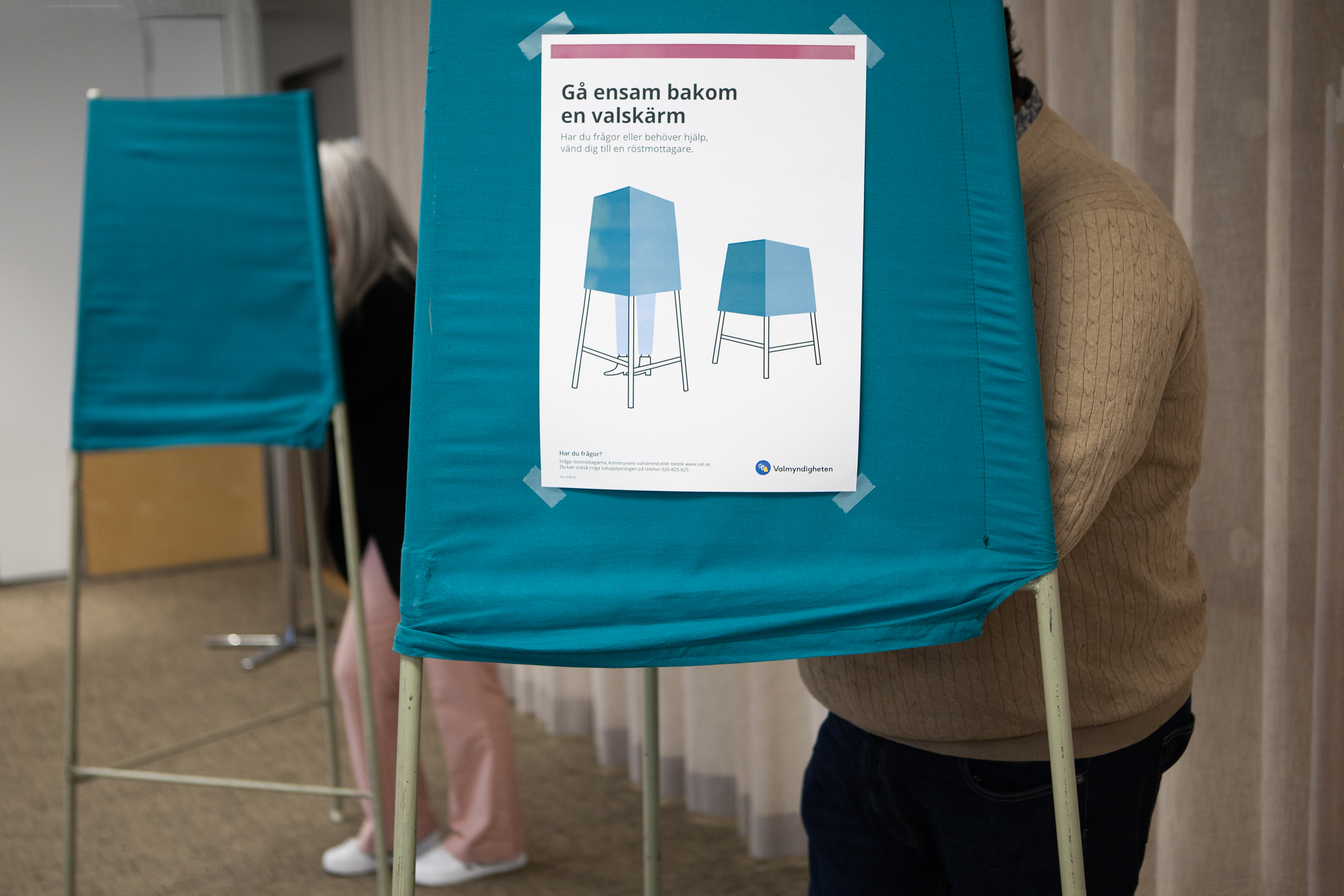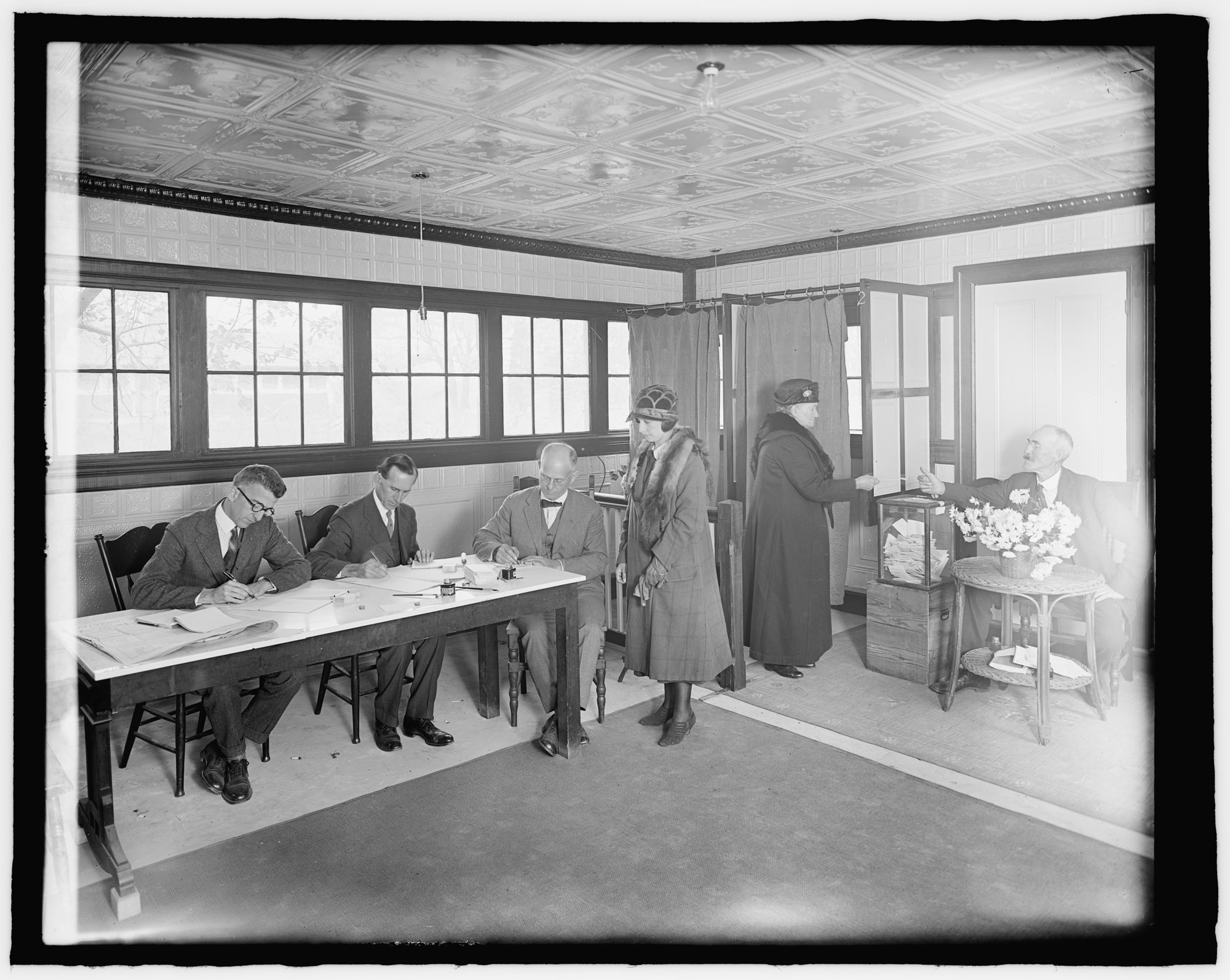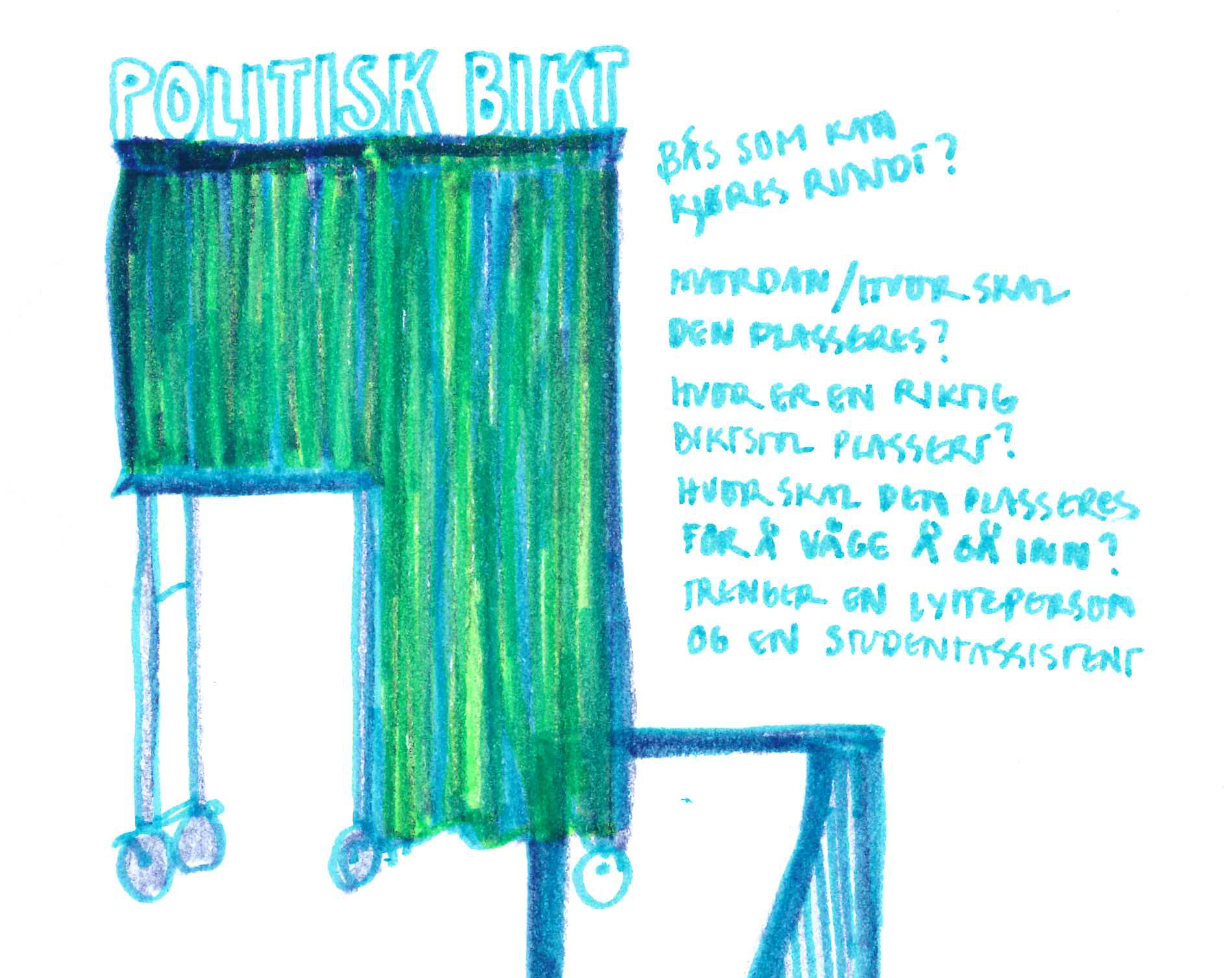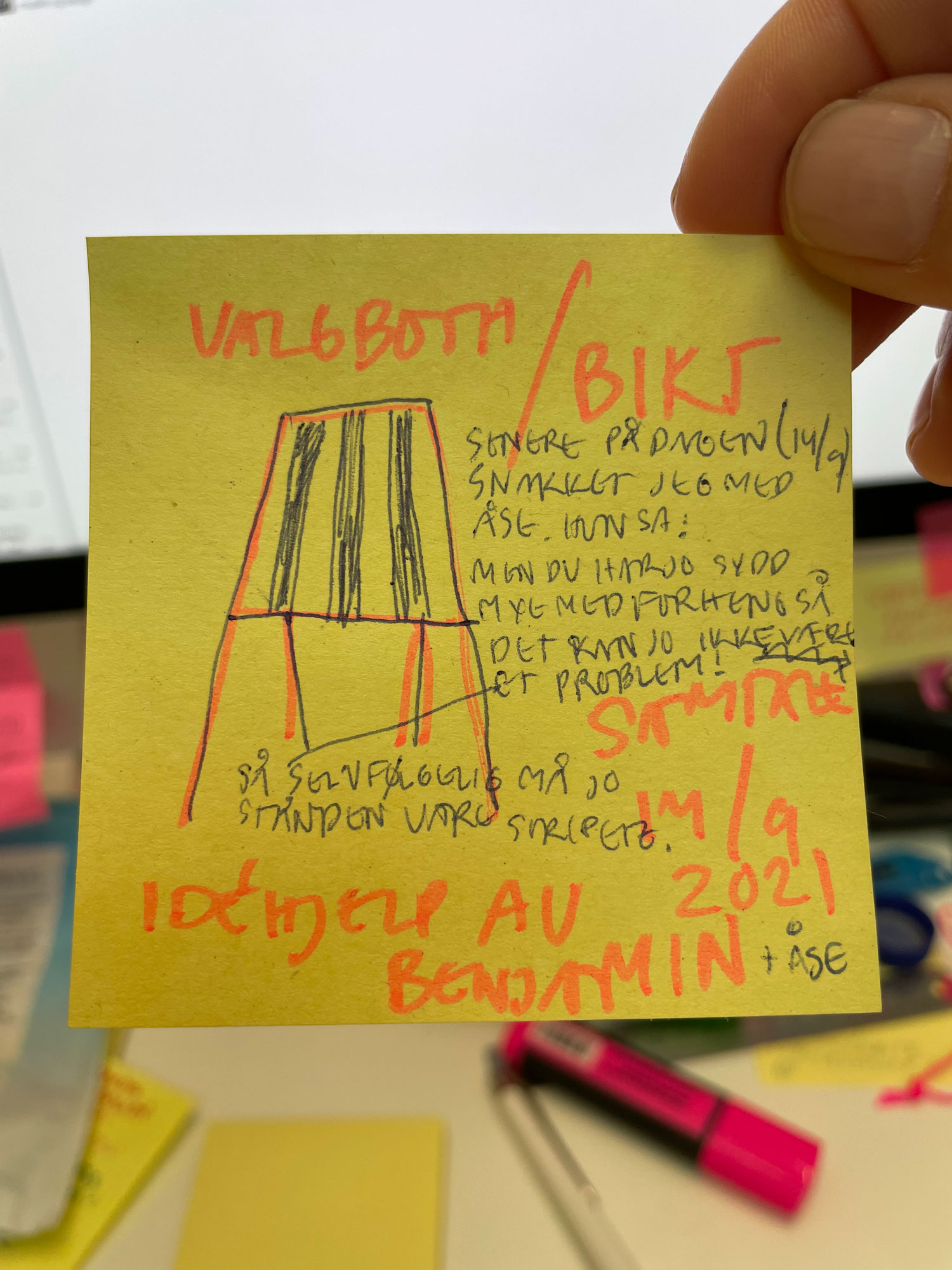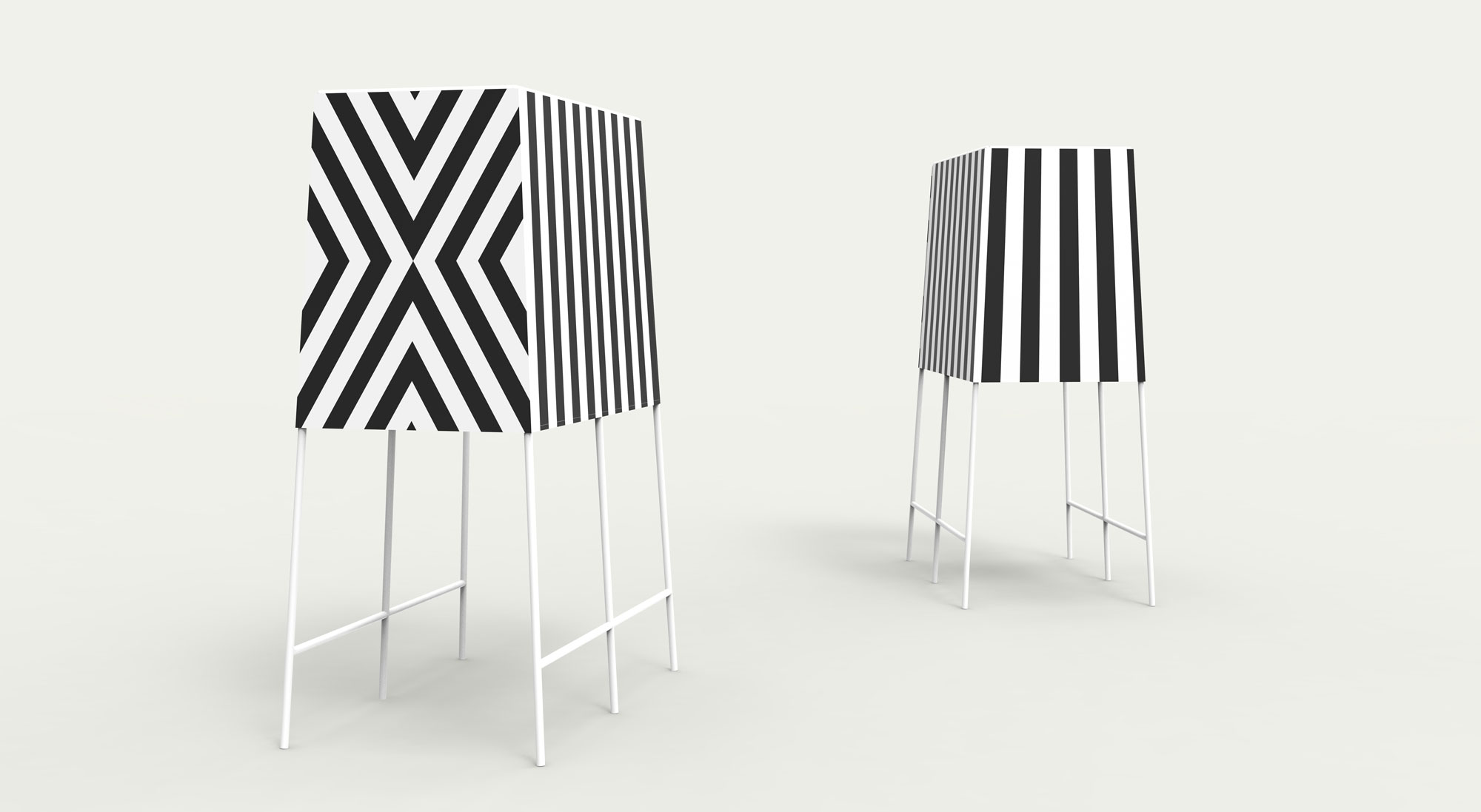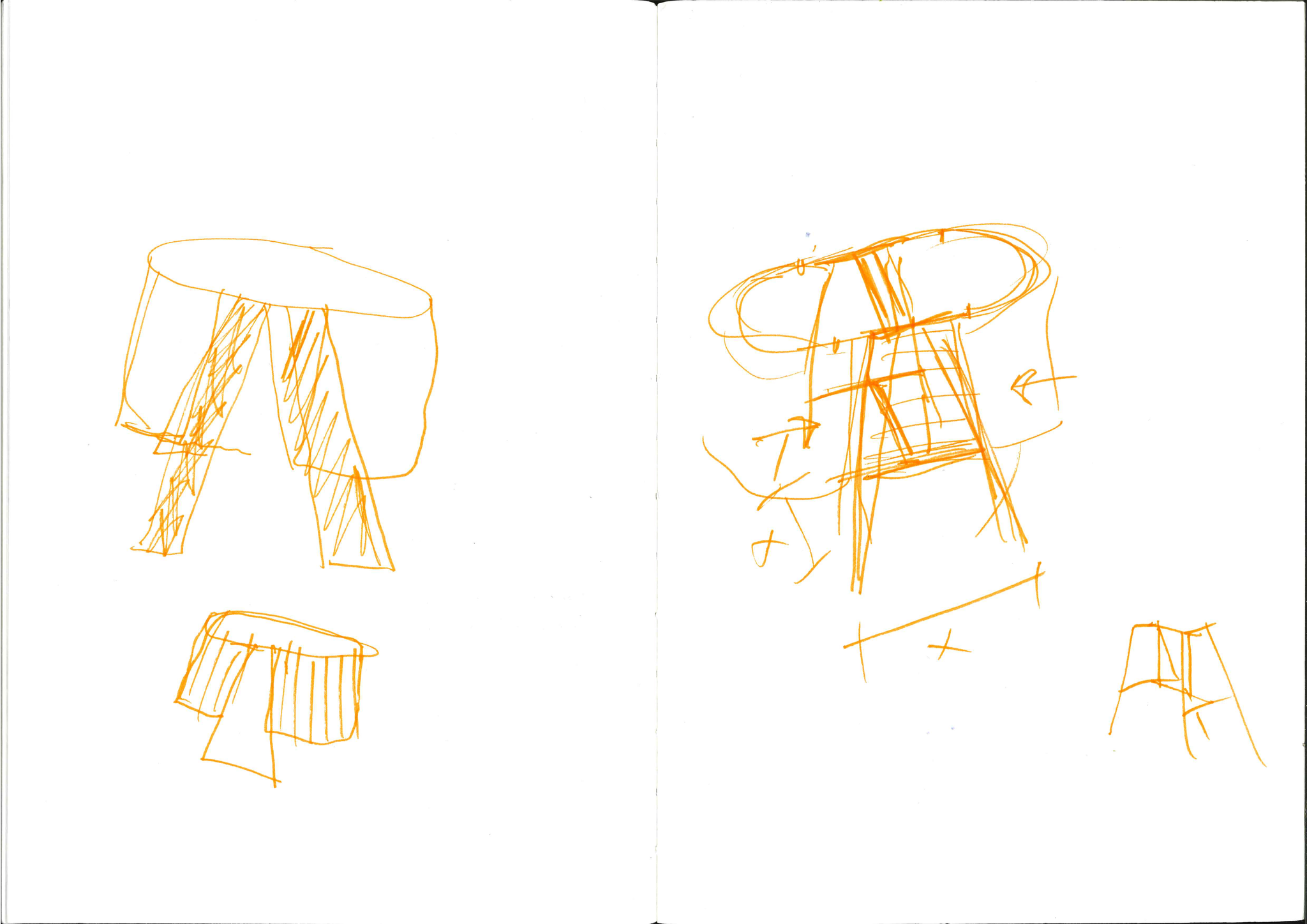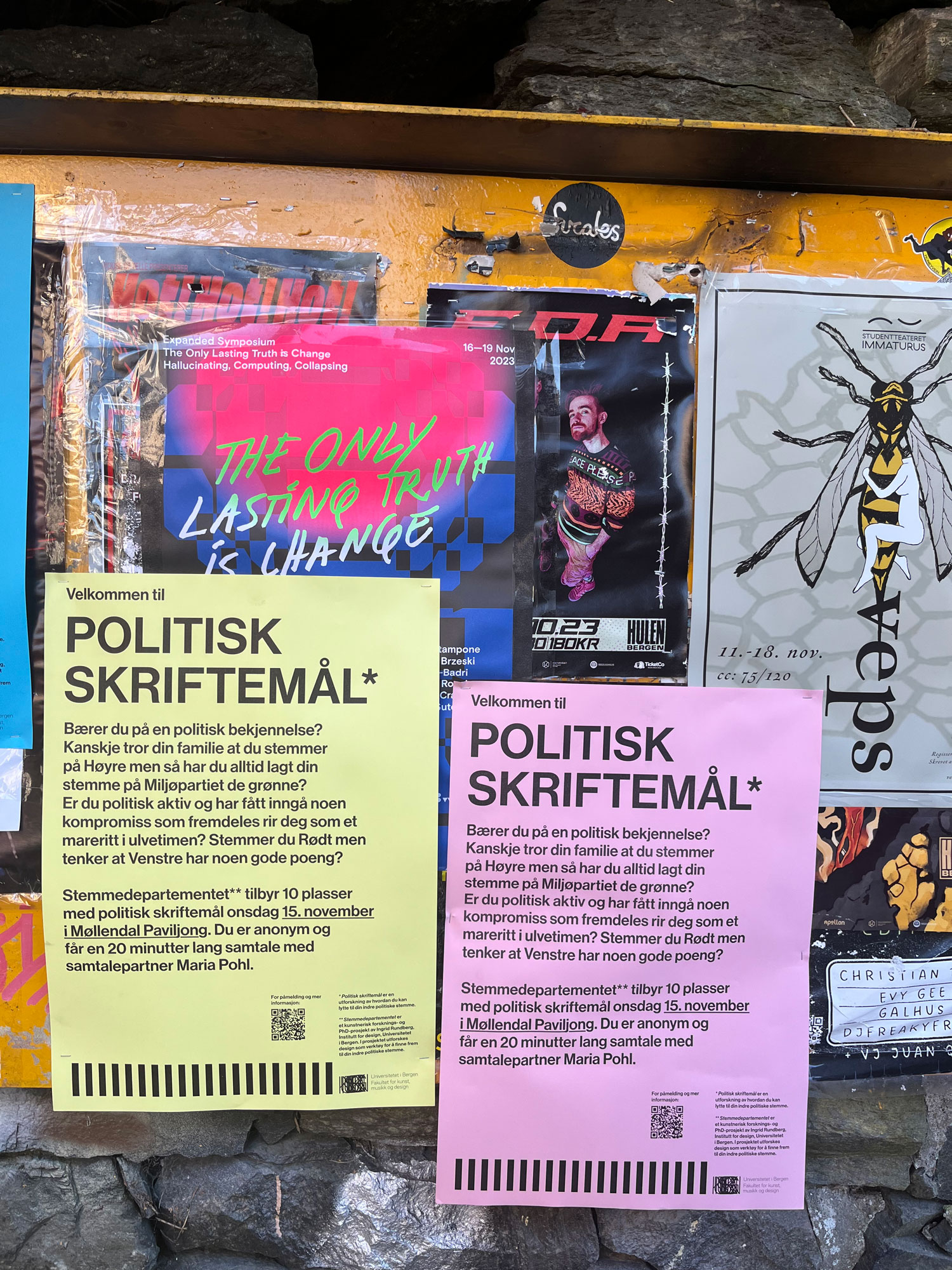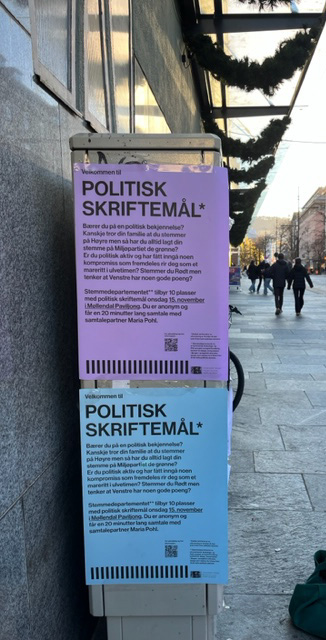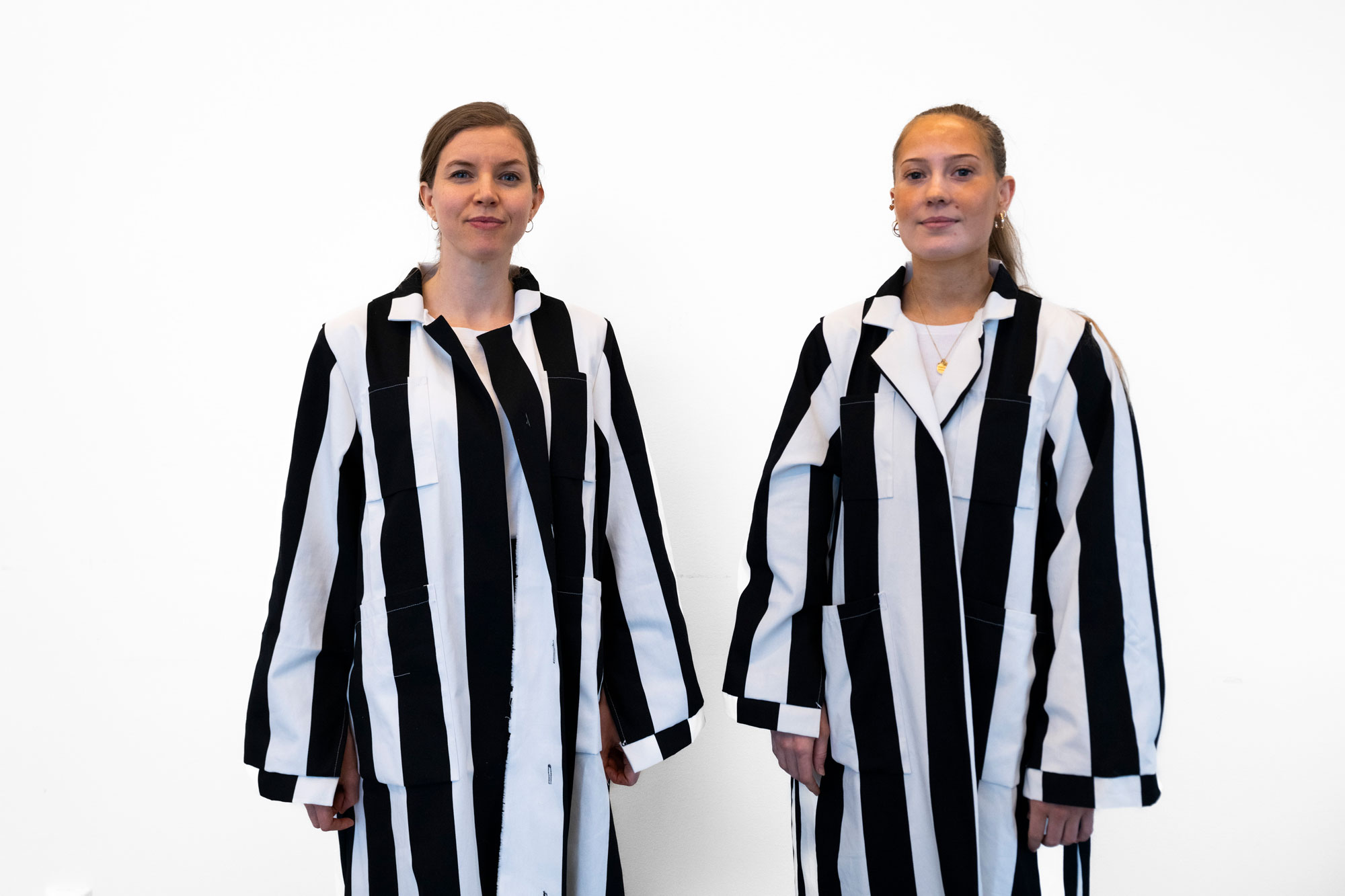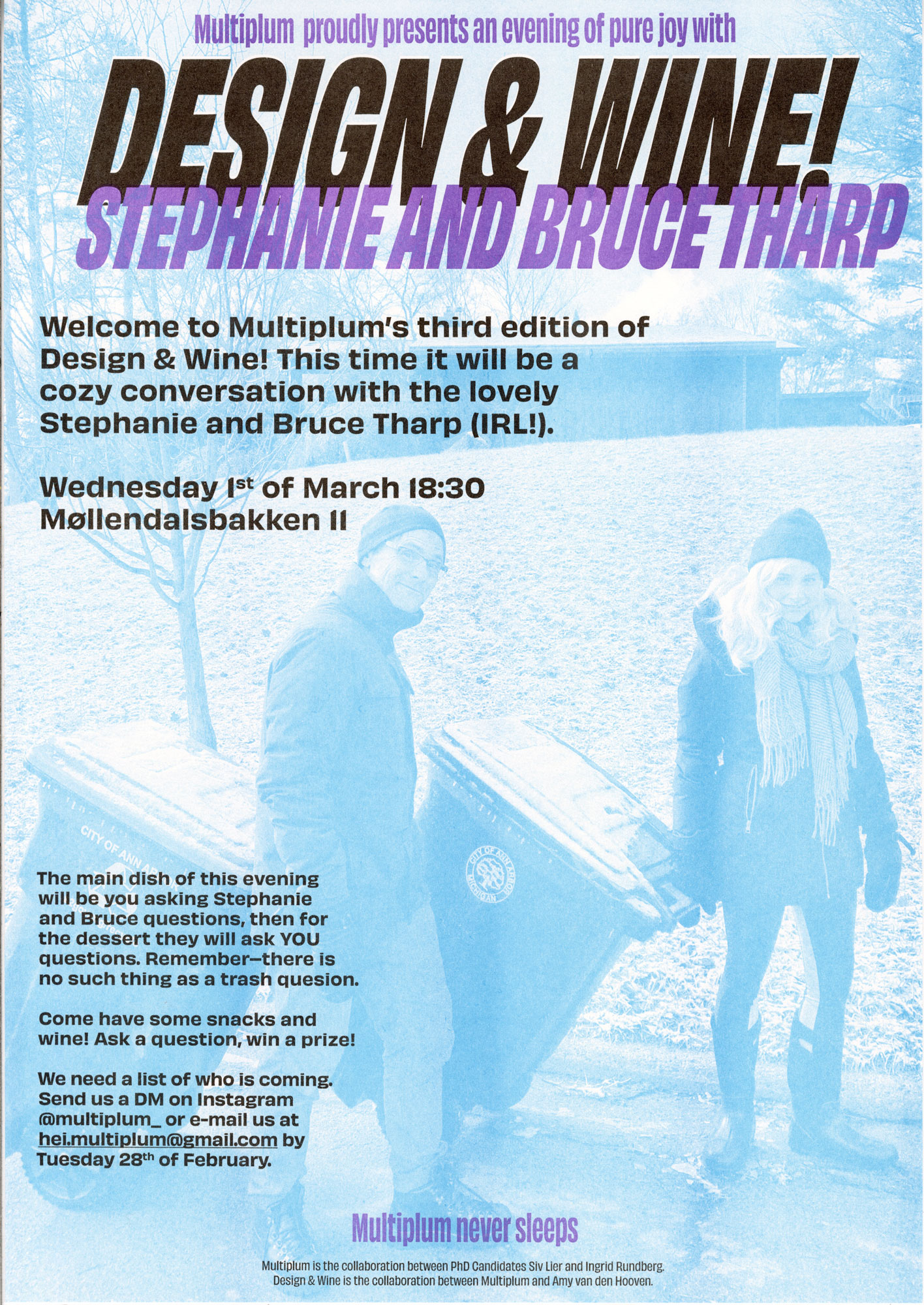This chapter outlines the five practical experiments I conducted for my PhD project and the empirical evidence that those sub-projects resulted in. I present the sub-projects chronologically, as each one built upon the findings of the previous. All five experiments were conducted in a participatory setting, in public spaces. As they differed in character, content, and degree of participatory interaction, I present each one individually. I also discuss the ethical dilemmas of each experiment.
My first sub-project was a lecture series that I conducted in partnership with the Bergen Public Library, with financial support from the Fritt Ord Foundation. Holding the lectures at a library allowed me to transcend the confines of my secluded studio and engage with a broader audience. For my second sub-project, I collected contributions for the participatory publication Voices. The third sub-project was the Inner Political Landscapes workshop, during which participants got to explore collage landscapes as a metaphor and possible means of listening to their inner political voice. Parallel to these experiments, the concept of the Stemme Department materialised. This fictional department took on a visual identity (a strong graphic pattern, specific furniture, a uniform), got a name, and eventually had specified tasks. Sub-project four, the Political Confession work, was conducted ‘by’ the Stemme Department. Last but not least, there was Multiplum! (M!). This sub-project was conducted in collaboration with my PhD colleague Siv Lier, which is also why we co-wrote the M! chapter. While M! was a multifaceted experiment, we chose to write about just one part of it, the Design & Wine events.
The practical experiments that I conducted contributed to the insight that citizens need a space for political introspection, and that the Stemme Department can serve as that space. Both the sub-projects as well as the department's very existence prove that the dual theory of adversarial design should be expanded with a third field/area/space that accommodates the fact that design can borrow characteristics from both political design and design for politics.
My practical work helped me understand my own design process (visualised in fig. 4.1). While I did not develop the below model until later on, I wanted to present it already here, to make my reasoning clearer and show how one decision led to another.
This chapter describes ‘Things That Might Be True’,7 an exploratory series of three lectures held at Bergen Public Library in 2019, during which three lecturers each addressed a particular question. In the following pages, I will discuss the preparation behind these lectures, the speakers, my execution of the experiment, and the project’s documentation and outcomes. I also discuss the lectures’ promotional poster, which led to a surprising attempt at contact by a rather unusual citizen. This sudden encounter led to a lengthy ethical discussion and raised numerous questions. ‘Things That Might Be True’ not only answered the questions that it discussed, but also united an audience around a specific area of interest—politics and democracy. This audience was later invited to participate in the subsequent practical experiment(s) that together make up my project.
At the very start of my PhD project, I organised a series of lectures at the Bergen Public library. As I did, I had three goals in mind:
(1) To gather knowledge about the factors that
influence citizens’ political opinions;
(2) To explore public lectures as a method for
dialogue and for the collective acquisition
of knowledge;
(3) To investigate how groups are formed and
gather around different themes based on
personal interests.
The series took place early on in my project, at a time when I was keen to learn more about the factors that influence voters. By hosting the lectures at a library, I got to explore this question in public, in the presence of an audience, rather than in my studio.
The reason I opted for a library was because libraries tend to be open spaces, with a diverse visitor base (people of different ages and backgrounds) and a particular mission. One of the Bergen Public Library's goals is to be an independent meeting place and a venue for public conversation and debate (Folkebibliotekloven 1985/2013).8 This aligned with my sub-project’s second goal. As a place that facilitates public conversation and debate, the library would allow me to connect with people interested in the factors that influence citizens’ voting preferences—the sub-project’s first goal.
The lectures were held over the course of three days, in the runup to Norway’s municipal and county council elections9 of 9 September 2019. They took place in the library's Amalies Hage café, at 18:00 every evening. These times, plus the public library’s central location (between the train station and the Storsenter shopping centre), enabled people to attend after work or school. Three different lecturers held one presentation each, during which they discussed a particular question. I had mentioned these questions in the events’ promotional materials (posters and online) and also presented them as I introduced the lecturer at the start of the evening. Each presentation lasted approximately 45 minutes. Afterwards, the audience got to ask the lecturer questions. The discussions were facilitated by me.
Ida Vikøren Andersen
“Why don't I understand what they're saying?”10
About political rhetoric
During the first lecture, Ida Vikøren Andersen introduced the basic tenets of political rhetoric and common rhetorical strategies that politicians use to deflect criticism and to avoid having to present their own arguments. Vikøren Andersen shared videos of well-known Norwegian and Swedish politicians using various rhetorical strategies in different situations. At the time of the lecture, Vikøren Andersen was a fellow at the Department of Information and Media Studies at the University of Bergen, doing research on social media, TV, and radio debates.
Bente Kalsnes
“What is true?” 11
About fake news
Next, Bente Kalsnes spoke about the challenges of dealing with fake news on the internet and in social media. Different meanings of the terms ‘fake news’, ‘post-truth’, and ‘alternative facts’ were discussed. Kalsnes shared tips on how to recognise fake news, and explained how fake news stories tend to be fabricated and spread. Kalsnes is Professor in Political Communication at Høyskolen Kristiania and author of the book Falske nyheter (Kalsnes 2019).
Thomas H. Kleppestø
“Why are people different?” 12
About evolution and political attitudes
In the third and final lecture, Thomas H. Kleppestø spoke about how evolution has helped make certain traits—like having two eyes—universal in humans, while other traits—like personality and political beliefs—vary from person to person. Kleppestø went on to discuss how the environment, genetics, personality, and many other factors influence people’s political attitudes. At the time of the lecture, Kleppestø, who is a psychologist, was a PhD candidate at the Department of Psychology of the University of Oslo, where he conducted research on behavioural genetics and evolutionary psychology.
I wanted to invite people to this sub-project based on their personal interests and engagement with specific issues. Parameters like participants’ age, gender, and socioeconomic status mattered less to me. The idea that a public is shaped by the questions one asks was first presented by John Dewey, in the book The Public and its Problems (1927). It was further developed in a design context by Carl DiSalvo in Design and the Construction of Publics (2009). A public can consist of people from the most diverse backgrounds and social groups, with wildly different ages and interests: it is the question that is being asked that brings them together (DiSalvo 2009, 50). By asking questions and engaging people, a project intersects with the public and starts a dialogue. Before it can act and have a voice, a public must first be formed.
Each of the three lectures was attended by approximately 45–50 people between the ages of 17 and 70 (fig. 4.2-4.4). On two occasions, secondary school students and their teachers attended. I invited people via email, Facebook, Instagram, and through the library's own information channels. The latter were monitored and managed by the library’s own staff. I also put up posters (fig. 4.5) in the centre of Bergen and created a website (tingsomkanværesant.no) (Rundberg 2019c) for the series, which was mentioned on the posters and on Facebook. (The website was created for the sole purpose of promoting the lectures and has not been updated since.)
To try and establish a somewhat consistent group of participants for my overall PhD project, I invited everyone who attended the lectures to also participate in my next project, the Voices publication.
Here are the posts I created to promote the event on Facebook:
Ida Vikøren Andersen
“Why don't I understand what they're saying?”
Bente Kalsnes
Thomas H. Kleppestø
The vibrant layers of the promotional poster (fig. 4.5) contained the three questions that the lectures would be discussing: “Why don't I understand what they're saying?” (fig. 4.6), “What is true?” (fig. 4.7), and “Why are people different?” (fig. 4.8). I first created the illustrative text by forming words with black plastic tape, to evoke the characteristic aesthetics of protest signs (fig. 4.9). I then scanned and digitally processed these taped sentences, before finally adding practical info on the lectures, in black. The poster was printed using risography (fig.4.10-11). It consisted of four A3 sheets, which were taped together post-printing to form one A1 sheet.
THE SCRIBBLER
To promote the lecture series, I designed and put up a poster across Bergen. As I walked around taking pictures of the posters to document them, however, I noticed one of them had been scribbled on with a marker (fig.4.12). Even the wall behind the poster was covered in writing (fig.4.13). A new actor in the project emerged: the Scribbler. This came as a surprise to me, because people don’t usually engage in such lengthy discussions with graphic objects.
The Scribbler’s writing looked hurriedly unfiltered and sprawled across the entire wall behind the poster. In a vociferous way, the Scribbler wrote about feeling excluded. He mentioned being banned from the comment fields of several national Norwegian newspapers and NRK (Norway’s public broadcasting company), as well as from dodgier websites like document.no and resett.no. He called Jens Stoltenberg (the country’s former prime minister and current Secretary-General of NATO) Norway's very own Epstein—a reference to Jeffrey Epstein, an American financier who died in detention in New York City in 2019 after being charged with sex trafficking. The Scribbler had also changed the name of the lecture series from “Things That Might Be True” to “Things That ARE True”.
After briefly browsing the internet, I managed to establish the identity of the Scribbler (whose wall scribblings contained hints on how to contact him). Should I get in touch with this man and ask him to participate in my project?
Not including the Scribbler might suggest I was biased and only wanted to work with people who wanted to have an open-minded conversation and seek answers together. People who would be used to and familiar with the rules of public lectures. People, in other words, just like myself, with a more or less similar agenda. Including this anonymous writer, on the other hand, could open doors, make my work more diverse, and help me reach participants from a broader range of cultural backgrounds. At the same time, the project risked becoming much harder to conduct, as we might veer off on an anti-democratic path.
I told myself that, as the person in charge of the project, I needed to protect both the project and its participants. But who was I really trying to protect? Myself, the experts, the audience, the project, or this unexpected new actor—the Scribbler?
The fact that an anonymous person—the Scribbler—wrote on one of the promotional posters for the lecture series highlighted my dilemma of who to invited to participate in the sub-project. The incident made me feel rather strong emotions. Initially, I felt ashamed at the thought that my project might not be inclusive. Then I found myself afraid of what might happen if I did invite the Scribbler. I was also confused, because I didn’t know how to handle the situation.
I eventually brought up the dilemma during an ethics seminar at the Norwegian Artistic Research School in October 2020. As we discussed the matter, someone in the group argued that there was a perfectly valid reason not to contact the Scribbler: inviting someone with a world view that was so completely different from mine could put the project at risk and make it veer off in a direction I was uncomfortable with.
It was only after pondering the matter for a long time that I realised my fellow scholar was right. In Therefore Democracy13, philosopher Åsa Wikforss writes that “the right to express oneself does not mean others are obliged to disseminate what one says” (2021, 312).14 This is reflected in the concept of freedom of speech and everyone's right to express their own opinions, as laid down in the Norwegian constitution § 100 (Grunnlov 1814/2023). While there is freedom of expression in Norway, my project does not need to be a mouthpiece for ideas that do not align with its core idea. Spreading conspiracy theories can even directly harm democracy.
Wikforss argues that conversation has a different role on the individual level than it has in the public sphere. In individual, private conversations, the starting point is (usually) a quest for mutual understanding. In official conversation, the starting point is argumentation (2021, 285). A PhD project is a research education; its conversation is official and revolves around arguments. The Scribbler’s writings were an example of conspiracy theories (see the comparison between Stoltenberg and Epstein, for example). My project is about how design can empower citizens to engage in political introspection, discussion, and dialogue. I was fairly convinced the Scribbler was engaged in political introspection, but suspected that the voices he listened to consisted mainly of echoes of alternative facts and fake news—which are a threat to democracy. Giving conspiracy theories a platform without countering them with arguments would risk changing the direction of my project in an unintentional but highly significant way.
As for the ethical aspects of my interactions with the lectures’ audiences and the lecturers, everyone was informed of the fact that the lectures were part of a research project. The audience was told that the lectures would be recorded—and as the venue was relatively small, the photographer could not have escaped anyone’s attention (fig. 4.3). Audience members who did not want to be filmed or photographed were asked to sit at the back of the room.
As I implemented the lecture series at the Bergen Public Library, I actually took on three different roles: that of producer, of curator, and of graphic designer. As the sub-project’s producer, I successfully applied for support from the Fritt Ord (‘Free Speech’) Foundation. I planned the lectures, had them documented by a videographer, and coordinated the entire process with the library. As the series’ curator, I selected the themes to be discussed and picked the speakers. I then presented these proposals to the library's Event Coordinator for approval. Last but not least, I served as the series’ graphic designer, which meant I developed a visual identity for the lectures, did the poster’s textual graphic design, and took care of the risograph printing.
Others helped me by putting up posters in the city centre, and editing and uploading the lecture videos on YouTube. (The initial edits were done by Renato Fogliani, after which Mads Andersen made additional edits and the typesetting.)
The lecture series’ first goal was to gather knowledge about the factors that influence citizens’ political opinions. One issue related to this goal is the question of whether or not the dialogue that took place at the library was genuine, or whether the roles of the lecturer(s) and the audience were too static for true dialogue to take place. The audience might have been a tad passive; this wasn’t participants’ fault, though, but rather a consequence of the setup, whereby the audience was required to sit and listen to the expert on stage. Once the lecture had ended, the audience did get to ask questions. Still, this more active moment did not automatically transform the lecture into a dialogue or conversation between the lecturer and the audience, as the former remained the expert. Still, I see Q&As as a sign of interest, curiosity, and wonder on the part of the audience. Bringing together people based on shared interests proved effective, as evidenced by the rather diverse audience that attended the lectures. I did not strictly measure who attended, nor did I set specific parameters for attendance, but I can mention that a diverse group of men and women between the ages of 17 to 70 participated.
The second goal of the sub-project was to explore public lectures as a method for dialogue and for the collective acquisition of knowledge. As I had to both moderate and present the lectures, it was hard for me to fully engage with the lectures’ actual topics in the moment.
My own learning primarily happened during the preparatory and concluding phases. Before the actual lectures, I explored which topics might be interesting and which experts might be able to present those topics. After the lectures, the video recordings helped me learn more about the themes that had been discussed. During the actual lectures themselves, my focus was on more practical aspects rather than the topics themselves. (I did not measure whether the audience gained any new knowledge from the lectures.)
The third and final goal of the sub-project was to gather people around a certain theme, based on people’s personal interests. In this case, audience members and experts all met at a central location (a library). Unexpectedly, an additional person also voiced their opinion, albeit anonymously. The so-called Scribbler wrote on one of the posters I had put up in the centre of Bergen, using the poster as a space to express his thoughts, opinions, and conspiracy theories. His message (which I assume was directed at all passers-by rather than just me) made me acutely aware of who I had (not) invited to participate in the project. This raised questions about participation, democracy, and ethics. The incident made me realise that a project about democracy has to be carried out on democratic grounds. Excluding someone with a conspiratorial agenda is still a democratic act, even though it may not seem so.
After the lecture series at the library, I invited the audience and lecturers to participate in my next sub-project, the Voices publication. In this sub-project, my focus shifted from major theories in rhetoric, evolutionary psychology, and media theory to a more personal and individual narrative. I reached out to the general public, posing the question “How do you find your (political) voice?”. Participants were asked to submit their response in a printable form, as I wanted to turn the results into a publication. This chapter explains how I collected the data, describes the results, and divides the submitted contributions into different categories.
I reached out to people during the autumn after the Norwegian municipal and county council elections of 2019, as my question was related to these elections.
My survey had three goals:
(1) Create a visual archive of how eligible voters decided how to vote in the municipal and county council elections of 2019;
(2) Establish a visual starting point for the rest of my PhD project;
(3) Continue investigating how groups are formed and how they gather around themes based on personal interests.
Several others before me had published similar participatory books to present different people’s responses to the same question. One example is En dag i Sverige (‘One Day in Sweden’) (fig. 4.14), in which participants from Sweden document what they did on Tuesday 3 June 2003, through photography.
Professional and amateur photographers feature side by side in the book. A man walks his two dogs (fig. 4.15), trains are sprayed with graffiti, children are born, someone lights a cigarette. The book is divided into chapters that follow the course of a day: night, early morning, morning, afternoon, and evening (fig. 4.16). Each image is labelled with a geographical location, the moment the photo was taken, and a brief text. Mundane, serious, humorous, and strange images converge in this simple concept, resulting in a participatory documentary photo book that also resulted in an exhibition. All the images were archived in Sweden’s state archive (Riksarkivet) (Karlsson 2003, 254).
Another example of a participatory publication is the Subjective Atlas series ("Subjective Editions") (fig. 4.17) by Annelys de Vet. This series consists of several books that are each dedicated to a specific location, like Palestine, Brussels, the EU, or Luxembourg. The books contain personal contributions from people living in these areas, who describe the places they inhabit. Photographs reflect everyday life, showing things like windows with a particular type of curtains (de Vet 2018, 84-85) (fig. 4.18).
The Luxembourg book contains illustrations of the country’s road signage system, for example (de Vet 2019a, 116-117) (fig. 4.19), and photos of people talking into their smartphones (de Vet 2019a, 134-135) (fig. 4.20). But the books also contain a political dimension. In the Subjective Atlas of Palestine, the Israel-Palestine conflict is evident in several participants' contributions. One section suggests architectural ways to repurpose the wall that divides Palestine and Israel, for example (de Vet 2019b, 102-103) (fig. 4.21). In the preface to the Subjective Atlas of Luxembourg, I read:
Maps play an important role in how we identify ourselves: they are part of the discourse, the talks that shape our world. And thus, no single map should be dominant. The identity of a given region should be based on a multitude of notions in which we as citizens, as people in and/or of the region, should have agency, at least in part. (de Vet 2019a, 6)
The series provide readers with a subjective description of places, rather than a traditional map that tries (or at least appears) to objectively visualise an area.
Both A Day in Sweden and the Subjective Atlas series served as inspiration for my idea to explore how people find their (political) voice through participatory visual material.
My sub-project’s invitation explained to people that their contribution might be featured in a publication, and that each person would be allotted a full page. The invitation also specified the format for submissions, the deadline, and other practical information. I verbally invited people during the aforementioned lecture series at the Bergen Public Library (Chapter 4.2), and put printed invitation brochures (fig. 4.22) on the tables in the café where the lectures took place, along with a registration card (fig. 4.23). These cards were collected after each lecture. I also created a Facebook event (Rundberg 2019a) invited people via email, and set up a website (Rundberg 2019c), where interested participants could learn more about the project.
The question mentioned on the invitation was “How do you find your voice?”. Because this was a rather vague question, the invitation text clarified that I was asking people about their political voice (app. 1 ((Norwegian)) and app. 2 ((English)). Later on, during the implementation phase, I changed the question to “How do you find your (political) voice?” to make matters even clearer.
Eventually, 28 people responded to my call. Most submitted their answer via email; a few sent in physical responses. Even though the submission deadline was 1 October 2019, I kept receiving answers for two more months.
In the Voices publication, all participants are mentioned by name; no one was allowed to be anonymous. I clearly mentioned this in the open invitation which all participants would have had to see to be able to register for the sub-project. There are several reasons why I chose not to allow anonymous contributions. If everyone is mentioned by name, everyone can be credited and receive the attention they deserve. Secondly, I did not want anyone to hide behind anonymity. In this particular experiment, I wanted to force participants to own up to the content they contributed. My experience with the Scribbler (see Chapter 3) taught me that a communication channel can be hijacked by conspiracy theorists. I wanted to avoid that in this publication.
The sub-project was based entirely on voluntary participation. Participants were not specifically selected; they were simply people who had happened to come across the invitation. The EU’s General Data Protection Regulation requires a Data Protection Impact Assessment (DPIA) to be conducted if data processing poses “a high risk” to people’s rights and freedoms:
Where a type of processing in particular using new technologies, and taking into account the nature, scope, context and purposes of the processing, is likely to result in a high risk to the rights and freedoms of natural persons, the controller shall, prior to the processing, carry out an assessment of the impact of the envisaged processing operations on the protection of personal data. A single assessment may address a set of similar processing operations that present similar high risks. (General Data Protection Regulation, Article 35(1))
When I contacted the university’s Data Protection Officer Janecke Veim (email exchange on 3 November 2022), however, she assured me that a DPIA would not be necessary for this sub-project, as processing participants’ data did not pose a high risk to them.
The project was reported and documented in RETTE (Risk and Compliance in Research Projects), the University of Bergen's internal overview and control system for the handling of personal data in research and student projects.
My role as a designer was to be the Voices sub-project’s facilitator and a graphic designer. The facilitating role mostly involved gathering and clarifying information to ensure participants would understand their role in the project. I also collected and organised all contributions, and dealt with ethical issues, such as whether to leave out the names of third parties who were mentioned but who weren’t directly involved in the project. As a graphic designer, I took care of the publication’s layout, typography, and made decisions about the hierarchy of different elements in the publication.
The 28 participants of Voices answered my question using one or more of the following techniques: illustration, photography, poetry, text, comics, and collage. Their contributions varied significantly, both visually and in terms of content. The material is rich and diverse.
To analyse the data I received, I grouped the contributions into different categories. It turns out people can find their (political) voice through: nature, observation, dialogue, societal debate, visual wordplay, political issues, and doubt.
Some contributions are clearly linked to nature and people’s surroundings. I interpret these as suggesting that one can find one’s voice in, or through, nature. There are no images of environmental degradation in these nature-oriented contributions; nature is described as strong, as something to draw strength from.
Observation is a method of investigation: seeing something, taking a close look at it, distancing oneself from it again, analysing it, …. Three contributions mention finding one’s voice through observation, albeit in very different ways. One person had looked at signs in the city, others had observed themselves over time, noting a change.
Three participants describe their relationship to, or participation in, societal debate, through channels like the Norwegian public broadcaster NRK, political party booths at Torgallmenningen (Bergen’s main square), and demonstrations. Attending a political demonstration or listening to The Political Quarter15 while playing Minecraft may seem like very different activities. But both demonstrations and this radio show are fundamental building blocks of Norway’s democracy.
Participants also use a plethora of words, word collages, poetry, and other forms of expression to describe the complexity of, and their thoughts on, the 2019 local elections. By assembling words, both the participant and the reader can engage in analysis. What words are being used? Can they be grouped? Does the group have any distinctive features or contain any specific ideas? The visual wordplay in Karina Birkelund Johansen's contribution, for example, elegantly illustrated the complex world that voters live in. Birkelund Johansen works as a designer at a local newspaper, a job that gives her insight into issues, arguments, counterarguments, and debates.
Four contributions revolve around doubt. They touch upon uncertainty, not knowing, being forced to choose between two very similar alternatives. They talk about voting to fulfil one’s duty as a citizen, but not knowing how useful casting one’s vote actually is. Swedish author, linguistic virtuoso, and comedian Tage Danielsson once wrote something along the lines of “wise people know they are never any the wiser” (1974, 103). This phrase acknowledges that doubt is a powerful driving force, the foundation of progress, curiosity, and wonder.
Of course, many contributions and many of the above categories overlap. The answers I received contain both elements that separate them, and ones that bind them together. Some are inherently temporal—retrospective, forward-looking, or anchored in the present. Some display both humour and seriousness at the same time. Vilde Valland, for example, photographed herself (fig. 4.27) holding on tight to the trunk of a birch tree. The image is accompanied by the words “another very happy young girl looking forward to a bright and wonderful future”. Nature is present in many contributions: there are images of landscapes and texts about nature's impact on the writer. Many contributions are rather complex. Åge Peterson's illustration, for example, depicts a person holding a passport on their way to the polling station. The figure’s mind is filled with outer space, planet Earth, the environment, and democracy (fig. 4.36).
Whether this is a correct interpretation of Peterson's image, only Peterson himself knows. But through simple means and symbols, he manages to convey the complexity of being a voter: having to distil one's beliefs into a single vote, wondering how resources should be allocated, who should be prioritised, and, ultimately, which party should govern the country for the next four years.
In this sub-project, 28 people answered the question “how do you find your (political) voice?”. I asked people this question with three goals in mind: (1) creating a visual archive of how eligible voters decided how to vote in the municipal and county elections of 2019; (2) establishing a visual starting point for the entire PhD project, and (3) continuing to investigate how groups are formed and how they gather around themes based on personal interests. Participants clearly had a personal interest in the question; their responses demonstrate diversity and a desire to express themselves. I first collected all the contributions and then grouped them based on the visual resemblances between them, the themes they touch upon, and the types of answers they contained. The resulting publication, Voices, documents the results.
The question I asked was open-ended and broad. This resulted in highly diverse responses, both in terms of people’s actual answers and the mediums they chose. I grouped the responses into different categories, based on the themes they touched upon (nature, observation, dialogue, societal debate, visual wordplay, political issues, and doubt), thereby creating a visual archive (1). Some people said that they tend to find their voice through dialogue, societal debate, and political issues. Two indicated that they seek help from NRK. Others suggested that they find their voice in nature; several contributions were photographs of nature. These photographs can be interpreted in various ways: do they mean that the participant votes for a party that focuses on environmental issues, or do they mean that the participant uses nature to contemplate politics? Several people submitted images that contained some type of wordplay. Does this indicate confusion, or do these contributions demonstrate the complexity of voting for a specific party and taking a stance? Doubt was another category. Some participants described feeling uncertain, sometimes up until the moment they step into the voting booth. For another group, dialogue was central—with one’s children, with friends, with oneself. Together, the contributions form a visual archive of how 28 people found their voice in the 2019 elections (1). The publication also serves as a visual starting point for the rest of the project (2).
I believe the final publication will mean different things to different people, depending on whether or not they participated in Voices. For those who didn’t, the sub-project’s contributions may provide insight into how others think, convey new perspectives, and present stories of where and how others find their political voice. Those who participated in the sub-project, on the other hand, will hopefully feel a sense of belonging, pride, and joy at the fact that they were part of a courageous group of people who openly shared their ideas with the world, their experiences of searching for their political voice. But did this sub-project genuinely create a group (3)? Is answering a single question enough to feel one belongs to a group, or does a group only truly come into being once its members meet each other?
In this project, I examined what political introspection might look like, and whether a workshop can be a way to collectively gather data. The most important part of the project was my investigation of whether participants were able to and wanted to create collages to reflect their inner political landscapes. The idea of the workshop came to me during an experience I had in my studio. In this chapter, I discuss concepts like ‘ambiguous objects’ and the ‘rhetorical user’, the Stemme Department takes shape and is given a voice, and the workshop space brought to life.
THE SHADOOWS OF AN INNER POLITICAL LANDSCAPE
PERSONAL TEXT FROM OCTOBER 2020
A few weeks ago, sitting at the table in my studio, I made some collages from plastic objects and paper cut-outs. I was looking for materials that had ‘a certain something’, without knowing what that something was. Something I could use to create a visual identity for my department, perhaps. As I sat there, moving the pieces around, turning them, and creating compositions, I saw that many resembled abstract landscapes (fig. 4.52-53). I started to think about nature. After a while, I remembered how, in the 2018 Swedish elections, the media kept talking about the way “the political map/political landscape was being redrawn”, following the landslide success of the populist, right-wing Sweden Democrats party. Back then, I felt annoyed by the media’s (mis)use of these expressions. It was like all of the different news media were using the same words all the time.
Maybe this could be the core of my project: ‘the Inner Political Landscape’ and ‘the Inner Political Map’? Maybe we all have to look within ourselves to find out what we believe in?
Thomas Hobbes believed that if there were no state, people would be in a state of nature. Before there was a societal organisation, all people had was nature. Unfortunately, we need a state to protect us from other humans, from being robbed or killed, and so on. Hobbes had a dark view of humanity. Later, other political thinkers also used natural metaphors to describe their political ideas. In the text Two Treatises of Government (1988) John Locke, for example, with Hobbes when it came to nature, but had a slightly more optimistic view of matters. Both philosophers discussed the social contract, which can roughly be defined as the idea that citizens have to give up part of their freedom in return for protection from other human beings and from nature. John Rawls too referred to nature. In A Theory of Justice (1971), he suggested that people should be ‘in their original position’ (for example when it comes to the distribution of power). Later still, the staunch libertarian Robert Nozick wrote Anarchy, State and Utopia (1974), in which he argued that the state should interfere in people’s lives as little as possible, only providing basic functions such as protection against violence, theft, fraud, and so on, thereby once again echoing Hobbes.
I designed the Inner Political Landscapes workshop based on the experience I had in my studio. My goal was to explore:
(1) Whether the representation of an inner political landscape can serve as a tool to understand and listen to one's inner political voice;
(2) How I might practically design a situation for political introspection;
(3) The workshop format as a method for collective data collection.
As my idea of the inner political landscape stemmed from a specific experience I had had in my studio, I focused on translating that moment into a workshop. That is why I asked participants to visualise their inner political landscape using collage techniques.
During the workshop, participants got collage materials: shapes cut out of paper, with various vibrantly coloured objects on them. The objects were the same as the ones I had used in my studio in October 2020, when I first started thinking about inner political landscapes. The collage materials stemmed from perfectly ordinary sources and included everyday plastic objects: a plastic fork from a local snack bar, the bits of plastic that hold socks together in clothing stores, a piece of tape, a drink stirrer, packaging and insulation material, a rubber band, a clip to connect an orchid stem to a flower stick, a medical blister pack, the cap of a marker pen, a foam arrow, a sheet of dot-shaped stickers, etc. Everyday design objects can be both wholly unremarkable and astonishingly rich in variation at the same time. I designed the collage materials based on three principles:
Ethics
I wanted the workshop’s design to be politically independent, which meant I didn’t include any symbols that could represent specific parties.
Personal Protection
Each participant got the same type of materials, so their finished collages would not risk revealing their identity.
Design
The materials had to be pre-produced, because I wanted participants to encounter finished shapes at each workstation. I wanted there to be a wide variety of shapes and colours, so participants would have abundant choices when constructing their inner political landscape.
The below reference to Masha Somik's publication What Type of Abstract Are You? (2020) is an example of how predetermined collage materials can be presented to the reader to describe something human, albeit perhaps elusive—someone's personality. The collage material is transformed from a simple shape (fig. 4.55) to an abstract whole (fig. 4.56). Somik’s publication is exemplary and inspiring, filled with wonder, curiosity, and subjectivity.
In my workshop, I wanted to make participants experience this free, playful, abundant, and harmless relationship to form. The varied yet limited materials could, of course, be perceived as a constraint on participants’ visual spectrum. However, the purpose of this limitation was to lower participants’ level of performance anxiety: I hoped the materials’ inherent level of abstraction would be transferred to the participant. Instead of worrying about their visual skills and knowledge of expression, people would be free to listen to their inner voice and focus on the content of their inner political landscape and their personal narrative.
For a detailed overview of how I transformed everyday three-dimensional into collage materials, see fig. 4.57-63.
The everyday pieces of plastic the collage material consists of have first been scanned and then laid out on a digital A3 surface in Photoshop (fig. 4.57), in order to achieve the greatest possible efficiency in printing. After this, the files have been processed once more in Adobe Photoshop to create printable files (fig. 4.58) for riso-printing (pre-press). The printed collage material consists of two series, both of which are based on the same scanned object. In the first series (fig. 4.59), the shapes have been scanned and printed and the original surface of the objects has been retained. Meaning, a form of styrofoam still carries its styrofoam pattern. This is to maintain the materiality of the object. In the second series (fig. 4.61-62) only the border of the objects has been preserved. Through the printing, the objects have been filled with a gradient consisting of two colors, e.g. pink and blue or pink and orange with several combinations. Presenting two different types of objects increases the participant's opportunity for variety. Figure 4.63 presents the cut-out objects.
The workshop was designed to be a space for political introspection (2) and to invite the participant to engage in a thought experiment and activity beyond the ordinary ways in which people tend to explore politics for themselves. The everyday objects that were part of the collage materials were reflected in the room’s scenography, on a large scale and in three dimensions. Together, the room’s amalgam of elements mirrored the way participants constructed their inner political landscapes. Some of the objects were disruptive and obstructive: mirrors, a disco ball, an insulation mat. Several of the objects gathered in advance for the workshop's scenography were highly recognisable: a set of blue blinds, a rope, a wooden ladder for gardening, a coiled water hose, a soft football, purple foam boards, a hula hoop, painted wooden boards, a disco ball, etc. (fig. 4.64).
I wanted these objects to both be recognisable and have bold colours. Both their ordinariness and colours reflected the collage materials the participants were given. In the room, some colours (red, blue) could be associated with traditionally leftist or conservative perspectives. There was also green for the environmental movement, and neon pink for feminism. Most colours, however, represented something else: the uncertain, that which lies in between, blended ideologies and viewpoints.
The collage materials and the scenographic materials in the room possessed a certain ambiguity. When I browsed the internet to try and define ‘ambiguous object’, I found that the concept is not only used in design (my current context, which is populated by figures like Malpass, Tharp and Tharp, etc). An ambiguous object is also an artifact that has one shape in reality, but a completely different shape when held up to a mirror16 (fig. 4.65), when it may go from being, say, a three-dimensional square to a circle. The object has its own, evident ambiguity.
Figure 4.65 Screen shot: Objects with ambiguous traits.
Image from Youtube.
The objects in the Inner Political Landscapes workshop were there to tell a story—a rhetorical use of props (Malpass 2017, 47)—which means my role as a designer was that of a storyteller. Tharp and Tharp write about the strangely familiar, and how ordinary objects can create dissonance. This dissonance stems from multiple factors:
It is also possible that an ordinary object creates the dissonance, achieved by unique contextualization, which could include time, place, rhetorical user17, and audience interaction. (2018, 221)
The scenario I constructed was designed to evoke curiosity and wonder in the participant (1). We can compare it to what happens to Alice in Wonderland, when Alice chases a rabbit, tumbles down a hole, and eventually enters a world she did not know existed. This world turns out to contain a dizzying array of random objects as the story unfolds. Curious, Alice ventures further into Wonderland, led on by a sense of curiosity (Carroll, 1896). This was precisely the kind of curiosity I wanted participants of the workshop to feel.
One distinct element in the room was the striped pattern of the furniture and drapes: black and white, graphic without grayscale or uncertainty. These black-and-white stripes represented systems, order, structure, and history, while the vertical stripes on the drapes were active and energetic. This pattern was a tentative exploration of a potential visual identity for the Stemme Department (see Chapter 4.6).
Some of the objects and scenography described above were in the workshop to make sure participants would know what to do. On top of that, I myself also participated as a moderator and instructor: I welcomed participants, explained the workshop's purpose to them, and answered questions during the workshop.
The Inner Political Landscape workshop took place in the Faculty of Arts, Music, and Design's gallery Room 61. This room is in the public part of the faculty, next to the library and cafeteria. The workshop spanned three days, from Thursday 9 September to Saturday 11 September 2021. The workshop had a drop-in format, meaning participants could enter whenever they wanted, as long as the gallery was open. People were invited to the workshop through posters (fig. 4.66) and Facebook (Rundberg 2021) (app. 3).
During the workshop, participants were asked to visualise their inner political landscape using collage techniques. They were first welcomed into the room and given a brief explanation of the inner political landscape concept. The task and collage materials were presented to them, after which participants could ask questions. People were also told that the workshop was part of a larger PhD project and, as such, considered as research. Participants then got to sit at a worktable that featured collage materials and tools. Participants were also given coloured A4 sheets of paper, chequered paper in various colours, pens, scissors, and glue as a backup in case they found the materials too restrictive. They were asked to create their collage on specific A3-sized sheets of paper. The front of the paper (for the collage) was blank. The back was lined and featured a set of pre-printed questions, so participants could describe their inner political landscape in text and explain their process (app. 4). Each participant got as much time as they wanted, limited only by the gallery's opening hours. When participants felt they were finished with their collage and accompanying text, the result was hung up one of the gallery walls.
Thirty-seven people attended the workshop and created a collage. Participants took varying amounts of time to complete the task and had different reactions to it. Some sat in quiet contemplation, while others were eager to discuss the task, not just with me but also with others in the room. Overall, the atmosphere was calm and focused. Many expressed delight at the collage materials.
The final collages (fig. 4.67-102) could be divided into different groups: landscapes or direct depictions of nature (8), maps (1), body (2), machine and technology (2), or a combination of nature and body (2). The majority were entirely abstract, however (18).
Most participants, but not all, wrote something on the back of their collage. Participants had been instructed (both verbally and in print) to describe their inner political landscape and/or the process behind it in words, considering factors like colours, composition, and personal reflections. The instruction was intentionally vague, to give people free rein to speculate about their image and approach. This vagueness led to rather varied responses. Some people wrote freely about their inner political landscape and the things they believed in. One participant (fig. 4.67), for example, wrote: “We should focus more on our inner selves and less on what everyone else is doing. We need peace and love and MUCH less focus on THINGS and STUFF that doesn't make you happy”. Others articulated their political beliefs and connected them to certain ideologies. One person called themselves an ‘etymological communist’ (fig. 4.68) and added “I started with a yellow shape, a red, and a blue. I feel that I have values that belong to many places on the political axis from left to right” (fig. 4.77). Several participants described their inner political landscape as a struggle (fig. 4.69, 4.72, 4.98). Others (fig. 4.84), directly commented on the collage-making process: “I began by looking at the cut-out shapes and picked out those that resonated with me”. Two participants didn’t write any text.
The ambiguity of everyday objects was intensified in the workshop setting. Consider the blue blinds (fig. 4.107, 4.110), for example: in an ordinary situation, like a bedroom, blinds are seen as an object that blocks out the light and/or protects those in the room from prying eyes. When an object is placed in an environment with other ambiguous objects, however, it can be interpreted politically and socially. A run-of-the-mill garden ladder becomes a career ladder (fig. 106), a square blue frame (fig. 4.108) suddenly feels like a very conservative form, etc. Everyday objects are transformed through their placement and context, and because of the setting, their range of possible interpretations and purposes broadens. For a comprehensive documentation, done by photographer Bjarte Bjørkum, of the room's design see the image series fig. 4.104-110.
Thirty-seven people in total participated, including 20 women, 13 men, one person who defined themselves as ‘other’, and three who chose not to answer the question. Most people were between 20–29 years old (12 individuals), closely followed by 11 individuals aged 30–39. Six individuals were 40–49 years old, three were 50–59 years old, and four were 60–69 years old. One person chose not to reveal their age. Participants were also asked to what extent they felt confident, somewhat unsure, or unsure about their political standpoint. This question wasn’t discussed any further with the participants during the workshop; instead, people were free to answer the question. In response, 19 people stated they felt confident, 14 somewhat unsure, and one unsure. Three chose not to answer the question. For a complete statistical overview, see fig. 4.111.
Before participants started exploring their inner political landscapes, they were told that the workshop was part of a research project. Everyone had the opportunity to ask questions. Participants signed a consent form (app. 5), which was reviewed with them in Norwegian or English (depending on their language preferences). These consent forms are now safely stored at the faculty, separate from participants' collages. Everyone's workshop contribution was anonymised. Participants wrote their texts on the back of their collages by hand. These handwritten texts were not reproduced in their original form; when referenced, they are always digitally reworked. Since the workshop was a public event during which participants got to see and meet each other, those who attended the workshop at the same time may of course recognise each other’s collages. Since participants were never asked about their political affiliation, however, and because participation was entirely voluntarily, being recognised does not risk harming participants’ privacy.
My role as this project’s designer was quite comprehensive. For starters, it included very practical tasks like sketching, planning, designing the dramaturgy, collecting materials, and then transforming these objects into ambiguous artifacts and collage materials. I also designed and printed a promotional poster for the workshop. The room too required practical work: building, sewing, hanging. During the workshop itself, I was present to interact with visitors and participants—answering questions, discussing the task with the participants, and serving coffee.
This chapter described the entire process behind the Inner Political Landscape workshop, from the moment I got the initial idea for it, to the preparations for it, the implementation, and the results and findings. I described the design of the workshop and its practical implementation through concepts like ‘rhetorical objects’ and ‘the rhetorical user’. As I prepared and executed the workshop, the fictional Stemme Department began to emerge. I gave the Stemme Department a strong visual identity, to represent strictness, regularity, order, and system. This identity contrasts sharply with the content presented in the workshop: the collage materials, the spatial scenography, and participants' personal contributions in the shape of collages.
The workshop had three purposes: to investigate whether representing an inner political landscape can serve as a tool for understanding and listening to one's inner political voice (1); to explore what a situation for political introspection might look like (2); and to explore the workshop format as a method for collective data collection (3).
The 37 voices that took part in the experiment are diverse in character: some scream, others wonder, still others are uncertain. None seem unsure how to use visual language to express themselves. This could, of course, be because of the location—a semi-public building for design and art education. Some participants had nothing to do with the university, though. Perhaps only those who didn’t feel daunted by visual language could imagine participating and actually did so?
The workshop’s participants were asked to visualise their inner political landscape as a collage and then reflect on their image and/or process. Some participants wrote something on the back of their collage, others didn’t. In the case of the former, the image becomes easier to understand. Without accompanying text, the collages are considerably more difficult to interpret—especially since most participants’ landscapes are abstract motifs. Perhaps, as exemplified by Masha Somik earlier in this chapter (fig. 4.55-56), abstract images are hard to interpret without a form-meaning overview? The image’s reader is left entirely to their own devices. With text, on the other hand, we are offered another path through which to engage with the participant's work, thoughts, and visual world.
The workshop could have been conducted in a white and sterile room. Instead, participants were invited into a room whose objects and scenario were designed to make them feel curious. But the room did more than just enhancing a mood: participants' presence, their direct sharing of collages, and the fact that they could converse with each other and with me led to a sense of shared wonder. The workshop format is a robust method to collectively gather data (3): people can simultaneously share their own ideas and experience what others are doing around them in real-time. One aspect of the workshop that didn’t work that well was the presentation of the collages and their texts. Because participants wrote on the back of their collages, the two could not be displayed simultaneously. This was due to both their placement on one and the same sheet of paper and the fact that the texts were handwritten, which meant they risked revealing the writer’s identity.
The official actor behind the workshop was the Stemme Department. Both the poster and the Facebook invitation mentioned the Stemme Department. None of the participants really asked any questions about the alleged activities of the department; at most, they smiled at the idea, reacted with humour, or showed some interest. I should note, however, that the workshop’s channels presented the Stemme Department in different ways: the poster made it very clear that the Stemme Department was the sender, while the workshop presented the department on a meta-level. Instead of greeting participants with something along the lines of “Hello and welcome to the Stemme Department's Inner Political Landscape workshop!”, I presented the department as something imaginary that could exist, but that wasn’t real.
The combination of collage materials, a staged room, and participants’ efforts ultimately allowed me and the participants to tune in to their inner political voices, in the shape of collages.
This chapter contributed to the project as a whole by discussing the workshop as a method, the practicalities of conducting a workshop in the form of a spatial experiment, and the transformation of ambiguous objects. The experiment provided insight into whether collaging can be a tool for political introspection, and how the workshop as a method for collective data collection can be a space for both personal reflection and political conversations.
This chapter describes the background behind the idea of a political confession, the development and execution of the idea, and the results of the confessions. By designing both a situation and an actual political confessional, I was able to examine citizens’ political dilemmas. The design of the confessional itself was based on the voting booths used in Norwegian elections. Instead of confessing to a priest, participants conversed with a psychologist. The experiment took place in the Møllendal Pavilion near the Faculty of Fine Art, Music and Design, which is owned and operated by the municipality of Bergen. The experiment combined several concepts, including religious, political, and psychological ones. The familiar (a voting booth) was transformed into something new and mixed with the imaginary. The practical experiment was reinforced by its connection with the hermeneutic circle and conversation, and open-mindedly questioned universal design.
Between traditional voting booths (fig. 4.112) and traditional confessionals (fig. 4.113), there are visual as well as functional connections. The two objects are designed to uphold very specific rituals: the casting of a political vote and the Catholic confession. Both objects have multiple functions. They are meant to conceal the actions, choices, and/or emotional state of the participant, protecting the person in question from scrutiny. At the same time, the objects shield the participant from visual stimuli and disturbances in the outside world. In both the voting booth and the confessional, important matters are discussed—matters so significant that there should be no audience when these are mentioned. It is actually a human right to vote in political elections, to have one’s vote remain secret, and for elections to be conducted democratically (United Nations 1948).
Confession
The Catholic tradition of confession spans centuries. The Church recommends parishioners perform it at least once a year (Olivius 1988, 28). In a conversation in Bergen’s Catholic St. Paul's parish (19 October 2023), priest Erik Andreas Holth explained to me that confession has two dimensions: a vertical and a horizontal one (fig. 4.114). The vertical dimension is directed towards God, while the horizontal dimension focuses on the parishioner's relationship with other members of the congregation. In the Catholic Church, it is believed that sinning distances a parishioner from God; confessing one’s sins to a priest brings the parishioner closer to God again.18 According to Holth, priests should not be too curious during confession, but can ask follow-up questions after a parishioner has confessed a sin. A priest can also intervene and correct a confessor if they accuse others in their narrative of being at fault. In a Catholic confession, confessors usually aren’t anonymous, as they tend to be members of the congregation.
Figure 4.115: A Maryland polling station, 1924. Source of image: Library of Congress/LC-DIG-NPCC-31530
The voting booth used in Norway today (fig. 4.116) was designed by Øyvind Grønlie in 2008, as part of the electoral design system Blanke Ark.19 Grønlie, who at the time worked for Innovativoli (now Comte Bureau), had won the national design competition ‘Design og demokrati’, together with partners from Blueroom and Eggs Design (DOGA, 2023). The winners were charged with designing a comprehensive new voting system for all municipalities and all eligible voters in Norway. The new system had to include both visual elements, like signs and wayfinding systems, as well as a voting booth that would allow voters to either stand or sit and be shielded from view while casting their vote. Blanke Ark was piloted in select municipalities during the Norwegian parliamentary elections of 2009. During the municipal elections of 2011, it was implemented across the country (Valgutstyr).
The idea of ‘universal design’ played a key role when the Blanke Ark system was developed. Universal design can be described as design solutions that can be used by all possible users, regardless of whether they have specific needs or a disability. The Directorate of Elections’ handbook for the use of election material highlights how important universal design was when Blanke Ark was created:
Universal design forms the very basis of the profile. As many people as possible should be able to exercise their right to vote, and stigmatisation due to different functional levels should be avoided (Valgdirektoratet (2009, 4). 20
Grønlie’s voting booth has a minimalist and practical expression. The booth’s frame is a metal skeleton covered with white fabric on the sides. The voter can shield themselves from view by drawing a light grey curtain. The curtain has an orange rod attached to it. Inside the booth, there is a shelf with compartments for the ballots. The shelf’s lower and upper levels function as a writing desk or table. The fact that there are desks at two different heights is an example of universal design: it allows people to either stand while voting, or vote from a wheelchair without any assistance. The booth exudes minimalism and functionality and has a rather robust, institutional feel. While the object is inherently practical, one cannot help but wonder why the institutional, universal, and practical often use an anaemic colour palette… Universal design often uses starkly contrasting colours, like large white areas and black typography, to optimise functionality for the visually impaired. So why did decision-makers and designers opt for a light grey curtain instead of, say, an orange one? The following quote by the Directorate of Elections explains where the name Blanke Ark came from, and how it is connected to design:
Symbolically, elections are a time for change, and everyone with the right to vote can influence the outcome. Elections are an opportunity to start anew; therefore, the profile was inspired by the concept of ‘tabula rasa’. The concept represents a space of possibilities (Valgdirektoratet 2009, 4).21
In essence, this is a great quote. I interpret the voting booth’s design, with its light colour scheme and orange accent colour, as created to leave as much as most possible up to the voter. The booth represents a stable, governmental space of possibilities. It is the voter who represents action, who gets to colour the blank sheet—the tabula rasa—with their vote, thereby expressing their desire to shape the future. But why is this space of possibilities relatively devoid of opportunity and imagination? When I stand in a Norwegian voting booth, I don't experience much enthusiasm about future possibilities, don’t feel that inspired to hope or think imaginatively. Why is universal design so cautious, practical, and lacking in character?
The Conversation
Dialogue and conversation were central in this experiment. Both the voting booth and the confessional revolve around communication. In the voting booth, voters tell the state who they think should govern the country. This is clearly one-way communication, but the state facilitates the process, provides voting booths, prints ballots, and sets up a system to ensure the ballots reach the state and are counted correctly. In the confessional, the parishioner tries to get closer to God and away from sin by conversing with a priest. In my experiment, the conversations taking place in the political confessional served as a sort of path to the political inner self. The priest was replaced by a psychologist who guided the confessor through the conversation and asked them questions. When I asked psychologist Maria Pohl whether she thought conversation could be a path to one’s inner self, she responded with the following:
Sometimes in conversation, you can feel something arise. You can then pause and talk about it, asking questions that raise the temperature of the conversation. People often want things like that to be picked up on, to be brought into contact with their inner selves—with what wants to make itself known. You’re not fully in control and that’s a bit scary, but the contact area expands. I think we all know when we’re in contact with our inner self. You can feel, for example, that now—now I’m kind of numb or asleep. We all have moments when we feel cornered, and moments when we feel like a larger person (Personal communication with Maria Pohl, 18 August 2023).
Snodgrass and Coyne write about Socratic dialogue, which they say involves a recognition and assimilation of the unfamiliar. In authentic dialogue, the positions of both partners are transformed (1996, 77). Political confession is a staged situation in which the conversation has rigid boundaries, similar to actual therapy conversations. All participants know in advance where to meet, at what time, and how long the conversation will last. In this case, even the topic of the conversation was predetermined, and the confessor was told how to prepare for the conversation. The relationship between the psychologist and the confessor was not an equal one, and both parties entered the dialogue with different intentions. Despite, or perhaps because of, these restrictions, I am fairly certain that both parties in the experiment were influenced by the conversation’s existence and execution.
On the walls of my studio and in my notebooks, there are various traces of ideas that are related to the confessional as an object and to the act of confessing. Initially, I envisaged a kind of mobile room that could be rolled around and used where needed the most (fig. 4.117). I also imagined striped curtains to reflect the visual identity of the Stemme Department (fig. 4.118). Throughout the ideation process, the foundation remained the same: a room divided by a wall (fig. 4.119). In one part of the room, there’d be someone wanting to make a confession about political matters, in the other part there’d be a conversation partner who would listen to the confession and asks questions. The initial ideation phase (fig. 4.120) resulted in a simple design based on Swedish voting booths (fig. 4.121), which was presented at the project's mid-term evaluation on 15 November 2021.
To avoid any misunderstandings about the project or the object itself, I refined the design of the confessional and adapted it to a Norwegian context. In a sense, my political confessional was inherently ambiguous: it carried connotations of both elections and Catholic confessions. To help participants recognise those links, I had to make sure my confessional had a clear connection with objects that the participants would recognise. The rhetorical user (the psychologist) and the users (the participants) had to share a ‘horizon of understanding’, in other words. As a concept, ‘horizon of understanding’ stems from hermeneutic epistemology, in which understanding is seen as a circular or spiral movement. In the anthology The Philosophy of Understanding: Selected Hermeneutic Writings22 Gadamer writes:
Hermeneutics must proceed on the assumption that the one who wants to understand is connected with the thing that is expressed through tradition and has or acquires an affiliation with the tradition that speaks from the transmission (2003, 41).
To achieve an understanding of the object, a participant must understand both its context (the whole) and the object itself (the part) (Snodgrass and Coyne 1996, 72).
The final design of my political confessional (fig. 4.122) replicated Øyvind Grønlie's voting booth, but with a striped instead of a grey curtain (fig. 4.116), to mirror the Stemme Department’s overall identity. I asked Svein-Petter Knudsen for advice about how to use and construct the confessional, which was then built by Tobias Liland. Because the theological textbook Handbook for Pastoral Care and Confession23 suggests confessionals should always be furnished to facilitate personal conversations (Olivius 1988, 28), I also placed identical chairs in my confessional for the psychologist and confessor to sit on. These were separated from each other by a screen, which meant neither party could see the other.
The initial idea was that the conversation partner would be a priest. An alternative could be an actor who simply plays the role of a conversation partner. However, both the actor and the priest would bring dilemmas into the project: the priest with the religious connotations associated with the priesthood, and the actor with the obvious fact that they are playing a role. As the experiment’s conversation partner, I chose psychologist Maria Pohl, who graduated from the University of Gothenburg in 2016. The reason why I opted to partner with a psychologist was because psychologists tend to have undergone thorough training and have extensive experience of conversing with people, listening to and interpreting different voices, asking questions, and understanding when something is significant for someone.
I invited people to the political confession experiment through posters, Instagram, and email. I emailed both those who had previously participated in one of the sub-projects, as well as faculty members of the Institute of Design.
The posters, which were put up in the centre of Bergen (fig. 4.123-125), featured a QR code to a webpage with more details about the project. The posters’ (fig. 4.126) typographic layout was simple; colour was the main form of expression. I based the posters’ colours on objects that had been part of my project and that could easily be linked to other sub-projects, like the Inner Political Landscape workshop. In total, I printed 170 posters in seven different colours using risograph, all in A2 format. This was the first time I used stripes—part of the Stemme Department’s emerging visual identity—as an identifying element, at the bottom of the poster. The stripes reoccurred on the confessional’s curtains and on the coats worn by the experiment’s assistant and psychologist (fig. 4.127).
Participants could sign up for the experiment via email. I personally handled all registrations, managed appointments, disseminated the necessary information, and responded to questions participants had. After signing up, people received a confirmation via email, and then a second email with more details. Attached to this second email was an information letter, which covered both the project as a whole and the Political Confession sub-project, including its purpose, goals, funding, and implementation. It also contained a consent form (app. 7, Norwegian, app. 8, English).
The political confessions were conducted at the Møllendal pavilion (fig. 4.128), a community space that citizens of Bergen can book for all kinds of events. Upon arrival at the pavilion, the participant would meet Hedda Halvorsen (the experiment’s assistant) and Maria Pohl (their conversation partner). Halvorsen went through the abovementioned information letter and consent form with the informants, who was asked to sign the form. Each participant received a printed copy of the information letter to take home. After this more formal part of the meeting, the participant was introduced to Pohl, who escorted them to the political confession booth and invited them to sit down. Once Pohl had taken her place, the conversation could begin. As it unfolded, Pohl made notes (raw data). Twenty minutes were set aside for each conversation.
Afterwards, Pohl went through her notes and turned them into a more legible text. All pronouns relating to the confessor were replaced with the Swedish gender-neutral pronoun ‘hen’ (translated in English as ‘ze/hir’, see footnote below). All participants were also assigned a letter rather than a fictional name. Once Pohl had processed her notes, this data was destroyed; only the finished texts were shared with me. We also made some final linguistic adjustments and typographic corrections, and gave each text a title.
As participants in this sub-project were asked to talk about matters that can be deeply personal or reveal political views or affiliations, I spent quite a bit of time considering the ethical implications of this experiment. I regularly referred to the General Guidelines for Research Ethics (The Norwegian National Research Ethics Committees 2014) whenever an ethical issue occurred. The guidelines’ paragraphs on quality (3), voluntary informed consent (4), and confidentiality (5) were particularly helpful.
My role in the Political Confession experiment was just to design and facilitate the proceedings. Once participants had expressed an interest in taking part and had been assigned a time, I was no longer involved in any way in collecting and processing data. The experiment was executed entirely by Halvorsen and Pohl. I designed everything in such a way that I would not be able to know who had said what. At first, I didn’t even want to know who had signed up to participate. Having someone else act as a contact person would have made it harder for me to protect people’s privacy, though. Luckily, Janecke Veim, Senior Advisor and Data Protection Officer at the University of Bergen (personal communication, 30 October 2023) assured me that my knowing participants’ names did not have to be problematic, as long as I didn’t also know who actually said what.
I purposefully chose to cooperate with a psychologist for this sub-project. Psychologists are trained to take notes during conversations and know how to handle such notes in a way that is compliant with relevant laws and data storage regulations. Psychologists are also bound by confidentiality laws (Helsepersonelloven, §21, 1999), but this responsibility can be waived, if the person sharing confidential information agrees to it (Helsepersonelloven, § 22, 1999). The information letter that participants received explained that Pohl’s confidentiality would be waived once they signed the consent form. All signed consent forms are stored in a safe at the Faculty of Fine Art, Music and Design.
The information letter also set out the participant's right to withdraw from the experiment (without having to provide a reason), up until the moment that their narrative would be processed and anonymised by Pohl. The withdrawal deadline was 1 December 2023, two weeks after the confessions had taken place. On that day, participants’ raw data was destroyed. Once the participants’ narratives had been anonymised, specific stories could no longer be linked to concrete individuals. None of the participants chose to leave the study.
In this sub-project, the confessors were defined as informants, while Pohl (the psychologist and conversation partner) was a contributor. One could call Pohl a collaborator, because her task was to collect data; because she also processed this data (by re-writing the texts), however, she went from being a collaborator to a contributor.
The project was reported to RETTE—the University of Bergen's system for the overview and control of the processing of personal information in research and student projects.
The ten political confession slots that I offered were quickly booked. All participants used the full 20 minutes that had been allocated to them. In a conversation I had with Pohl after the confessions had taken place, she told me that she had had to adjust the way she tends to converse in conventional therapy sessions, because the screen prevented her from looking participants in the eye. Pohl mentioned that several participants had been deeply moved and that some had cried. The confessions resulted in the following ten texts, written by Pohl24:
1. A GAP
As a child, O noticed that some people had more, while others had less. O’s mother treated everyone the same, though, regardless of their social background She had an innate sense of respect for people—a trait O inherited. The family didn’t discuss party politics, but as an adult, O understands which party hir parents voted for. O’s father sometimes viewed things in black and white, and O disagreed with him on many issues. There was no point discussing politics with him, O felt. They did agree on certain values, though, and shared a fondness for nature.
These days when O discusses politics, it is mainly with hir partner and hir mother. O feels troubled by the those in key positions in the parties ze could have imagined voting for. O doesn’t have any faith in them, which in turn makes O doubt hir choices. It’s like there’s a gap between parties’ platforms and the actual opinions of their leading figures. O follows political debates to try and get a sense of who to trust. ‘Who would I feel comfortable representing me?’, O asks hirself.
O’s main message is that ze feels there is a gap between parties and their leading figures. O is sure of hir values, but unsure which party best embodies those values.
2. KIND REGARDS, ANONYMOUS
L’s new year’s resolution was to get involved in politics or contribute to society in some other way. Now, L is wondering how to do so in practice.
L is a member of Arbeiderpartiet*, but careful not to get too involved. L wants to be able to affect the party’s course, but doesn’t want the party to force hir into taking on an official role or espousing clear-cut views. Political debates on TV make L feel nauseous. L is disturbed by the way the participants never talk with each other, only with some third party who’s not even in the room.
L often discussed politics with a freethinking friend back in upper-secondary school. Together, they would dream up new worlds and ways of living their lives. L misses that kind of interaction, that openness and bravery. Ze has a distinct memory of hir friend visiting hir at home one day and discussing abortion with hir family.
Many in L’s family members have strong opinions. L often feels ze needs to bite hir tongue around them. But L’s friend broached the topic—a loaded one in L’s family—from a philosophical point of view. When hir friend mentioned he didn’t necessarily disagree with anti-abortionists, L was sure all hell would break loose. Hir friend said he would happily carry a sign saying ‘pro-choice—but let’s not make it a habit’ at an abortion rally, and then methodically explained why he felt that way. To L’s surprise, hir sibling responded with ‘hear ye, hear ye!’, and everyone seemed quite happy. L felt proud of hir cool friend, but also jealous because he had managed to stand up to L’s family.
L would have liked to have been able to engage in politics anonymously. Like in this instance; Political confessions, this kind of setting suits L. L is considering setting up a hotline for people who’d like to discuss politics with strangers. Anonymity has a bad rep, L says. People associate it with online trolls and paedophiles. But wanting to be anonymous doesn’t necessarily mean a person has something to hide. Instead, it’s about the freedom to think without having to worry about conflict or people disagreeing with you. L tends to change hir mind depending on who ze’s talking to, and has a tendency to agree with whoever gets the last say. ‘Where can people talk to each other without being influenced by or wanting to influence others?’, L wonders.
* Ap, Norway’s Labour party
3. STRENGTH IN KNOWING WHAT ONE STANDS FOR
A first became interested in the Israel-Palestine conflict in hir early teens. At school, ze liked History and had strong views on religion. A remembers getting into heated discussions with classmates. One teacher actually made room for debate, and another asked the students challenging questions to help them come up with good arguments. A often ended up in frenzied conversations with one particular friend. The two were very similar and both enjoyed debating, but had different views: A sided with Palestine, while hir friend was more sympathetic to Israel’s cause.
Since those days as a cocksure teenager, A’s views have become more nuanced. Especially in terms of religion. A has read a lot over the years and discovered more takes on the matter and a greater complexity. Some issues are infinitely complicated. That also makes them rather exhausting to consider, though.
As events unfolded in the Middle East this autumn, A’s uncertainty reached new heights. A still sympathises with Palestine, but no longer finds hirself able to feel solidarity with a single people or country. This new point of view—siding with whoever’s vulnerable—feels both natural and dull.
Having a point of view was always important to A. There’s a kind of strength in knowing what one stands for. Now, not having a clear-cut opinion makes A feel confused and sad. A no longer watches the news and refrains from discussing the matter with friends.
What A wants to confess is that ze no longer understands hirself and that ze has realised that, as people age, they become more know-ledgeable, more insightful, and more aware of the fact that the world is a complex place. Having such an obvious opinion makes A feel dull.
4. COVER YOUR BACK
B worries about the way people feel forced to say or refrain from saying certain things these days when it comes to politics. Language has become a barrier and an enemy, B feels. If you don’t carefully weigh your words and formulate yourself correctly, you’re judged straight away. Debates are over before they’ve even begun. B think people lack openness, that they too rarely interpret each other’s words in a charitable way. This is especially true of other generations, B feels. Some members of B’s family sometimes say ‘negro’, for example, instead of the more offensive N-word. B hirself knows the word has a different connotation these days, but feels we need to give people who were born in a different time and age some leeway. “You can’t say ‘dark-skinned’ any longer either,” B adds.
To decry Israel’s violence against Palestine, you first need to condemn Hamas’s own attack. Otherwise, people might think you’re an anti-semite. Something in all of this bothers B; the fact that you always need to cover your back. To B, this is an instrument of power, a cynical game. The goal seems to be to make people who want to say something afraid: afraid that they’ll be misunderstood and become an outcast.
When B feels ze won’t be able afford a misstep, ze prefers to refrain from talking about politics at all. B doesn’t want to proselytise, but also no longer has the energy to try and understand others’ point of view. The gap between people has become too wide for them to be able to keep talking.
5. SPACE TO CONTRIBUTE TO SOCIETY
M feels a kind of political shame for not doing more, like getting involved in local politics, or volunteering for certain roles in various organisations or a local nursery school. Before M became a parent, ze took part in demonstrations, something ze misses doing.
M has young children. The bubble of parenthood has made it hard to get involved in anything other than family life. These days, however, M’s children are old enough for M to start considering changing that. Maybe now ze has the time to contribute to society.
M has noticed how many people ze knows voice their opinions on social media. M is reluctant to do so hirself, as ze is in two minds about this kind of behaviour. M doesn’t have a large platform, for one. But hir hesitation is about more than just that. M doesn’t want hir opinions to define hir, or for speaking out to be some kind of ‘personal branding’. Sometimes, M feels people voice an opinion for their own sake. M uses words like ‘fake’, ‘selfie’, and ‘slick’.
Even though ze is sure that being politically active on social media isn’t for hir, M is afraid of not doing anything, of not writing anything. Because when you don’t take a stand, you’re a traitor to the cause. ‘How can you help others without making it all about yourself?’ M wonders.
The written word has become more dangerous since the advent of cancel culture. People’s views can change over time, so sometimes you find yourself feeling ashamed for something you once said or believed. Not saying anything, however, is also a stance. The dilemma preoccupies M. What will ze say when hir children one days ask ‘What did you do?’.
6. A QUEST FOR UNCERTAINTYAND NUANCE
N wants to be modern and progressive, but feels old-fashioned when ze thinks about the ease with which people nowadays change their gender or use assisted reproduction to get pregnant. N believes everyone should be able to do what they want. At the same time, people shouldn’t be able to change their gender until they’ve become an adult.
When N was young, ze sympathised with the right. Gradually, N became more centrist. These days, ze labels hirself as just left of centre. While N used to focus on individual issues, ze now views politics more holistically. N doesn’t identify with one party in particular.
N tries to challenge hirself by reading things that don’t align with hir own view of the world. N calls hirself conflict-averse and carefully chooses who to share hir political views with.
As N has aged, ze has noticed how ze is rather conservative after all, even though ze rarely views hirself as such. The conservatism of N’s childhood keeps rearing its head again. N can’t recall anyone being homosexual when ze grew up. Things are different these days. It is only right and reasonable that people should be able to marry whoever they want, N feels. But when it comes to other issues, like surrogacy and homosexual couples adopting children, N finds it harder to know what’s right. By this, N means that ze hasn’t yet made up hir mind, that things aren’t that straightforward. That’s something N feels is missing in public debate these days: uncertainty and nuance.
7. A KIND OF ENTERTAINMENT
Y harbours a growing sense of disquiet about politics. It has become hard to have any faith in the political landscape. Debates are heavily influenced by tactics and other factors that have nothing to do with politics. Basically, politics has become a kind of entertainment.
After a debate, the media will report on any disagreements that occurred just to make headlines. It’s depressing and dumbs things down.
The most frightening development of all, Y feels, was when Trump managed to be democratically elected as president of the US. During the past two elections, Y wasn’t even sure whether ze wanted to vote at all. In the end, ze did—for the sake of democracy.
You’ve got two choices, Y reasons: either you choose to defend democracy, or you conclude that everybody’s an idiot. Y wants to opt for the former but doesn’t know how, with democracy in the state that it’s in today. There used to be more clarity and courage. You used to know what politicians stood for.
Y wonders how ze can help steer society in the right direction. But ze doesn’t know how to remain an optimist when everything keeps getting worse...
8. EIGHT HOURS A DAY
A few years ago, K joined Socialistisk Venstreparti*. Ze doesn’t feel particularly loyal to the party, though. When elections are coming up, K always looks into what all the different parties actually plan on doing.
K is not afraid to tell people who ze votes for. Ze is married to someone with similar values—that was important to K when choosing hir partner. K didn’t constantly want to have to quarrel and disagree with hir partner. K has a friend with different political views, though—something K finds very frustrating.
K cares most about poverty. Everyone has innate value, K feels, regardless of how productive they are. K used to live in the US, where ze got to witness inequality first hand. Preventing the same from happening in Norway is important to K.
When asked to pick three words to describe hirself as a politically active individual, K says ‘radical’, ‘future-focused’, and ‘people-centric’. K’s radical side manifests itself in the fact that K thinks the monarchy should be abolished, that there should be a universal basic income, and that Norwegian politicians’ insistence that everyone should work is unrealistic. K doesn’t worry too much about historical events or the way things used to be: new problems call for new solutions.
The more K learnt about how things work, the more ze started to enjoy politics. As a teenager and young adult, K hesitated to engage in any debates because ze felt ze lacked the knowledge to do so. K didn’t want anyone to find out about the gaps in hir knowledge. When K started studying, ze became more confident. Now, K feels ze has well-founded opinions.
K thinks about politics a lot: “probably eight hours a day, really, if you’d care to count”. Ze currently studies Politics and is involved in politics in hir spare time. K is happy with hir level of involvement: ze doesn’t want to spend any less time on politics, while more would be too much.
* SV, a left-wing democratic socialist party in Norway
9. STRATEGY AND SPONTANEITY
In H’s family, everyone votes along the same lines. H’s friends are more leftist, though; sometimes, H feels pressured to be more radical. Over time, H decided to vote on the leading party in the block ze votes for (the left block), to support those who shoulder the greatest responsibility. H wants to vote strategically. The issues that matter most to hir are the environment and public transport. As for the much-debated Bybanen*, H has read a great deal about the arguments of the other side and listened to hours of podcasts about the matter.
H grew up in a working-class environment and believes hir political views are rooted in hir childhood. Ze is unsure which party hir parents and siblings vote on, but doesn’t think they would refrain from telling hir if ze would ask.
H believes hir political views are consistent. The only issue ze’s changed hir mind on is the EU. When H was younger, it seemed important for Norway to stay out of the EU. These days, H can see the benefits of international partnership and solidarity. “Everything has its pros and cons”, H says. In terms of the EU, the pros may have started to outweigh the cons.
The disadvantages remain the same: the EU would have a bigger effect on Norway than the other way round. H doesn’t want to call hirself a nationalist, but feels Norway is a pretty good country.
H alternately casts hir vote on the handful of parties that appeal to hir. It would have been nice to always vote for the same party and be happy with that. But H is proud of the fact that ze makes the effort to read up on different parties and stay up to date. Still, sometimes H will experience a sudden burst of spontaneity on election day and cast an unexpected vote.
* Debate concerning the Bergen Light Rails new route.
10. THE NEOLIBERAL MINDSET OF THE EIGHTIES
Following an extended period of doubt, P has begun the process of switching to another party. P joined Arbeiderpartiet* as a teenager. Now, ze is considering joining Social Venstreparti**. P has always been part of Ap’s leftist wing. Others in the party often jokingly suggested ze would be more at home in SV instead. When P announced ze actually considered switching parties, however, this still came as a shock for many Ap’ers. Some wanted P to explain hir reasons. When they realised ze hadn’t made the decision light-heartedly, however, they were alright with it.
Being on the outskirts of a political party and trying to shift the rest of the members towards that side can be tiring. For P, it always felt like an inner struggle. In the end, P no longer felt able to defend hir being in Ap to hirself. Ze was no longer happy with the party and didn’t want to be a part of it anymore.
P still has a formal role in Ap, but is looking forward to joining and getting involved in SV. The issue P cares most about is the environment. Since ze saw Al Gore’s film about the climate crisis, P has had an acute sense of its severity. P believes social conditions and international justice are linked to the environment. The switch to greener politics is something that needs to take place in each and every one of us, on a deep, philosophical level. The eighties gave birth to a kind of neoliberal mindset, P believes, which continues to play a role to this day. But New Public Management destroys people’s trust in society and clashes with the green transformation. P refers to the philosopher Arne Næss’ conviction that there is space for people to think ecologically. P’s interest in the environment actually led to hir studying Biology.
Since this is a political confession, P decides to take to opportunity to confess that ze tried psychedelics a while ago. The experience was both beautiful and transformative. It made P even more dedicated to the struggle for a more sustainable society. Something P had previously understood on a rational level was transformed into a kind of intuitive, bodily knowledge. Now, P truly feels their opinions and the severity of the situation. “Humankind is a prisoner of a system that doesn’t benefit it,” P concludes.
* Ap, Norway’s Labour party
** SV, a left-wing democratic socialist party in Norway
In essence, my study was a qualitative conversation—a relatively common research method. I added several elements to the Political Confession experiment, though. Participants were recruited through a poster campaign, for example, which was designed based on a few striking core ideas (simple typography on coloured paper, stripes as a graphic element) that were part of an overarching identity. The experiment was situated within the fictional Stemme Department, and a scenography was constructed in the space in which the experiment took place. The sub-project borrowed elements from other fields (the religious and the psychological) to create a safe space and to put the participant in an open state of mind. I wanted my political confession booth to be a secure place, but also wanted its design and placement to evoke a desire to express oneself, to search for one's inner political voice and to take that process seriously.
The texts produced by the experiment lead me to conclude that the participants took the situation very seriously indeed. Everyone accepted the staging of the political confession and seemed well prepared for it. In hindsight, this is rather impressive: up until 15 November 2023, the concept of a ‘political confession’ had been entirely imaginary and new to all participants. And yet, people opened up and confided in a complete stranger about deeply human matters, political dilemmas, and inner conflicts (1). Some participants realised they weren’t who they wanted to be. Some worried about the limits of personal expression these days and said they try to avoid conflict and bad vibes when discussing politics with the people in their life. Others wondered whether it is possible to engage in politics without making that engagement part of one’s personal ‘brand’. Several participants were moved to tears during the conversation—whether out of relief or worry, I don’t know. A person’s inner political voice can take on all kinds of forms; sometimes, that form is a confession.
Implementing this project revealed that design can indeed be a way to offer new spaces and situations (2) for political conversation and dialogue. “True dialogue is the opposite of argument,” Snodgrass and Coyne write in Is Design Hermeneutical? (1996, 77). Perhaps, it is more important than ever to have more ways to talk politics than just the traditional and argumentative. This project not only showed that it is possible to find new ways of having political conversations,
but also demonstrated people’s interest in such conversations. The fact that participants eagerly signed up for this experiment proves that there is a need among citizens for various types of situations in which political conversations can take place.
This chapter compiles the scattered discoveries I made through my practical experiments that led to the development of the Stemme Department. I did not set any specific goals for the development of the Stemme Department: instead, the organisation evolved dynamically and parallel to the experiments described earlier in this chapter. Here, I provide a linear overview of how the Stemme Department materialised.
The Stemme Department started out as an idea of an overarching organisation, one that would be capable of investigating citizens' inner political voices. The idea then evolved to encompass specific tasks (creating tools, archiving, and public education25) related to people’s inner political voices. The Stemme Department eventually took shape through a visual identity and a graphic pattern. It acquired employees and positioned itself as the sender of several publicly conducted explorations.
In the first two experiments I conducted for this project (the lecture series ‘Things That Might Be True’ and the publication Voices), there was no direct reference to the Stemme Department. I hadn’t yet come up with the idea of consolidating everything related to the experiments into a single overarching concept. (The word ‘voices’ was already present early on in the project, though.) The idea of having a department as the project’s cohesive unit first emerged in the spring of 2020, during a conversation with my partner in our kitchen. Using a departmental structure to gather a theme was not a new idea: several other designers, like Julia Lohmann, had already done so by her Department of Seaweed (2017).
In a meeting with my two supervisors in May 2020, I presented an overview of the advantages of using a departmental structure: link here.
A few months later, I provided an overview of the activities and missions of the Norwegian Department of Culture: link here.
During my presentation at the Artistic Research Forum26 in April 2021, I mentioned a tentatively named new department: The Sixteenth Department. I said it would be a place for the ‘politically homeless’, a term introduced by Thomas Kleppestø during his lecture at the Bergen Public Library in 2019 (see Chapter 4.2). I also presented a sketch of how the department could materialise (fig. 4.129).
In my abstract for the conference, I wrote:
By establishing and adding a new department to the fifteen already existing in the Norwegian Parliament, I am hoping to uncover what the inner political landscape might look like. How is it shaped? How do we get in touch with our political inner thoughts? And what tools do we need to translate our personal political convictions into a corresponding political party programme?
At the conference, I also presented the core values of the department: playfulness, security, structure, and knowledge.
The Stemme Department was the official ‘sender’ mentioned on the promotional poster for my third experiment, the Inner Political Landscapes workshop (fig. 4.66). As I prepared the room that the workshop would be held in, I used black-and-white textiles and sharp stripes for the first time—a representation of the department’s system, order, structure, and history. During the workshop, I also began to develop an alter ego for myself. I wore a black-and-white striped shirt (fig. 4.130) and a pair of sporty slippers with the same pattern. Wearing these garments, my alter ego embodied the department.
The next time the Stemme Department became visible was during my project’s midway evaluation. I used the same scenography as the one I had created for the Inner Political Landscapes workshop. This time, however, my alter ego had a uniform: a classic doctor’s coat (fig. 4.131) with broad black-and-white stripes. During the evaluation, I presented the three tasks I felt the Stemme Department should have:
(1) Providing citizens with tools to explore their inner political voices;
(2) Archiving the outcomes generated by the use of these tools and disseminating the archived material to the public;
(3) Offering popular education.
These tasks had arisen from the experiments I had conducted earlier in the project. During the Political Confession workshop, there were several tools: the confessional, the staging of the experiment, and the collection of participants’ answers/contributions. When I assembled the collected material into a publication, this became an archive. Readers could then use this archive/publication as a tool to connect with their inner political voice. In the Inner Political Landscapes workshop, the tools were the question that was asked, and the staging of the workshop with is props and materials. Exhibiting participants' collages created an archive. Lastly, the lecture series ‘Things That Might Be True’ was a way to conduct popular education.
By the time I organised the Political Confession workshop, the Stemme Department’s identity had been strengthened and further implemented. The political confessional had a black-and-white striped curtain (fig. 4.122), while the department’s employees wore uniforms (fig. 4.127). The workshop’s promotional poster, which mentioned the Stemme Department as the workshop’s sender, featured the same striped element (fig. 4.126).
As I developed the department, I came up with several different names for it. First, I considered calling it ‘the Sixteenth Department’, a reference to the fifteen departments that make up Norway’s Parliament. Then, I came up with ‘Meningsministeriet’, ‘the Ministry of Opinions’. The compound word was pleasant to pronounce, contained an alliteration, and was thunderously rhythmic. Unfortunately, though, the name would have been difficult to translate into English: ‘mening’ would become ‘opinion’, which meant the alliteration would disappear. As time went by, the department also seemed to become less about opinions and more about the search for one’s political inner voice. Eventually, I decided on ‘Stemmedepartementet’ or ‘the Stemme Department’: a name based on the same wordplay between ‘stemme’ (‘voice’) and ‘stemme’ (‘vote’) behind the Stemmer/Voices publication.
My conclusion of this linear review is that the Stemme Department is no longer imaginary. The practical work of designing the department helped me acquire more knowledge and come to a greater understanding of the department. The Stemme Department gradually materialised in the real world, over a period of time. Its identity developed dynamically, it acquired clear tasks, conducted an independent investigation (the Political Confession workshop), and gained employees (a psychologist and an assistant) who wore a striped uniform and who served as the rhetorical users in the staging of the department’s experiment.
The practical explorations that gave birth to the Stemme Department revealed citizens’ need to tune into their inner political voice and, by extension, for the department’s services: to be provided with tools, to have certain materials archived, and to be offered opportunities for popular education.
The Department is a play on a government organisation, a fictional world that reflects a real organisational model, albeit greatly simplified. In this play, the departmental structure, which in reality feels authoritarian and hierarchical, becomes a participatory laboratory—perhaps for the politically homeless, the curious, the passers-by, or those who have something to confess?
Multiplum! (M!) was a collaborative project between myself, Ingrid, and my PhD colleague and designer Siv Lier. Together, we explored critical design practices. A rich project, M! emerged out of sheer joy and curiosity, based on our view of design as a collective process of sharing, learning, and exploring. Based on the idea that design is a verb, we focused on activities and created playful and informal settings in which discussions around design practices and theory could unfold. While we came up with many different ideas, Design & Wine (D & W) was our most important activity. In this chapter, we describe the Design & Wine activity and its background and briefly outline how Multiplum! influenced our overall PhD projects work. We also mention our main takeaways: thoughts on design as play, power structures, and whether working anti-hierarchically in a design project like this is even possible.
We collaborated closely, which is why we chose to write this text together. For more information about Multiplum! (Lier and Rundberg 2023), see this project overview.
The word ‘multiplum’ comes from the Norwegian expression ‘minste felles multiplum’, or ‘lowest common denominator’. Multiplum is a brilliant word: in Norwegian, it has a lively and charming quality, with something rhythmic and elastic about it. The M! team didn’t have any problems generating ideas and content. Over the years, we tested a lot of different concepts and mediums, such as podcasts, and public information videos. Our primary activity, however, was the concept D & W, a series of evenings during which we brought together design students and colleagues for informal conversations on design. We wanted to design a situation in which things could unfold dynamically, and that would facilitate conversation and mutual learning. According to Carl DiSalvo, “publics arise from, and in response to, issues that are qualified by the context in which they are experienced” (2009, 50). The context of D & W was design education, but several traditional elements of design education were subverted. D & W took place in the evening, and participants were offered crisps and wine (non-alcoholic alternatives were available). Participation was entirely voluntary, and the topics for the evenings tended to be loosely defined. All of this allowed for dynamic conversation and facilitated learning.
I would consider M! a side-project in the study, compared to the earlier described projects in Chapter 4 (defined as sub-projects), as the M! project doesn’t have the same type of political introspective intention, but more focused on testing out how to create communities.
The name ‘Design & Wine’ more or less to the letter describes what the activity was about: discussing design while drinking wine. We invited Bachelor's, Master's, and PhD students as well as colleagues and other peers from our networks who might be interested in talking design while sipping wine. Three D & W evenings in total were held, each with a different topic and outcome. Here is a brief description of the three events:
DESIGN & WINE #1
CREATING A COMMUNITY BY SHARING
The first event had no set theme, but we asked people to bring a book that meant something to their design practice. When people had sat down with a glass of wine and some snacks, we asked everyone to discuss their book and the reason they had chosen it. The conversations unfolded spontaneously. Some talked about inspiration, others about philosophy, the fictional narrative, and criticism. Even though almost 25 people were present, discussions were still intimate and personal. We are convinced this evening was the bravest of the three, because the form was free and no one was an expert. As the evening drew to a close at midnight, most participants practically had to be chased out of the venue, as an alarm would otherwise have gone off! A successful event, in other words.
DESIGN & WINE #2
INVITING THE FAMOUS
For our second D & W evening, we invited Thomas Thwaites to talk about his practice. Thwaites is known for his playful, curious, and intelligent approach to design and speculation. Both of us consider him a bit of a rock star, known for works like The Toaster Project (2011) and The Goat Man (2016). Both of us were rather starstruck when he agreed to participate. Thwaites presented his practice via Zoom. The fact that he wasn’t physically present affected the dynamic, as it was harder for participants to actively interact with Thwaites. Some did ask questions, but this evening was more traditionally hierarchical than the first one, in the sense that an expert addressed an audience that just sat and listened. This was our most traditional and formal D & W event.
DESIGN & WINE #3
A Q&A WITH DESIGN THEORISTS AND PRACTITIONERS
For the third edition of D & W, we invited Stephanie and Bruce Tharp, authors of the book Discursive Design: Critical, Speculative, and Alternative Things (2018). There was also a third, secret guest: Julia Lohmann, the founder of and designer behind the Department of Seaweed (Lohmann 2017). To strike a balance between keeping the audience engaged without pressuring anyone, we designed a handheld question basket. Members of the audience could put questions in the basket to submit them to Lohmann and the Tharps. The evening was presented as a Q&A, not just for the audience but also for the Tharps, who could ask audience members questions in turn. The rather informal event touched upon everything from complicated theoretical matters to more direct questions like why designers always wear black.
As we organised this third and final evening, we were assisted by a fourth person, Amy van den Hooven.27
Participation increased with every D & W event. The first evening was attended by 25 people; by the third evening, that figure had gone up to 40. Several of the same people attended all three events.
We primarily used posters and social media to invite people to D & W. Multiplum!’s communication style was welcoming and innocuous, disarming and upbeat. To directly communicate with participants, two out of three posters included a crossword puzzle. Those who had correctly filled in the puzzle could win a prize. The first poster referred to multiple design theoretical perspectives, but in a playful way. The same happened on the poster for the third evening, which portrayed the Tharps in the everyday act of taking out the bins.
In general, Multiplum! (and the D & W events) had a maximalist attitude to visual language. We built a simple, zero-budget interior in the room in which the D & Ws took place. D & W had its own bar and branded beverage packaging. To break up the traditional hierarchy and setup of a lecture room, we opted for a small room. With two dozen participants sitting closely together, the room felt pleasantly crowded. The atmosphere was intimate, and people seemed truly present in the moment.
M! was a play: with words, concepts, hierarchy, objects, patterns, uniforms, identity, and communication. D & W turned into a kind of salon, where students, colleagues, and acquaintances could gather to discuss design in an informal, personal, and direct way. As organisers, we wanted all participants to feel welcome and to dare to comment and ask questions, regardless of their status (student or part of the faculty). Our goal was to encourage participatory and collective learning. As an investigative project, D & W led to new experiences and knowledge at the intersection of design, community-building, and design education. Anja Groten writes that while organising an event isn’t a typical design practice, its importance lies in creating an understanding of the inter-social dimensions of a design practice (Groten 2020). This is reflected in the way Multiplum! operated and the ways we organised and hosted the D & W evenings. M! was consistently anti-hierarchical, an approach we implemented at all three D & W evenings. Our practice showed us how traditional ways of teaching (with students listening to an expert lecturer) can be dissolved. At the same time, we also learnt how easy it is to slip back into this traditional lecture form. This became evident at the D & W with Thomas Thwaites, during which participants clearly grouped themselves in a conventional way. Another question we take with us to our overarching PhD projects is whether D & W was as harmless and inviting as we want to believe it was. Perhaps a disarming and inviting approach is intimidating for some? Both of us are interested in design theory and reading; perhaps that interest radiates power?
This chapter discussed the four sub-projects I conducted for my PhD project: the ‘Things That Might Be True’ lecture series, the Voices publication, the Inner Political Landscapes workshop, and the Political Confession workshop, plus the side-project; the Design & Wine evenings I co-organised with Siv Lier as part of Multiplum!. As I implemented these sub-projects, the Stemme Department materialised and conducted its first-ever study (the Political Confession workshop).
A common goal of the experiments was to gather an audience around thematic questions and the desire to listen to one’s inner political voice. One method I used to target and gather individuals interested in these issues was to collect knowledge together with participants, on location as a compliment to studio work. The location I chose was the Bergen Public Library, where participants of varying ages gathered for the ‘Things That Might Be True’ lectures. I then invited this group to take part in my next sub-project. The group was never closed to newcomers; over time, some people left while new people joined. A core number did faithfully participate in all experiments. This group was clearly interested in the themes we were working with, and kept showing up.
My colleague Siv Lier and I used a similar method for Multiplum!'s Design & Wine activity, but the dynamic of the group that attended these evenings was completely different. D & W participants more or less already knew each other, for example, since they were all either studying or working at the Department of Design, or related to it. This made their entry point different from that of the participants of the other four experiments, who were members of the general public.
The spaces of the Inner Political Landscapes workshop and the Political Confession workshop were activated through rhetorical props, and ambiguous objects. Such objects help create a certain atmosphere and reinforce the activity that will take place in the space. In addition, rhetorical users who play a certain role can enhance participants’ experience. During the Inner Political Landscapes workshop, I began to develop an alter ego for myself as the leader of the workshop. The rhetorical user personas I had developed were improved during the Political Confession workshop: an assistant and a psychologist performed certain tasks, dressed in the uniform of the Stemme Department.
This chapter also discussed ethical issues related to the above sub-projects. The Scribbler was a trigger that forced me to reconsider the bases on which I excluded or included participants in my project from a democratic perspective. Excluding someone may seem undemocratic; on closer examination, it turns out that doing so can actually be highly democratic. This insight helped me justify and understand the participation boundaries I set for my project. I realised, for example, that I had the right to ask people not to disrupt other workshop participants or express conspiratorial ideas during a lecture, and that it was up to me to decide whether to include or exclude contributions from a publication.
The practical design work I engaged in made my own process very clear—see fig. 4.1. I always started with a question, and then designed a situation to encourage participants to answer that question. The situation materialised, filled with ambiguous objects and rhetorical users, and a scenography was constructed. I then invited participants and asked them to answer the question. Once participants had contributed their answers, I designed a channel or a concept to disseminate these answers, so they could meet a new audience.
One thing that surprised me as I conducted the experiments, was participants’ level of engagement. People invested quite a bit of time in participating in my experiments, reflecting, expressing themselves through images and text, and sharing their thoughts with me and with others. After the Political Confession workshop, psychologist Maria Pohl also told me that some participants had been very moved. I felt very humbled by that commitment.
I conclude that through my experiments new ways of discussing, encountering, and exploring politics emerged. The overarching organisation behind my experiments, the Stemme Department, dynamically evolved to meet a need that clearly exists among citizens: the need to look inward to visualise and express one’s thoughts on politics, political dilemmas, and paths to casting one’s vote during elections.
